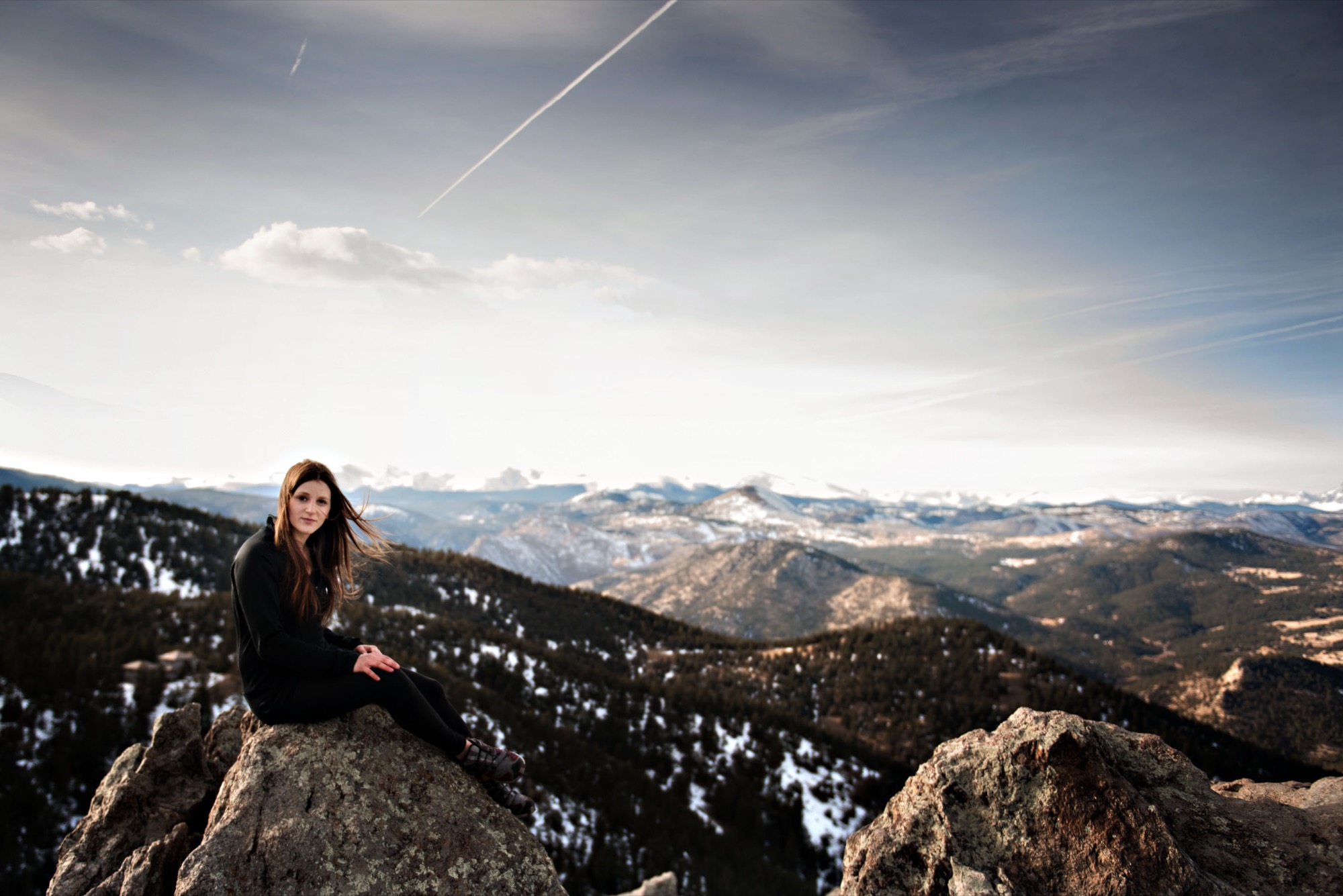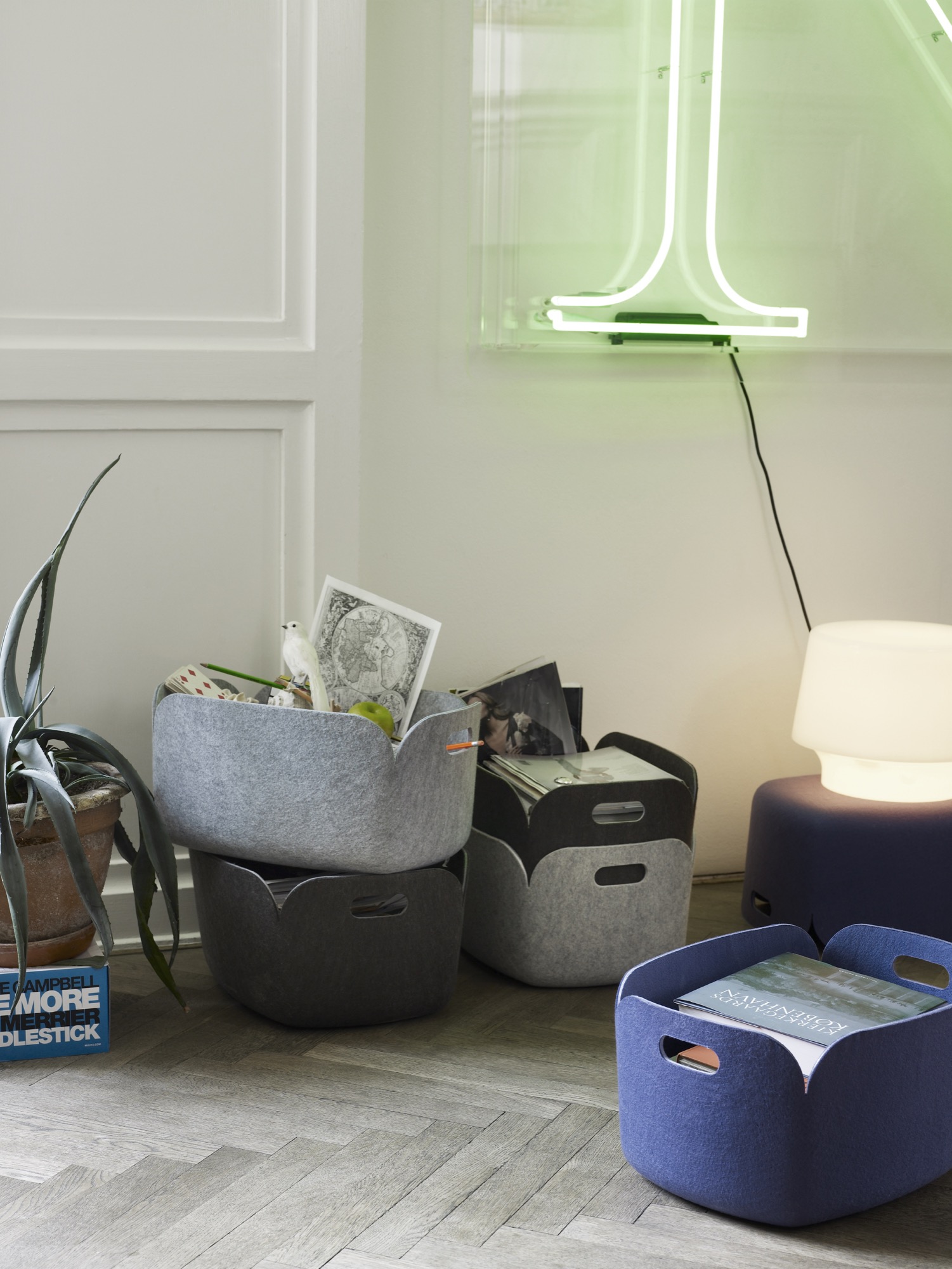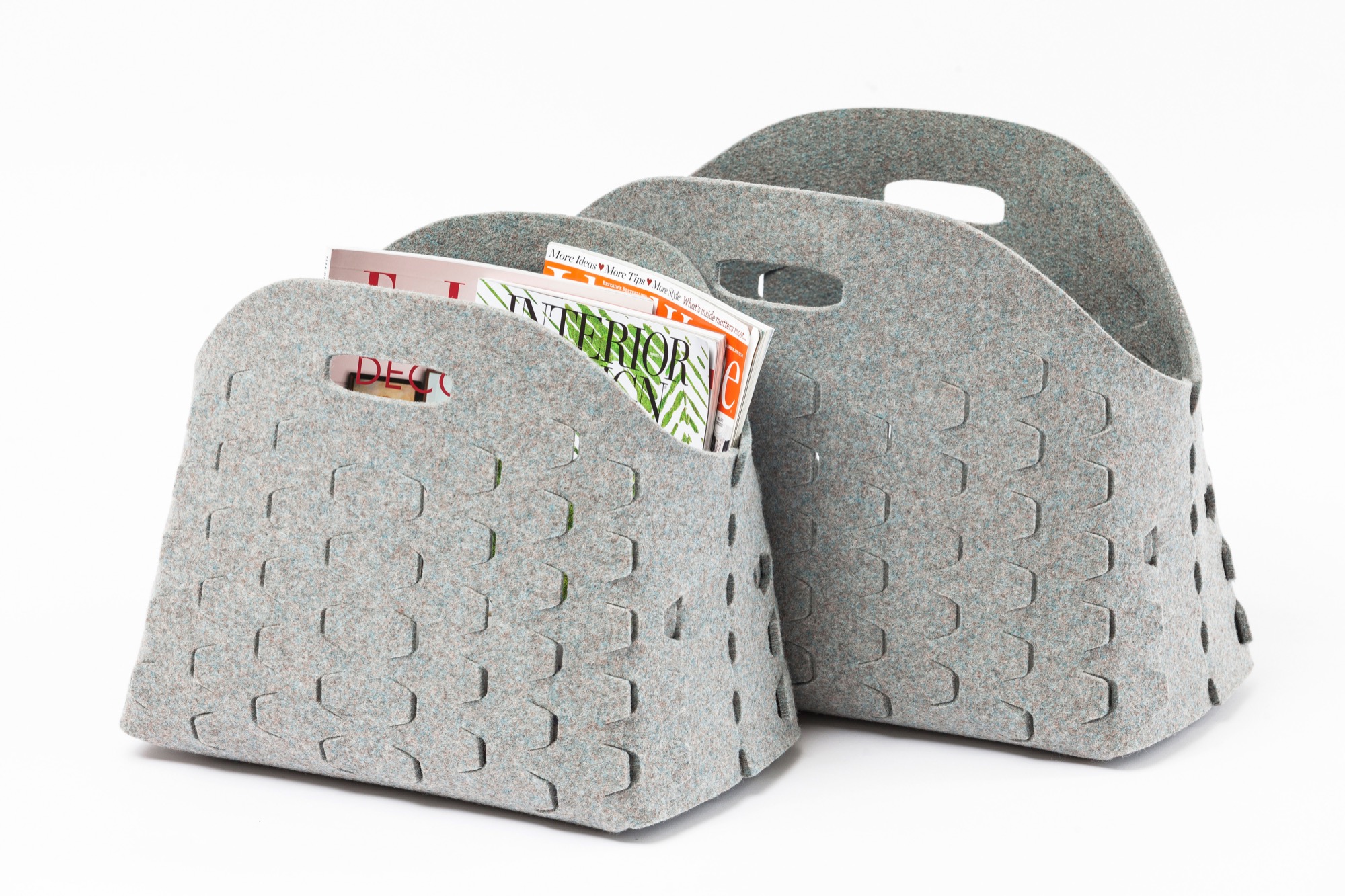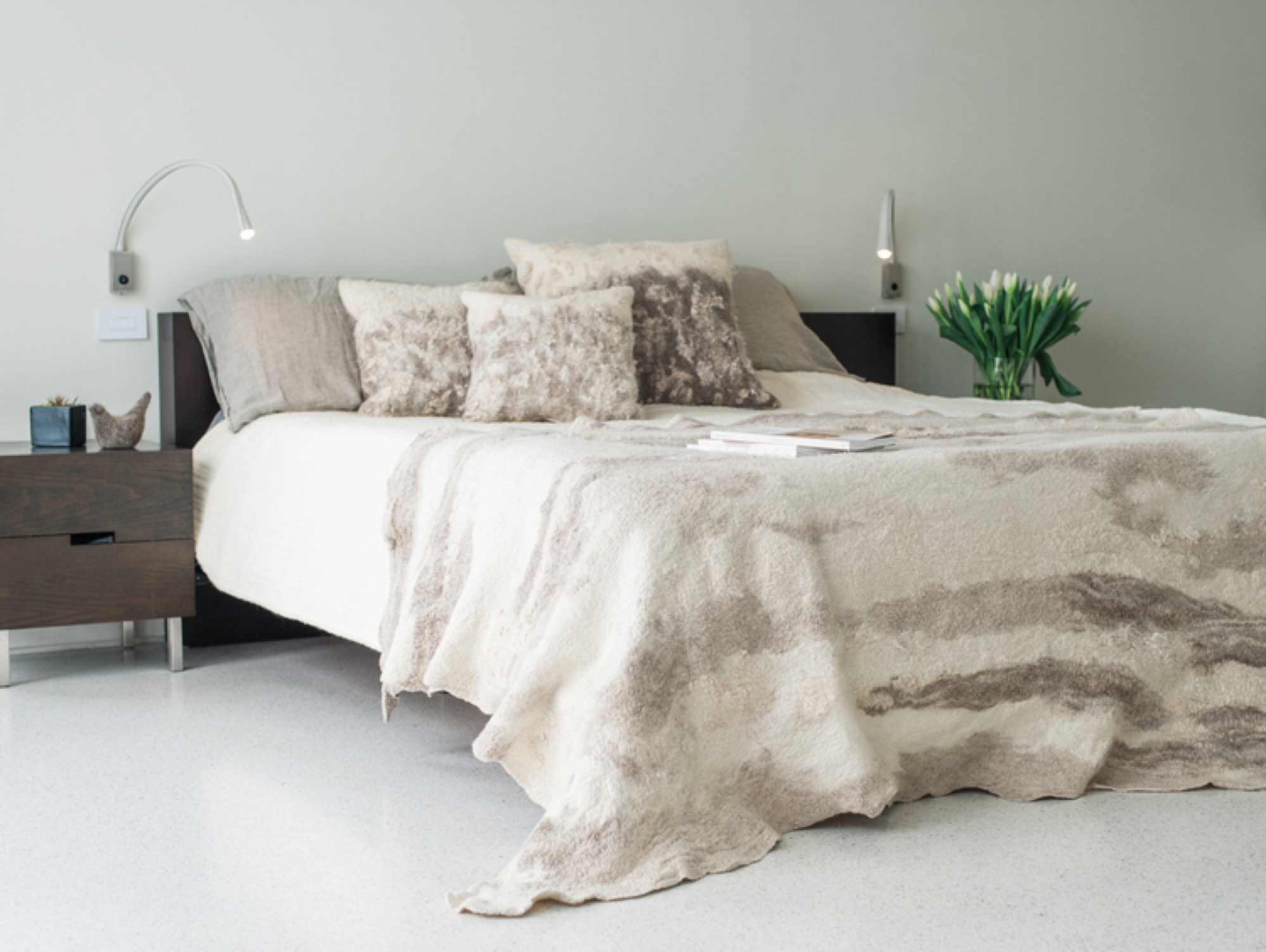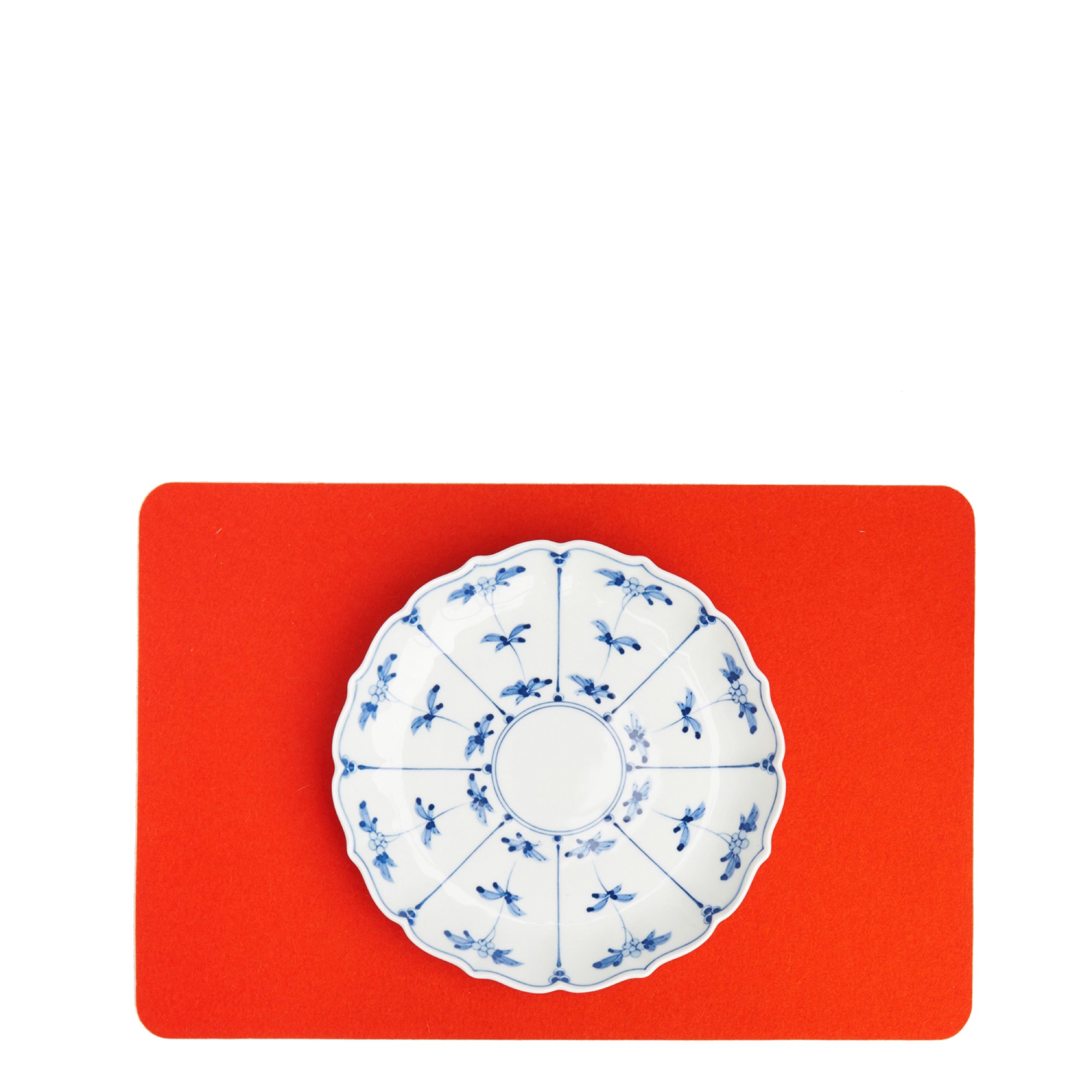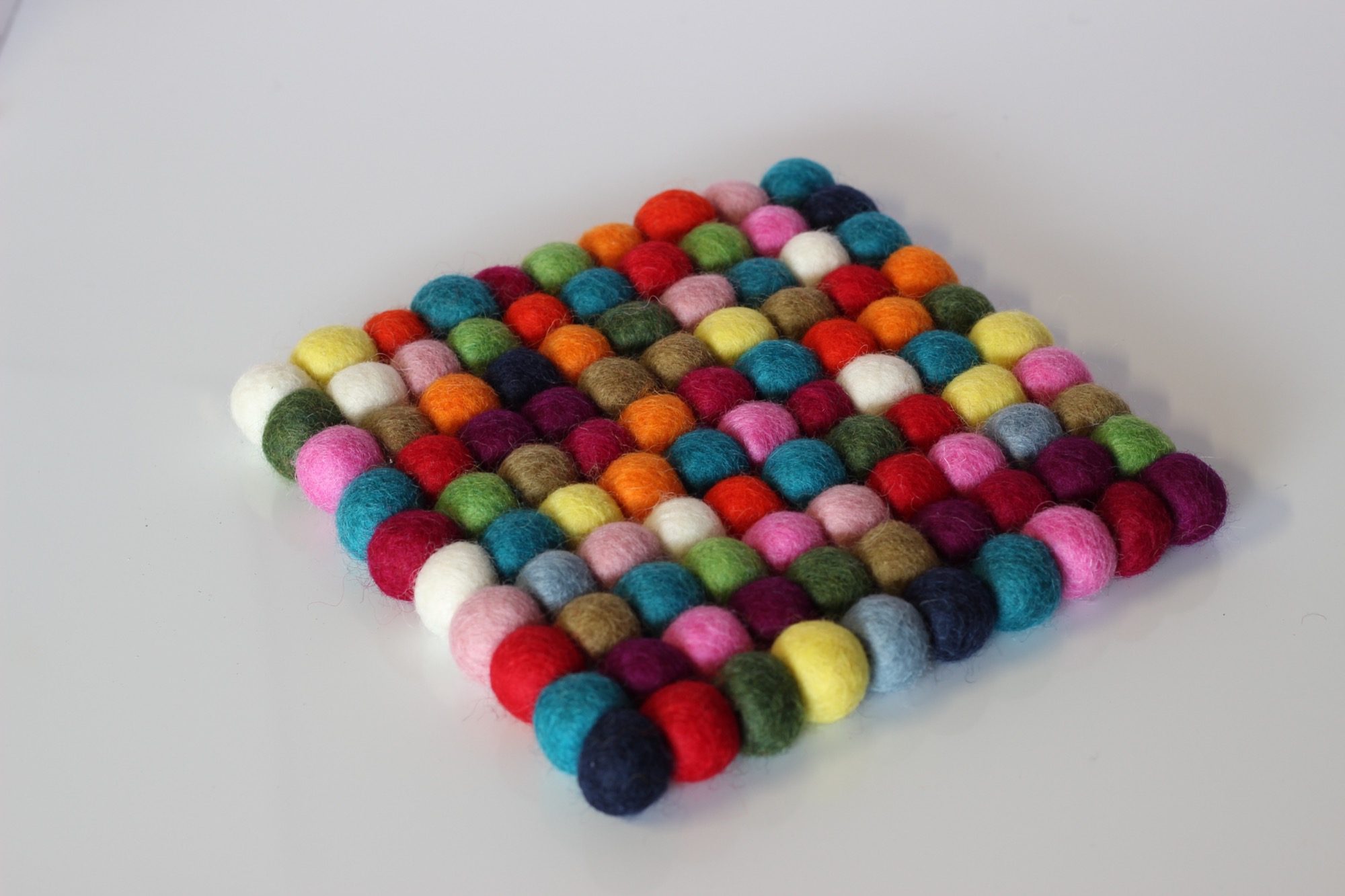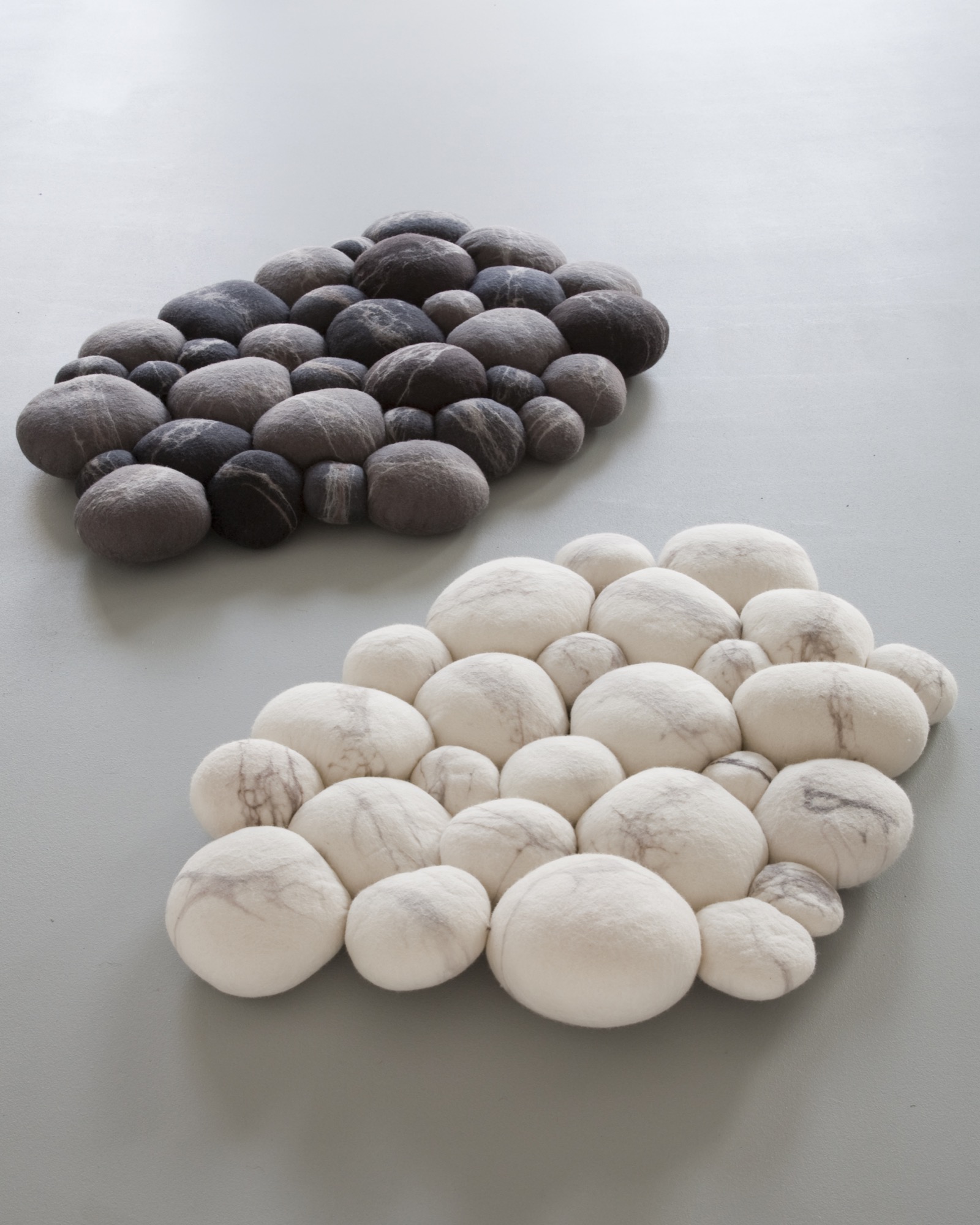
Inspirations
Explore the elevated life in the mountains. This content debuted in 2015 with Alpine Modern’s printed quarterly magazine project.
Inspirations No. 14
In this article… blah, blah, blah.
Hope you're enjoying a relaxing Saturday. We're getting bundled up and about to head down to the Cafe for waffles with our guests visiting from California. There's nothing like sugary waffles and warm coffee to kick off a weekend with friends. We're so thankful for the success of Alpine Modern Cafe and the amazing staff that wake up every morning to serve our neighborhood and the wide-eyed visitors from around the globe. It's demanding, being in the service industry, but occasionally our drained egos are refilled by a thoughtful online review, a sincere thank you, or, in this case, a spot at the top of a well-regarded list. Alpine Modern Cafe was highlighted, along with Intelligentsia, as the best place to get coffee in the USA from the Financial Times newspaper. We learned about this on Friday when we had an unusual number of Englanders visiting the Cafe, all snapping photos for their Instagram accounts. So cool! Well done, everyone! Here are some inspirations to keep you busy this morning:
Finally, someone designed a television for the modern home. The Samsung Serif is a work of art.
Coco has become an Instagram icon. She lives in Japan and she is only six years old.
This online illustrated guide to Frank Lloyd Wright's signature buildings.
This new game from our friend, Matt Sisson, called Ravine. We’ll be carrying it in our Shop once it’s ready but if you want to support Matt and receive an early copy, back him on Kickstarter.
Mr Porter curated a wonderful list of retreats. What’s more luxurious than a retreat in the middle of nowhere?
Chasen + Stone Matcha made this video about the cultivation and production of it matcha. This small farm in Japan supplies all the matcha for our Cafe and Coffee Bar.
Desktop cold brew coffee system by Bruer.
Two alpine-modern architects in Colorado worth noting: Studio-B and tres birds workshop
Loving these new Reebok × Barneys New York suede shoes.
Our Canadian friends at Wise sent us samples of their hair care products. We’ve been using the shampoo for the last two weeks. It smells splendid and the packaging design...it's oh so nice.
This home in Northern California is worth the click.
Scandinavia Trip Itinerary
When fall comes each year we find ourselves cleaning house, organizing, downsizing, and taking stock of the beautiful sunny memories of summer. As the kids nap peacefully this afternoon, we're snuggled on the couch watching the last of the orange and yellow leaves of cottonwoods drift quietly in the backyard. We're taking this window of opportunity to send a special inspirations email today about our summer vacation to Scandinavia. Along with our two kids, we explored Denmark, Sweden, and Norway for three full weeks in July. There are plenty of luxury-focused travel guides like Monocle, CITYX, and the Michelin Nordic Guide that are excellent resources, but we wanted to share with you some of our favorite places from the trip. Many of these links will go to our website where we have included pictures and more details about our experiences:
Denmark
When we began our trip we planned a few days of doing nothing so that we could adjust to the time zone and enter vacation-mode. We rented an Airbnb home in Hellerup (just North of Copenhagen). The home is located in a quiet neighborhood which was a perfect setting to help us get settled. Bonus, the house had a trampoline. We cooked meals, explored the town, and let the kids run loose at the most amazing children's museum, the Experimentarium.
Arne Jacobsen's iconic Station Wall Clock seemed to be everywhere we went in Denmark, including hanging in the Airbnb house. We purchased one for our home in Boulder to remind us of our trip and the importance of timeless design.
You must go to the Louisiana Art Museum. The art is very good but the architecture of the building is what really stands out.
When in Copenhagen, eat lunch at Copenhagen Street Food, specifically try Tacos Chucho. Get afternoon coffee and cake at 108 Restaurant and also go there for dinner. Stay at the D'Angleterre hotel and make sure to experience the spa and pool. You'll certainly see Tivoli Gardens and when you do, eat at Gemyse and try to get a seat inside the greenhouse. Great coffee at the four locations of Coffee Collective.
Sweden
When in Stockholm, have lunch at Oaxen Slip. Go to the Vasa Museum. Stay at the Grand Hotel and eat at chef Mathia Dahlgren's Rutabaga. Take a day boat to Vaxholmarchipelago and have lunch. Visit the old town of Stockholm, Gamla Stan, and make sure to buy candy at Polkagris Kokeri. Eat pizza dinner at Tutto Bello. For a quick lunch go to Kalf & Hansen and then get a coffee at nearby Drop Coffee.
In the unassuming town of Växjö, Sweden there is a beautiful hotel and restaurant, PM & Vänner. If you're traveling with children, you'll also want to spend an afternoon at the local park and playground, Linnéparken.
We had the opportunity to meet with the renowned designer, Pia Wallen, in her magnificent Stockholm design studio/home. Pia is the designer of the iconic, Cross Blanket, which we sell at our Shop in Boulder and that is part of the Swedish design museum. We wrote a more in-depth piece about Pia, here.
We discovered a Swedish architect worth noting, Jonas Lindvall, while staying at the PM & Vänner hotel, which he designed. His body of work is incredibly beautiful, modern, and considered. We especially like his furniture collections such as the Miss Holly Chair and Table.
Norway
We stayed at a nice and centrally located Airbnb in Oslo, Norway.
When in Oslo visit the Oslo Opera House to experience the architectural marvel that it is. This might seem odd, but there is a very good Chinese restaurant in Oslo that's worth eating, it's called Dinner. Go to the Vigeland sculpture park. Best coffee we had on our entire trip was at Tim Wendelboe. Eat at Smalhans.
If you make your way to Norway you'll undoubtedly explore the fjords. We stayed in a picturesque modern cottage in Aurland called 2|92 Aurland. Yes, that is a real a waterfall in the background...it was one of a dozen that surrounds you in the Aurland valley. Absolutely magnificent. Get to Aurland by train from Oslo to Flåm then take the breathtaking one-hour, Flåm Railway to the start of the fjord. From Aurland, take the five-hour Norled boat ride through the fjords to the ocean and end up in Bergen.
When in Bergen we couldn't find anywhere remarkable to stay but so long as you're near the town center, you'll be fine. Eat at Lyscerket and also at Bare Vestland.
Scandinavia is a remarkable part of the world. The people are kind, beautiful, progressive, and reserved. These values inspire us in our endeavors with Alpine Modern and in raising our family. It was a transformative trip for us and we hope that you get the opportunity to travel to that magical North. And if you do, please share with us your experiences.
Pia Wallen Stockholm Design Studio
We had the opportunity to meet with the renowned designer, Pia Wallen, in her magnificent Stockholm studio.
29|2 Aurland, Norway
While on our family vacation through Scandinavia this summer we stayed at a magnificent bed and breakfast in the heart of the Norwegian Fjords. 29|2 Aurland is nestled within the Aurland valley. We starting our Fjord journey in Oslo and rode a high-speed train to Flam. We boarded the Flam Railway and traversed down toward the fjords on one of the most magical train rides on earth. The train ends at Myrdal and from there 29|2 Aurland is a short fifteen-minute drive by taxi or hired car.
The staff at 29|2 Aurland prepared breakfast and dinner and also arranged guided hikes, fly fishing, and bike rentals.
Oaxen Slip Restaurant — Stockholm
Our good friend and culinary expert, Colin Kirby, recommended we lunch at Oaxen Slip while visiting Stockholm this summer. The weather was perfectly sunny but even in the middle of summer, there can be a chilled breeze off the water. Fortunately, the restaurant provides cozy wool blankets to keep you warm while you dine. We enjoyed a splendid meal and some of the highlights include smoked shrimp, new potatoes, and fried cod. It's a restaurant not to be missed on your next visit to Stockholm.
Louisiana Art Museum in Denmark
If you must see one museum while in Copenhagen, go to the Louisiana. It's about one hour north of the city and you can get there by bus or taxi. The exhibitions and installations are nice but what truly sets this museum apart is the architecture of the building and its setting on the water. Also of note is the exquisitely curated gift shop (we took copious notes of newly discovered designers for the Shop) and the free kids' artistic studios.

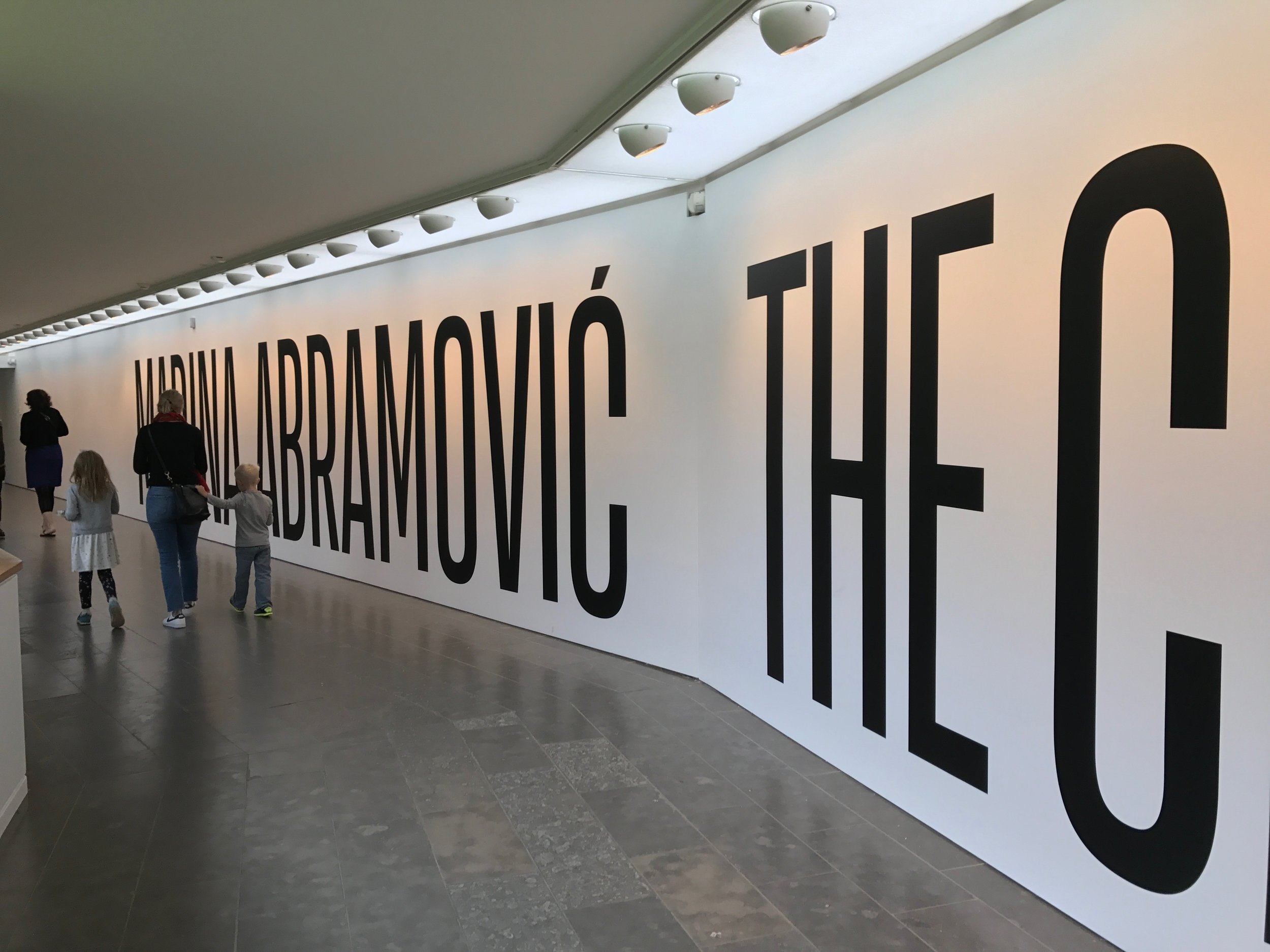
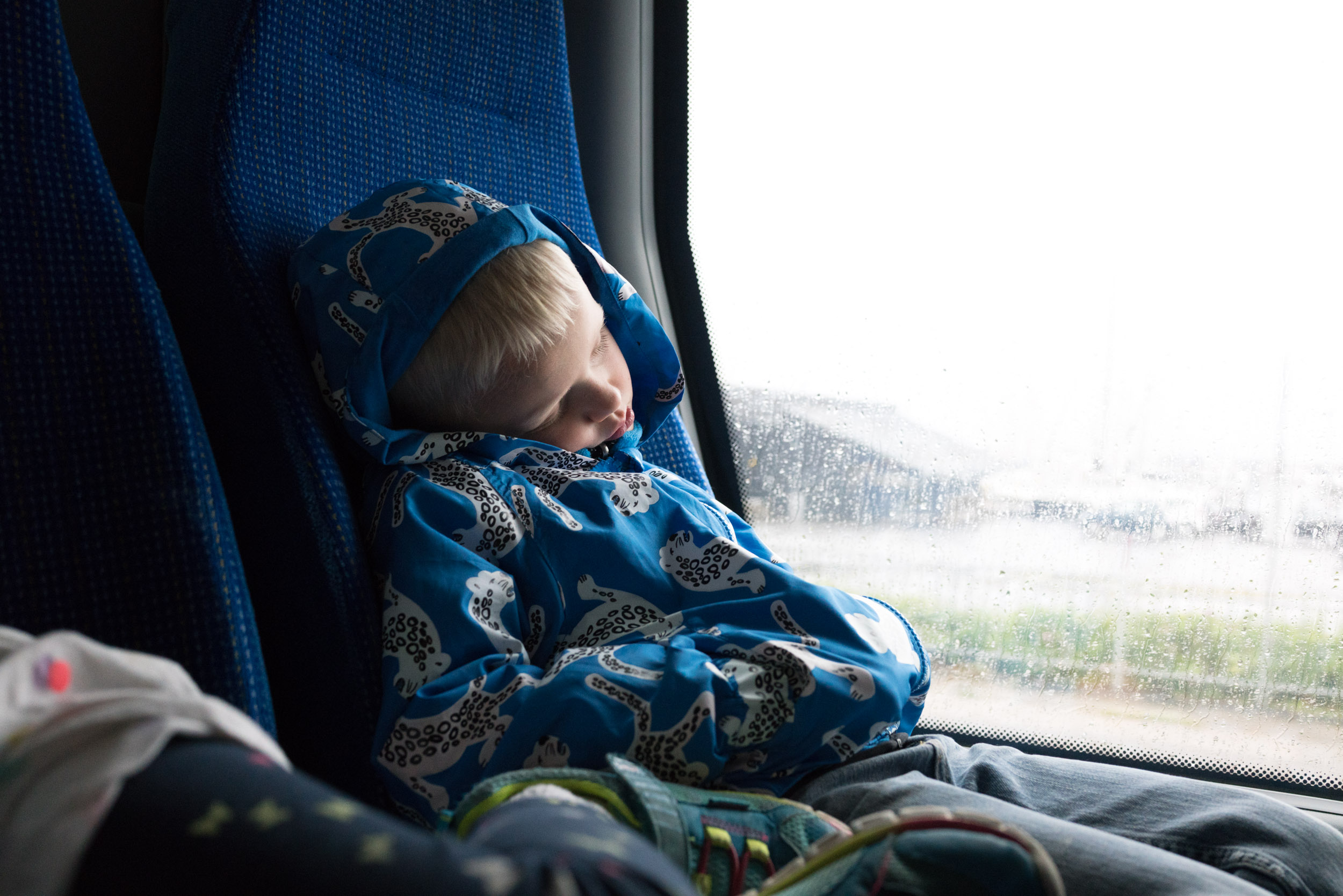
Best Airbnb in Hellerup, Denmark
While traveling through Scandinavia this summer we stayed at the perfect Airbnb in Hellerup, Denmark. It's about 20 minutes North of Copenhagen in a residential neighborhood and just steps to the beach. We were a bit hesitant to stay outside of the city but it turned out to be a great decision. The house was wonderful and even included a trampoline for our kids...which was a welcome activity after eighteen hours of travel! Jes is the owner and was the perfect host. You can view and book the home on Airbnb.
The featured picture above is of the dining room after our first dinner at the house. Notice the Arne Jacobsen wall clock? Love this place.
Miss Holly Chair
Yes, another favorite from Jonas Lindvall, our favorite Swedish architect. We saw this chair in small shop in Hellerup, Denmark Description of the chair from Stolab, which licensed the design and manufactures it:
Miss Holly was produced with respect for the past and a feel for what is lacking today. Jonas has gained inspiration from Windsor chairs from all over the world and has created his very own version with a two-dimensional feel. Gracious and generous at the same time. A chair that is equally attractive and functional, and whose many details testify to the designer's professional skill and love for wood as a material. Miss Holly is equally attractive alone or in a group. Its seating height is suitable for most dining tables.
Check it out on the Stolab website. We are seriously considering ordering 10 for our new dining room.
Arne Jacobsen Station Wall Clock
Arne Jacobsen's Station wall clock is an iconic Danish design dating back to 1939. As we toured Copenhagen on our family trip this summer, we couldn't help but fall in love with this clock. The Airbnb that we stayed at in Hellerup had the smallest size hung in the living room. It was the only piece of art adorning the wall—absolute perfection. We don't sell the Arne Jacobsen line but we ended up buying one of the clocks for our home directly from their main website.
Samsung Serif Television
Samsung's newest television, the Serif, opens many possibilities for integration into the modern home. A long time ago, TV's were built like furniture, and it's nice to see the pendulum of design swinging back in this direction. View more information on Samsung's website.
Jonas Lindvall
Jonas Lindvall was educated as an interior architect in Gothenburg, Sweden and studied furniture design at the Royal College of Art in London and architecture at the Royal Academy of Fine Arts, School of Architecture in Copenhagen. Upon completing his studies he returned to his hometown, Malmö, where he opened his own office. As an architect, Jonas has created villas, hotels, restaurants and more recently, church interiors.
We experienced Jonas' work when we visited the PM & Vänner Hotel and Restaurant in Växjö, Sweden this summer. We just love his style!
You can see the full portfolio on his website.
PM & Vänner Hotel and Restaurant
This hidden gem of a hotel is located in Växjö, Sweden. We stayed here in July and fell in love with the design, service, and dining. Architect, Jonas Lindvall, is responsible for the building and interiors. We were so taken by his design that we purchased a book of his work. We booked our hotel reservation directly on their website.
The PM & Vänner Michelin starred restaurant is absolutely worth the trip. Although, while we visited the main dining room was closed for the summer. We ended up eating in the bistro which was spectacular.
Peace Industry
Peace Industry began with a gift. In 1999, Dodd Raissnia bought his friend Melina, a painter and graphic designer fresh out of Chicago Art Institute, a little felt rug that he found in a craft shop in Tehran. When the pair became a couple, they wanted to build a business together. Melina, completely charmed and intrigued by this ancient craft, encouraged Dodd to take her to Iran to find more rugs. Their original idea was to import and sell them. But when they traveled to Tehran in 2001, they discovered there was not an ample supply of felt rugs available. The felting tradition, practiced by nomads for thousands of years, had almost entirely died out. Dodd and Melina decided to try to make their own rugs using Melina’s designs.

Dodd, a native of Tehran, found a local artisan who was able to produce Melina’s rug. This first piece was so well received that the couple was encouraged to go forward with their venture. Ultimately, Melina and Dodd outfitted a factory in Iran. They wanted to both expand and control the quality of the rug production. They began training local workers in the nearly lost art of producing felt rugs.
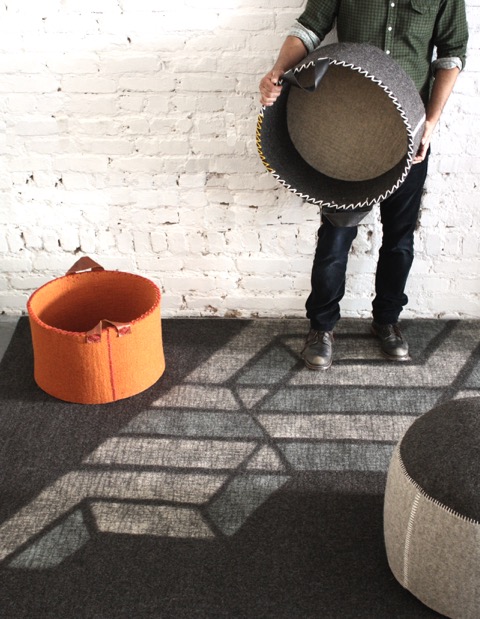
Through trial and error, constant research and innovation, Melina and Dodd arrived at a process that generated a durable, hard felt of high quality. Peace Industry rugs are made from carpet-grade lamb’s wool, which is plentiful in Iran. Dodd and Melina use a wool that is both tactilely appealing and wears well.
I spoke with Melina and Dodd in their Peace Industry showroom in San Francisco’s Mission District. Walking in, I was completely taken by the warm, engaging rugs with simple, modern designs. Melina’s shapes feel organic and natural, but also very clean. I was also taken with Melina and Dodd. Melina has wavy, dark brown hair and a big, magnetic smile. She frequently let out a deep, kind, outrageous laugh while sharing the story of Peace Industry with me. Dodd, tall and elegant, interjected and clarified periodically. They have been working and creating together for nearly twenty years and the comfort and ease between them is apparent.
AM Can you explain the felt making process?
MR In order to make a felt rug, you need a big floor with a drain and a large woven mat called the mother cloth. You arrange carded wool on top of the cloth and press it down with big, wooden forks. Then you sprinkle it with hot water. The rug keeps getting pressed down and walked on until you place another layer on top.

DR The pattern is made upside down. These women (showing me photos of felt makers from a century ago) are felting in the Turkoman region of Iran. They are rolling the rug and using the pressure of their arms to press it down.
MR That’s felting. And it’s still the same process - it’s the weight of people’s bodies.
DR The rug starts out almost twice as large and it is shrunk into the final size. But it doesn’t shrink perfectly. In order to keep the design you want, you have to constantly manipulate it, pull it, beat it, and sculpt it, so you are straightening the edge as it’s shrinking.
MR The edges of our rugs are all hand-rolled.
AM Can you talk about how the rugs are eco-friendly?
MR We don’t use any chemicals in the manufacturing process. We don’t put a backing on the rugs so you don’t need a rug pad. You just lay the rugs right on the floor. The only by-product of the process is dirty, sheepy water.
DR The sheep are raised the way they have been for thousands of years. They are mountain grazed and grass fed. We buy local wool directly from the shepherds.
MR It is all from neighboring villages within a 100-mile radius from the workshop.
AM How do you create the colors?
MR We use all the natural wool colors and we also blend them to create new colors. The fog (colorway) is white wool with a little bit of black. For the non-neutral colors, we dye the white wool.
AM Where do you get your design inspiration?
MR From my own work as a painter. I also draw inspiration from other textile designers and multidisciplinary artists. Ray Eames is a really big influence on me.
AM Can you tell me about the name Peace Industry?
MR Before we got into rugs, I had a business called Peace Flags out in Point Reyes. I was making screen printed T-shirts and peace flags with the same logo that we have now. The peace flags were a response to the Iraq war. It was a lot of fun. We also made really cute baby T-shirts and peace panties and it was paying the bills. Then we got into the rug side of our business and it just exploded. We had to change the name because we decided it’s not just peace flags anymore… it’s more than that. It’s an INDUSTRY. (Melina lets out one of her big, warm laughs.) AM Are you still working towards peace through your business?
MR Our business is normalizing the relationship between the U.S. and Iran in a very small, grassroots way. We run a workshop in Iran employing 30 people. We definitely intend to expand on that by doing collaborations with artists in Iran. That’s the best way for us to use our talents. I believe that developing personal relationships and friendships builds resilience and understanding that we all share one planet.
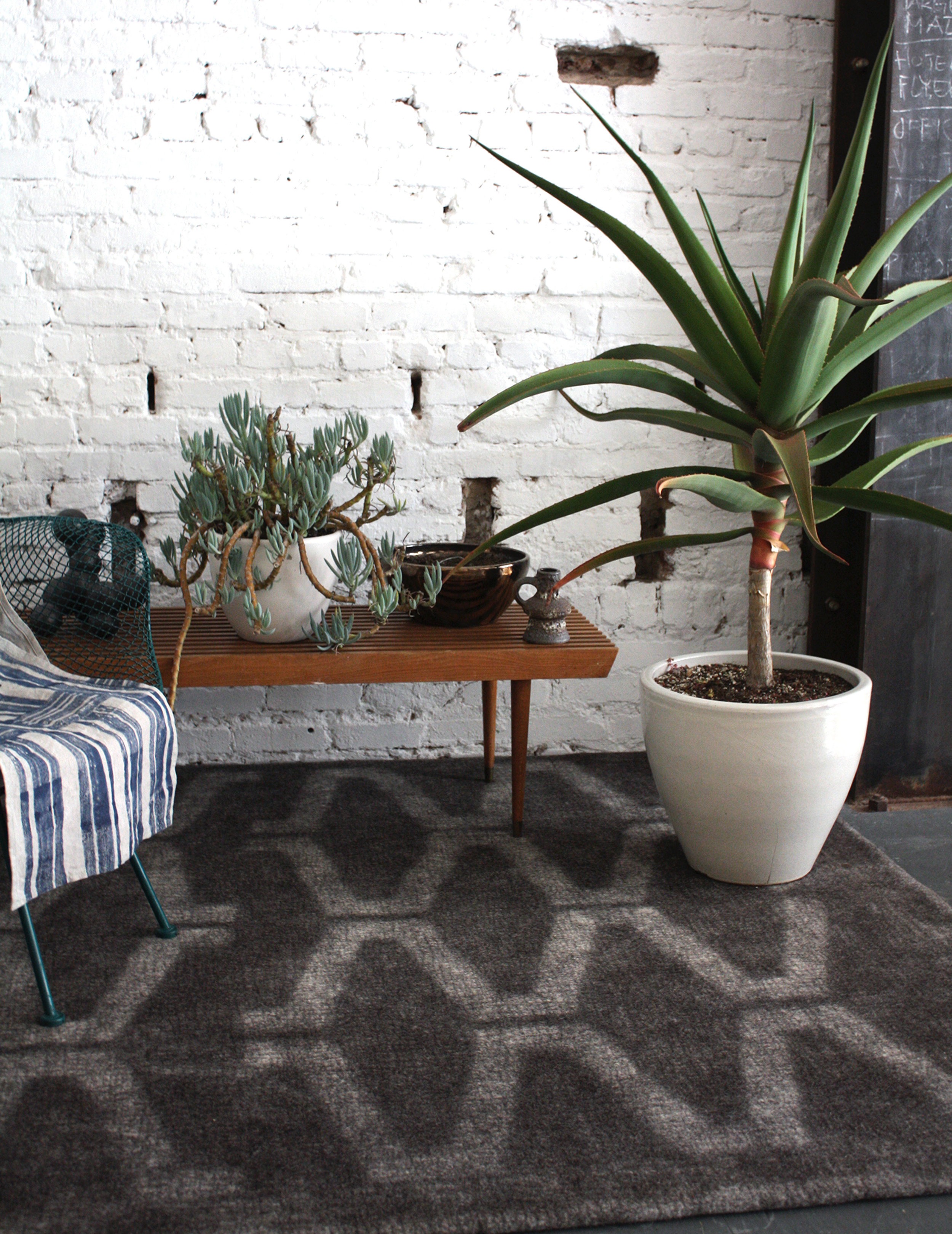
Home Accessories in Felt
So touchable! Modern pillows, baskets and rugs made from wool and other warm materials.
The archaeologists who liberated the city of Pompeii from the layers of ash preserving it made the fascinating discovery of several felt shops. The ancient Pompeiian felt merchants specialized in wearable pieces like hats, gloves, cloaks and blouses. There are murals depicting the felters at work, kneading the rolls of wool on a low table. The vats present in the work spaces indicate that they also developed a process for dying the felted wool various color ways. While these felters and their shops remain forever frozen in the moment that Mount Vesuvius erupted, felt as a textile has endured. Today, felt is available in a multitude of colors and has enjoyed special status as a favorite craft material. Used for Halloween costumes, elementary school stage sets, holiday decorations, dolly clothes and beginning sewing projects, felt has been a presence in many childhoods. Its woolly texture is tactilely engaging and elicits feelings of comfort and coziness. Felt is now being used as a fabrication for a range of home accessories that add both warmth and appeal to modern spaces.
Felted storage baskets
The following felt baskets offer a winsome means of organizing the modern home and can contain all manner of living room paraphernalia: books, magazines, blankets, extra cushions or firewood.
Muuto’s tidy, molded Restore baskets have rounded, crisp, die-cut edges.
The Korb Tote from Graf Lantz is constructed from felt flexible enough that the leather handles may be folded down for a lower profile or left upright for use as a carrier bag.
Tamar Nix of boodo creates felt storage baskets with an even, geometric cut out pattern that looks woven.
Felt accessories for cuddling up
Felt pillows and throws tucked onto a sofa encourage you to nestle in. The Pebble Cushions from Ronel Jordaan look like a collection of soft, variegated stones.
Bludot’s Duck Duck pillows come in a range of cheerful solids with refreshing, contrasted piping.
The felted cushions and blankets from Fog & Fury range from graphic striped and geometric designs to quieter, blurred compositions with raised woolen curls.
Felt in the kitchen
Felt has also made its way into the kitchen. The understated New Form Felt Bread Baskets from Menu are edged in an exposed zigzag stitch. The morning’s baked goods have never looked more tempting.
The simple Wool Felt Placemats from Graf Lantz add cozy, dimension to your table.
Felt Ball Rug Australia offer colorful, fuzzy trivets prepared to host your tea kettle or warm evening casserole.
Felt for the bath
Beyond felt, the Pompeiians of Ancient Rome were also known for their public thermal baths. How they would have enjoyed stepping out of the bathing pools onto Ronel Jordaan’s inviting felted Pebble Bath Mats.
Minimalist Pottery in the Kyoto Mountains
An intimate visit with husband-and-wife pottery artists Momoko and Tetsuya Otani at their home and studio in Japan
The Shinkansen bullet train from Tokyo to Kyoto departs not one minute late, travels almost 200 miles an hour, passes Mount Fuji on the way, and pulls into Kyoto’s vaulting modern station not one minute early. From there it’s 40 kilometers by car to Shigaraki, an industrial mountain town, where I’ve come to visit a ceramic artist whose work has transfixed me on Instagram for the past ten months.
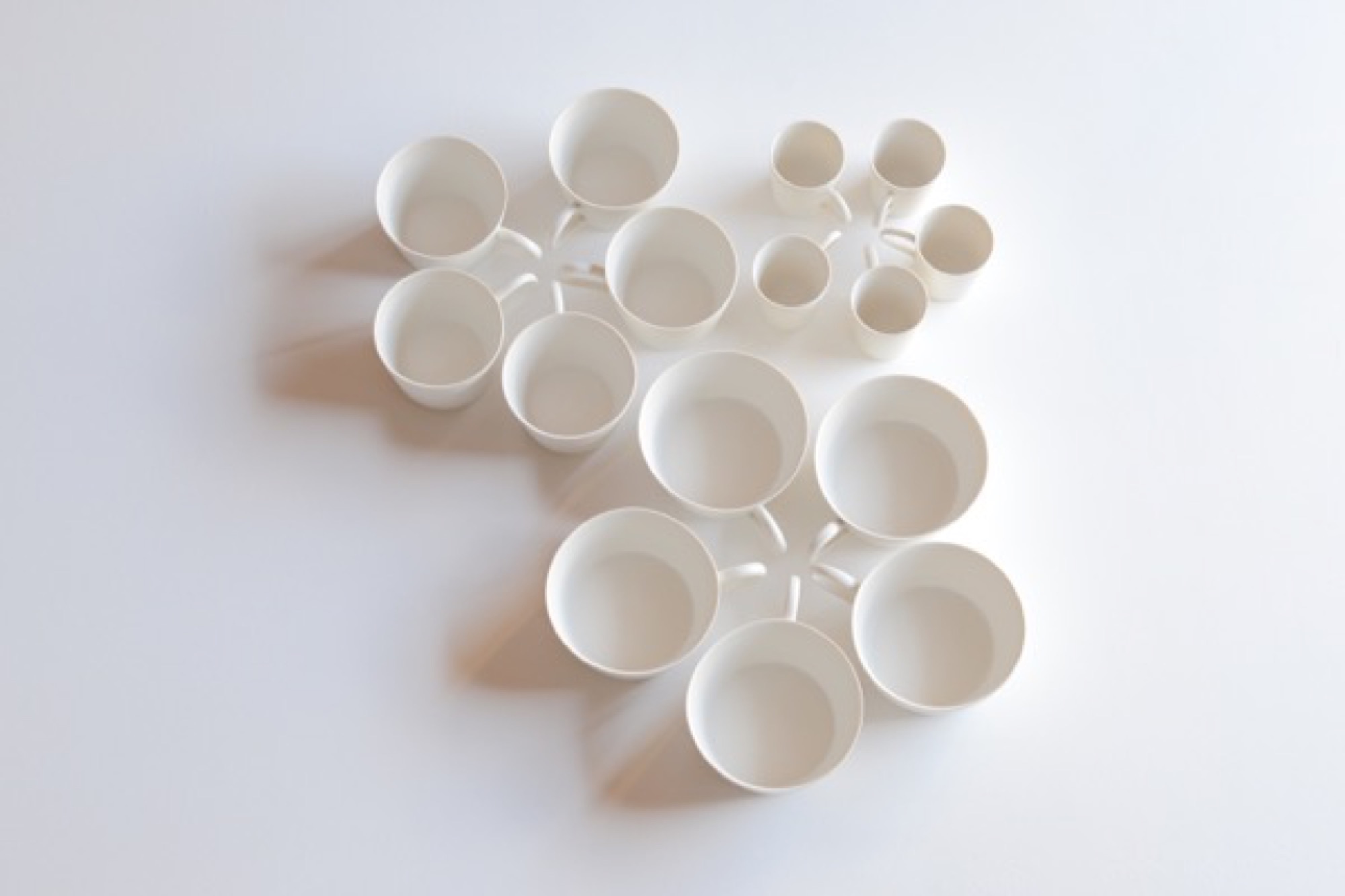
Shigaraki is home to one of Japan’s “six old kilns.” The most admired pottery here—tea bowls and sake cups made from local iron-rich clay—is often misshapen and haphazardly glazed. Much is left to the felicitous violence of earth and fire in wood-fueled kilns. These clay items, used in the exquisitely calibrated tea ceremony, are prized for their imperfections, reflecting the wabi-sabi philosophy in which earthiness, transience, roughness and decay reveal the essential nature of the world.
Such is Japan: hyper-curated, thrillingly modern, clockwork precise—then offering you a tea bowl that seems primeval.

The ceramic artist I’ve come to see, however, is Tetsuya Otani, whose work departs so thoroughly from the Shigaraki style as to seem from another world. Otani’s hand-thrown porcelain chases the precision of machine manufacture. Its skin is smooth and naked, like that of a baby. I wanted to know why he was making such beautiful but plain stuff.
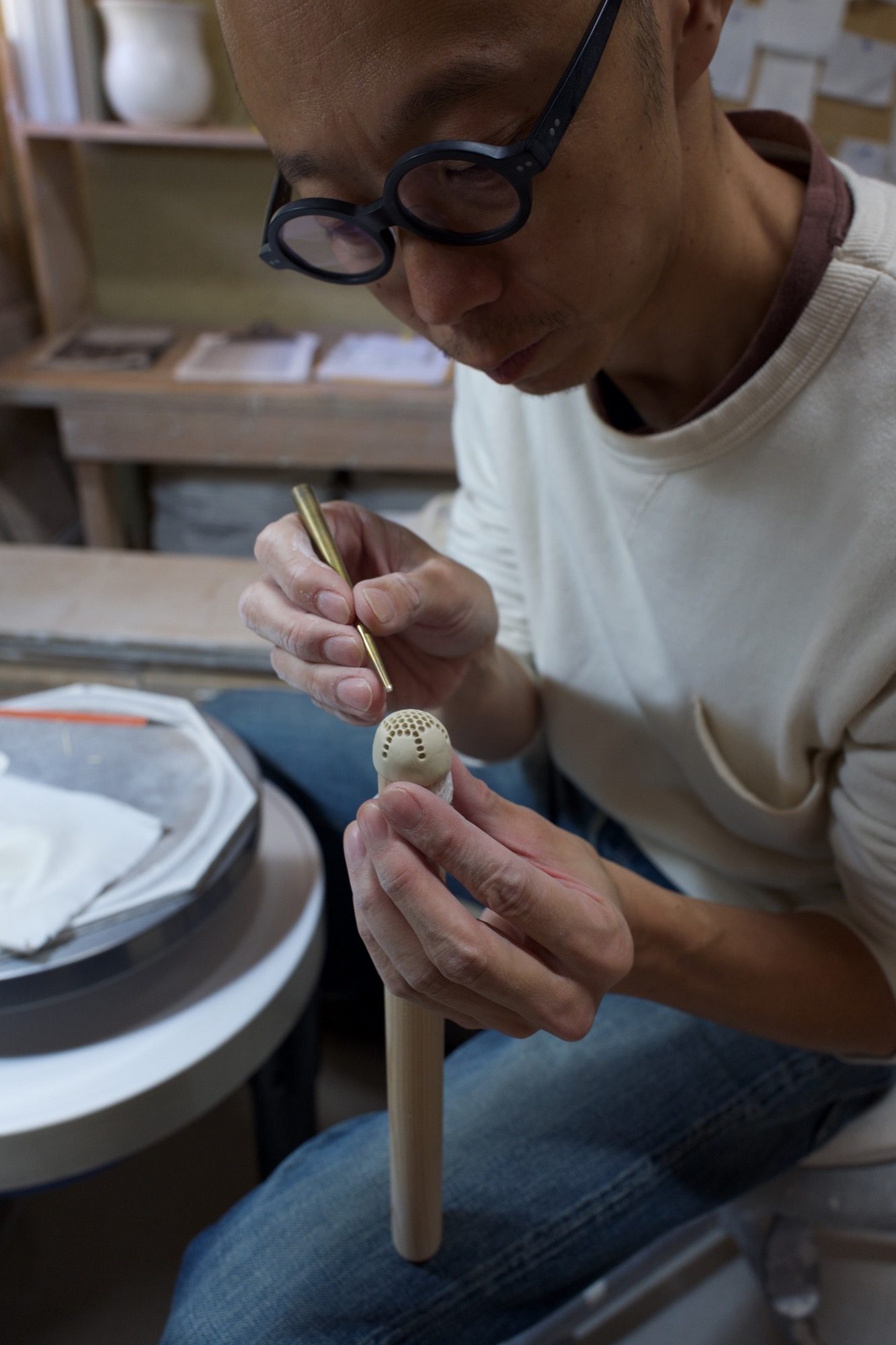
Right now, though, I have a few hours to kill, so I drive into the mountains to find the I.M. Pei-designed Miho Museum. The Miho is a kind of Japanese Getty, opened in 1997. It’s perched on a thick-forested mountain top like something a hermit might build if the hermit had several hundred million dollars. To reach it you walk through a hill via a gleaming, curving science-fiction-y pedestrian tunnel and emerge on a bridge that’s supported by a harp-string array of steel cables. The Miho was commissioned by an industrial-fortune heiress who also made time to found a sect in the 1970s, variously described as an art-centric religion and a sinister cult.
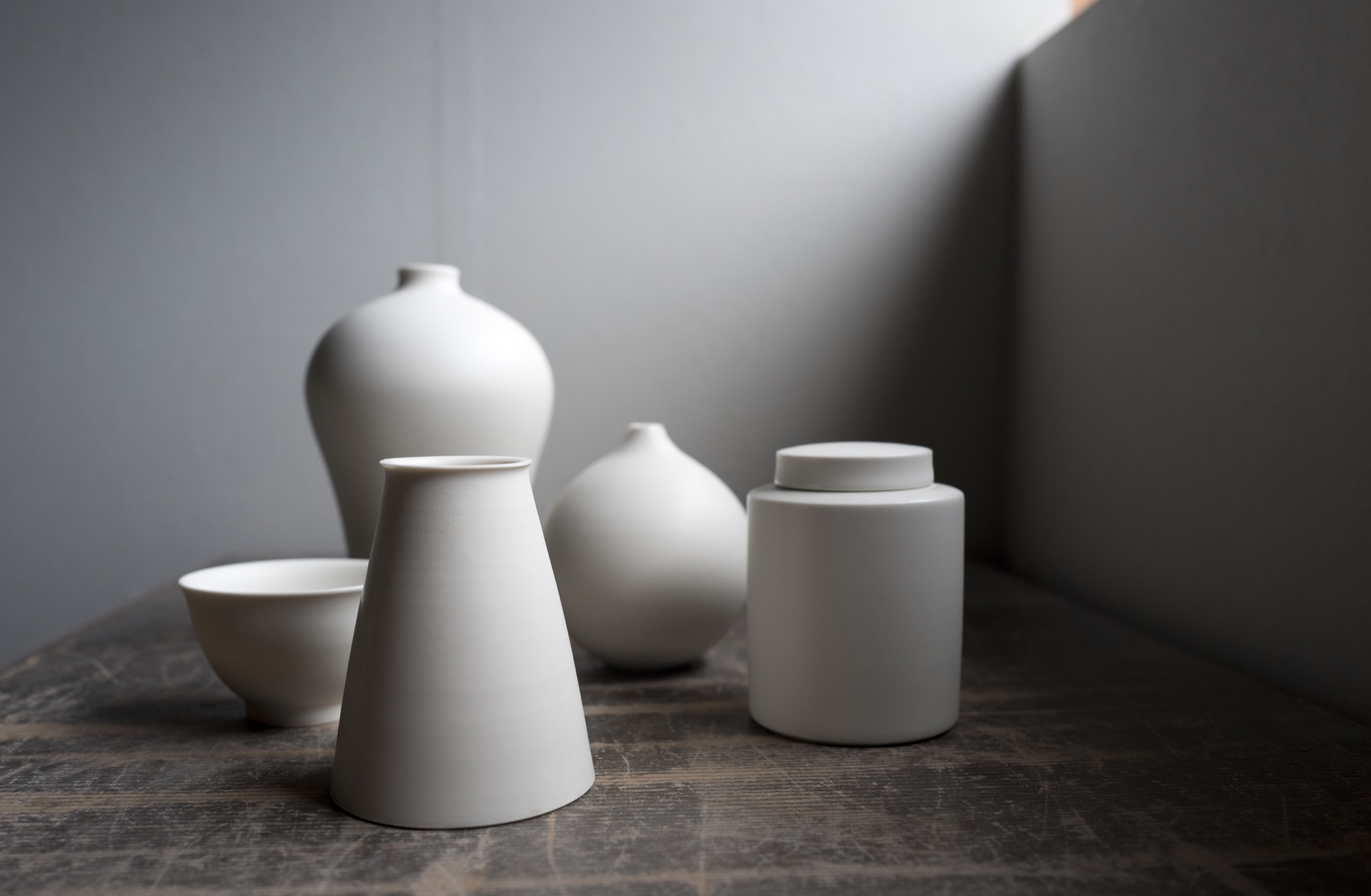
As traveler’s luck would have it, the museum is showing an astounding collection of ceramics by the 18th-century artist Ogata Kenzan, whose name means “northwest mountains.” His painted cups, bowls, and trays leave the viewer giddy, so varied and playful are they in style and form.
At home with Momoko and Tetsuya Otani
Five or so kilometers from the Miho is the home that Tetsuya Otani shares with his wife Momoko—also a gifted ceramic artist—and their three girls and a dog. It’s beautiful, with farmhouse mud walls and high wood beams that employ traditional temple joinery. Everything on the main floor revolves around the kitchen, which is far larger than usual in a Japanese house, reflecting the Otanis’ passion for communal cooking and eating with friends, many of whom also make pottery. The shelves, in the dining area and kitchen, are filled with both Tetsuya’s and Momoko’s pieces.
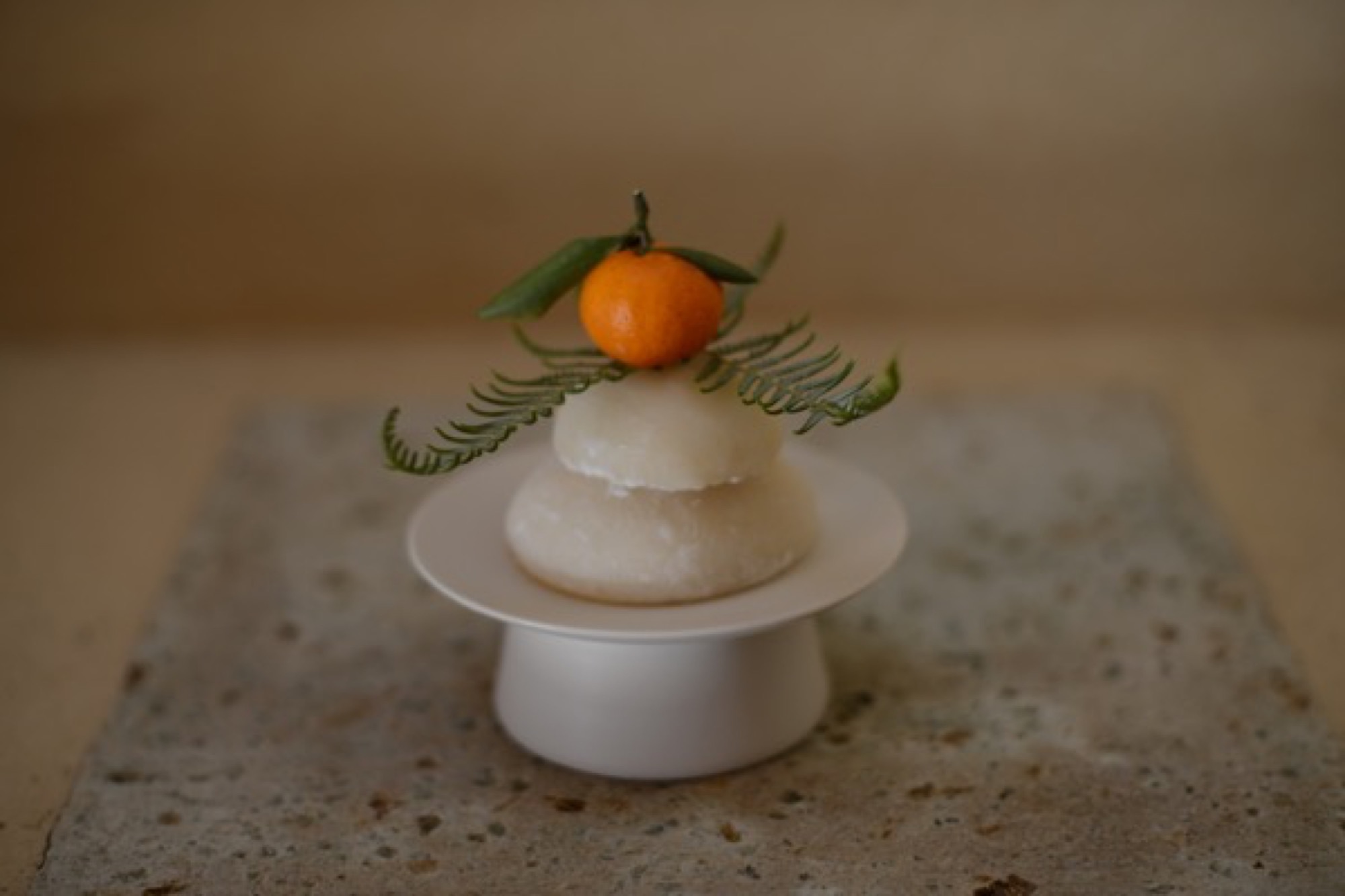
The work of Tetsuya Otani
Lately attracting attention among collectors in Beijing, Shanghai, and Taiwan, Tetsuya shuns both wabi-sabi imperfection and Kenzan decorative exuberance. Everything he makes is to be used, mostly in the kitchen or at the table: tiny matcha urns with clinking lids, curved-belly flower vases, delicately spouted teapots, tiny soy dispensers, little round boxes. The pieces are finely lipped and polished to a supple smoothness; their creamy matte glaze begs to be caressed.
Tetsuya’s pottery has thrown off all temptation toward decoration. The potter’s goal, he says, is to remove as much information as possible from his ceramics, seeking pure functional forms, because “things that work give pleasure.”
"The potter’s goal, he says, is to remove as much information as possible from his ceramics, seeking pure functional forms, because 'things that work give pleasure.' ”
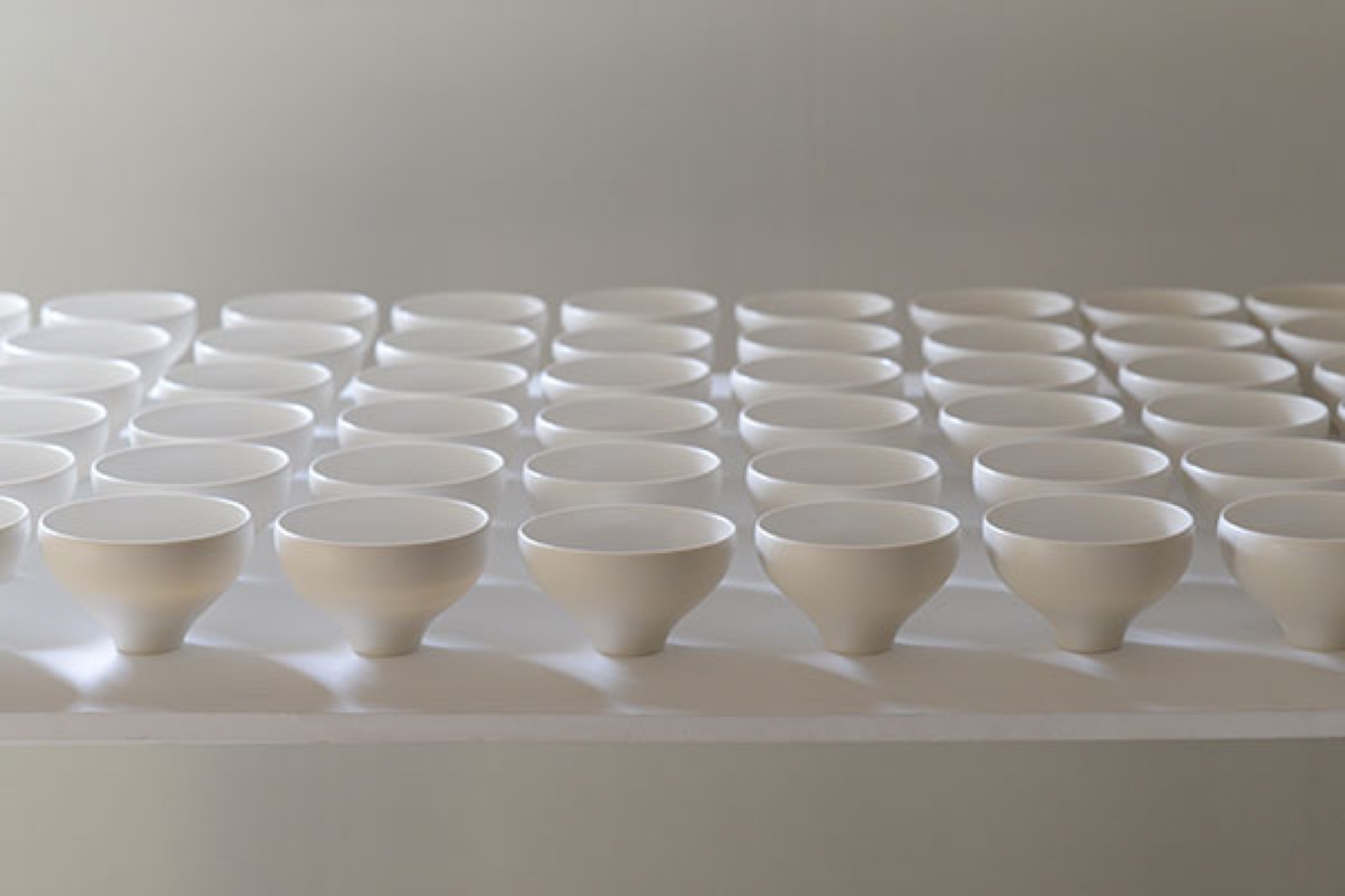
He studied in Kyoto, hoping to design cars, but when the economy skidded in the nineties, he shifted to graphics and ended up teaching product design (“how to make molds”) at the Ceramic Institute in Shigaraki, where he met Momoko and, on the side, learned throwing and glazing clay. By 2008, their house was built and he embarked on a ceramic career. He’s now in his late thirties.
I watch him work in the studio, which has wheels for him and Momoko, as he forms and pokes a bit of clay that will become a tiny strainer inside a teapot. A few feet away, a large machine mixes clay while sucking air from it, then extrudes large, irresistibly smooth noodles of the stuff. The machine is close to the same color as the clay. Tetsuya grins and admits he had it custom-painted to obliterate the standard industrial green. A clue to his fastidious brain.

The pure cup and the pure bowl
Later, we sit at the long kitchen table and look at bowls and cups and teapots and plates and discuss this idea of removing information from one’s work.
“The pure cup,” Tetsuya says, through Momoko’s translating, “and the pure bowl: They can accept anything, become a vessel for anything. Cultural information is eliminated. And then the cup or bowl can be applied to any culture.”
“The pure cup and the pure bowl: They can accept anything, become a vessel for anything. Cultural information is eliminated. And then the cup or bowl can be applied to any culture.”
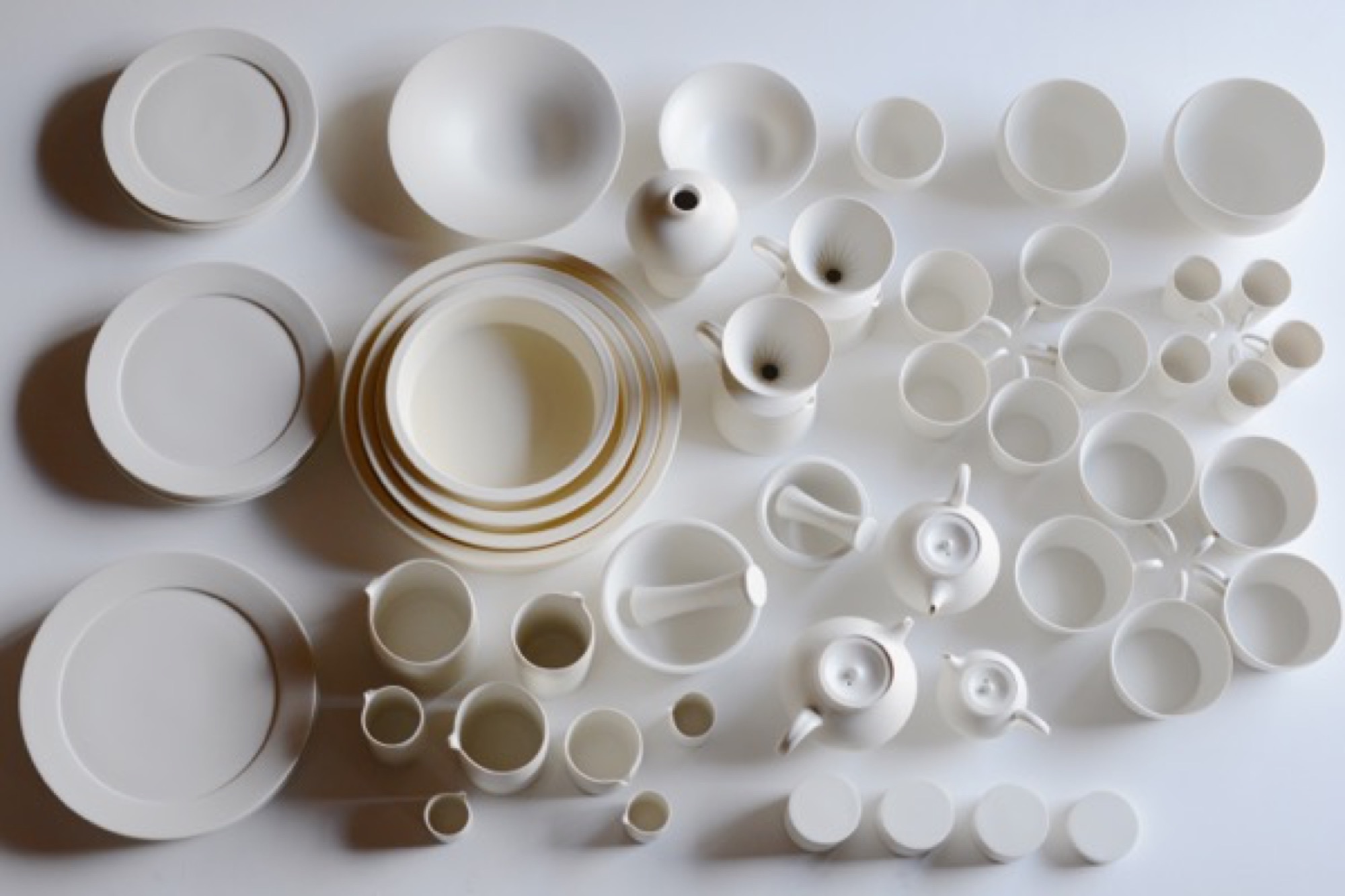
One may begin with the form of a traditional Japanese offering bowl. Decorative motifs are removed until it approaches neutrality. Eventually you “come down to the point where we can use it on our table, not for the gods’ offerings.”
Momoko adds: “Tetsuya strips the bowl of the divine.” He produces smooth dinner plates as blank canvasses for food—altars, really. They’re used in fancy Osaka and Kyoto restaurants to showcase chef art. His works are unsigned, unmarked.
“Tetsuya strips the bowl of the divine.”
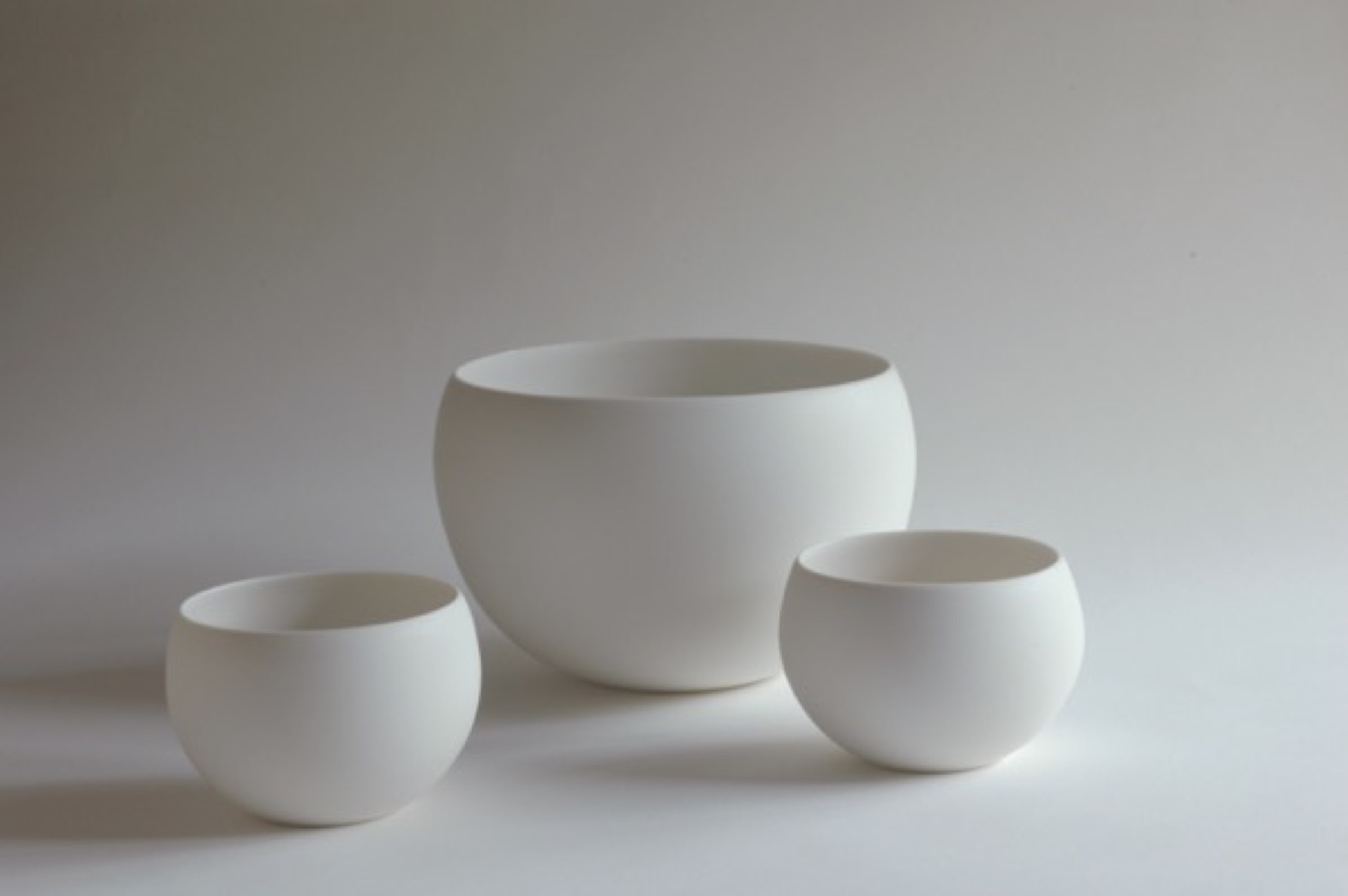
But cultural negation negates a specific culture, and Tetsuya says he has lately realized, when showing his works in China, that they are in some way indelibly, irreducibly Japanese. “I now feel that,” he says, “but I don’t have the answer yet about why I feel that way.”
The potter approaches, but never finds, ideal functionality. Tetsuya tweaks the ancient teacup form a wee bit from batch to batch, always seeking the right feel of cup in hand, the right curve of handle against thumb and finger. This lonely, incremental search for ideal form, endlessly repeated, is itself very Japanese.
The motivation is pleasure, however, not denial. Tetsuya and Momoko are exuberant foodies, and have found that their table-centric philosophy resonates globally through their gorgeous Instagram feeds, @otntty and @otnmmk, with more than 20,000 followers between the two for their pictures of utensils and food.
Tetsuya is also funny. He calls the clay mixing machine Mr. Hiroshira, “my only employee.” What about the beautiful industrial kiln in the next room, I ask? “No,” he says, “I work for it.”
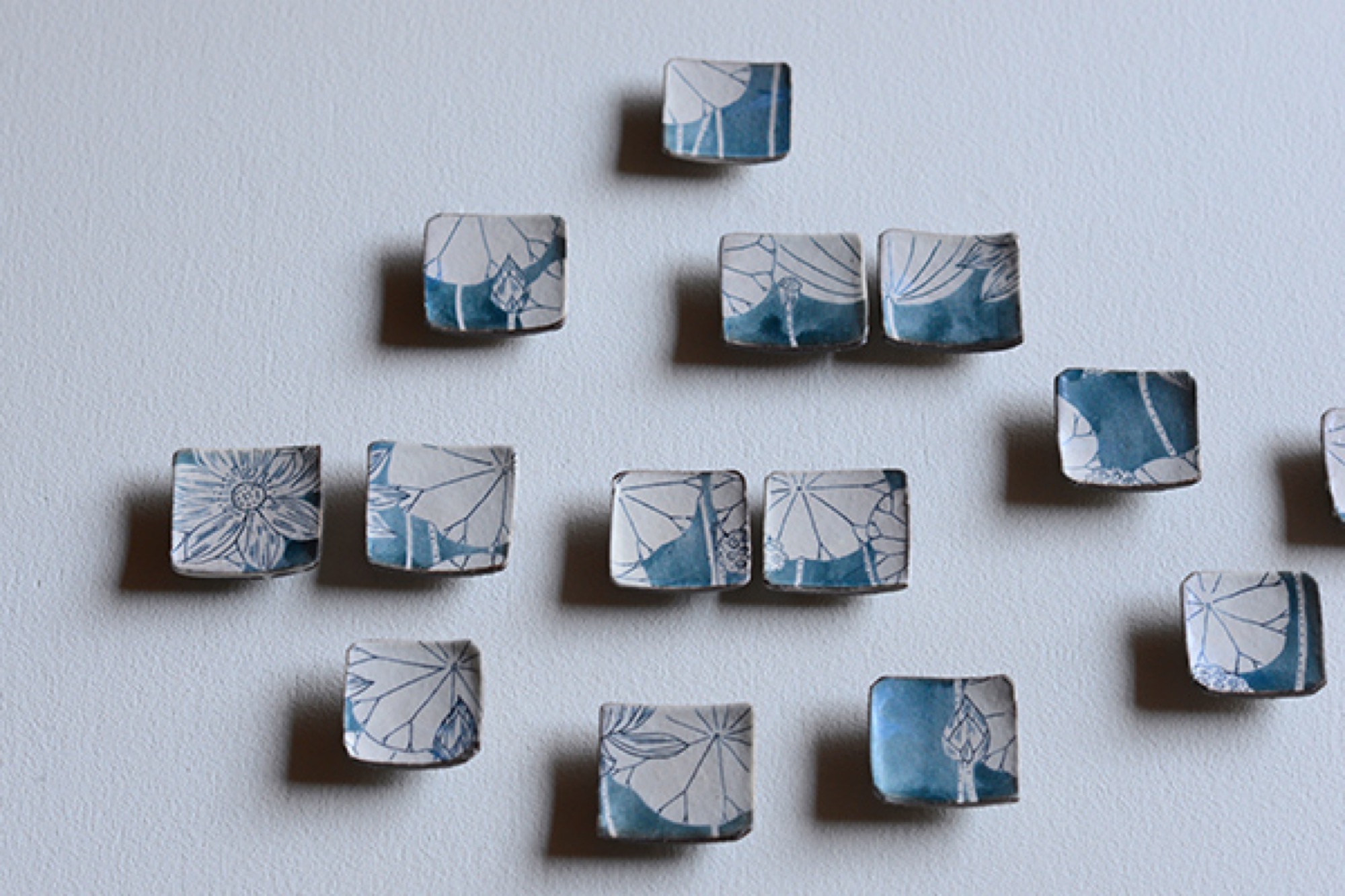
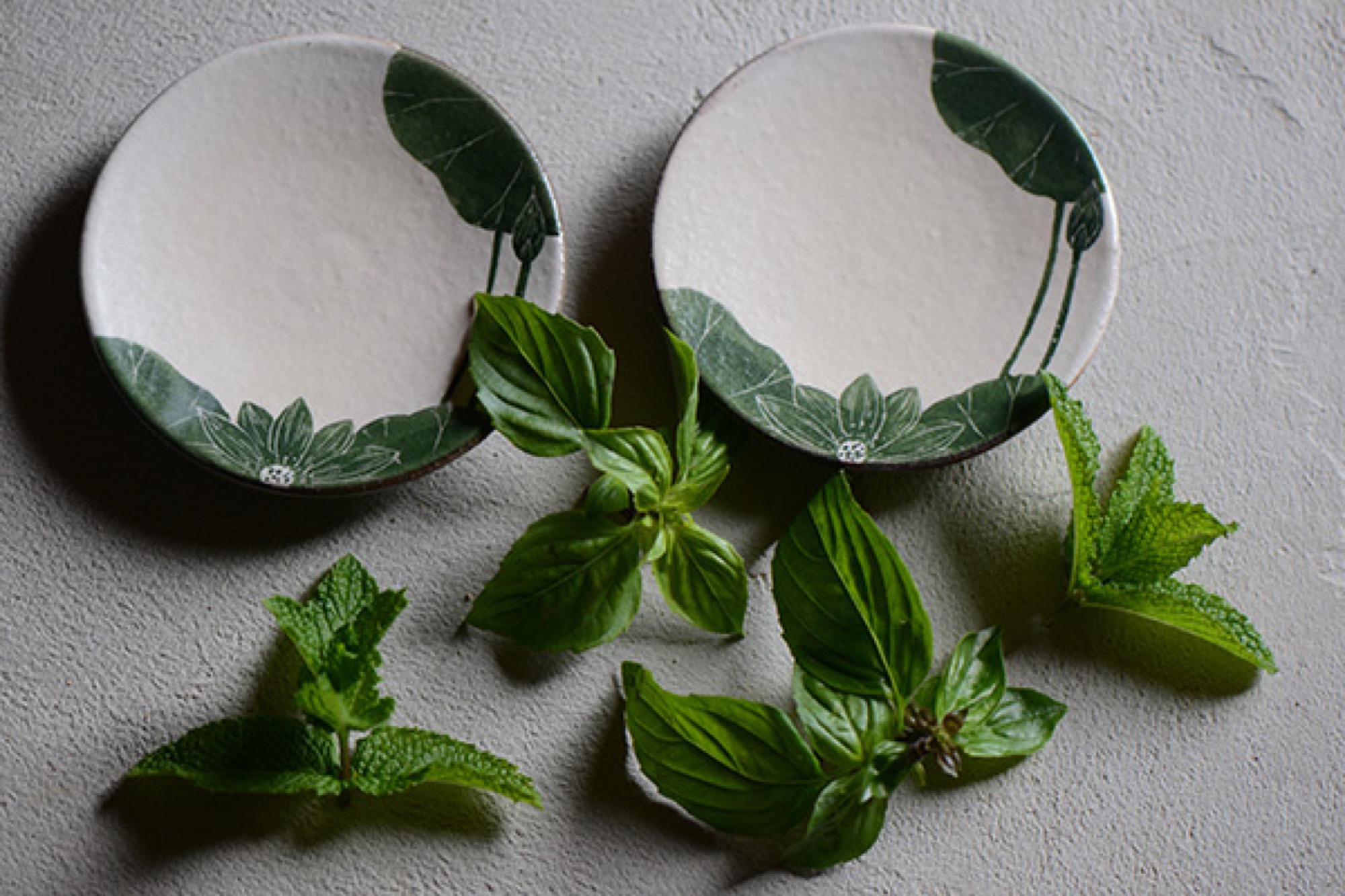
Return to Kyoto
A few nights later, in Kyoto, my wife and I visit a little chocolatier and bakery called Assemblages Kakimoto, near the Imperial Palace. In the minimalist showroom up front I buy a box of orange biscuits enrobed in dark chocolate, each biscuit not much bigger than a postage stamp. Beyond the front space is a narrow, pretty room with a half-dozen seats or so against a counter, facing a tiny kitchen. We order chocolates and cakes and glasses of thirty-year-old palo cortado sherry. Two women to our right—the only other customers in the café—have come for the chef’s omakase dinner. With each course they look gobsmacked, enraptured by the treats placed in front of them. It’s beautiful food, for that is the Kyoto style. Each composition sits on the pale canvass of an Otani plate.
The entanglement of much fuss and no fuss that lies at the heart of many things Japanese is hard to describe, but when I palm one of the Otani pieces that we brought back from Japan, it seems to embody that contradiction. My favorite is a little round vase, the size of a tennis ball, whose satin smooth sides curve up to a sharp-lipped hole that’s big enough to accommodate the stem of a single bud. In weight and delicacy and touch and every other aspect the vase seems, to me, as close to perfect as it can get. It holds a lot of information about Japan. △
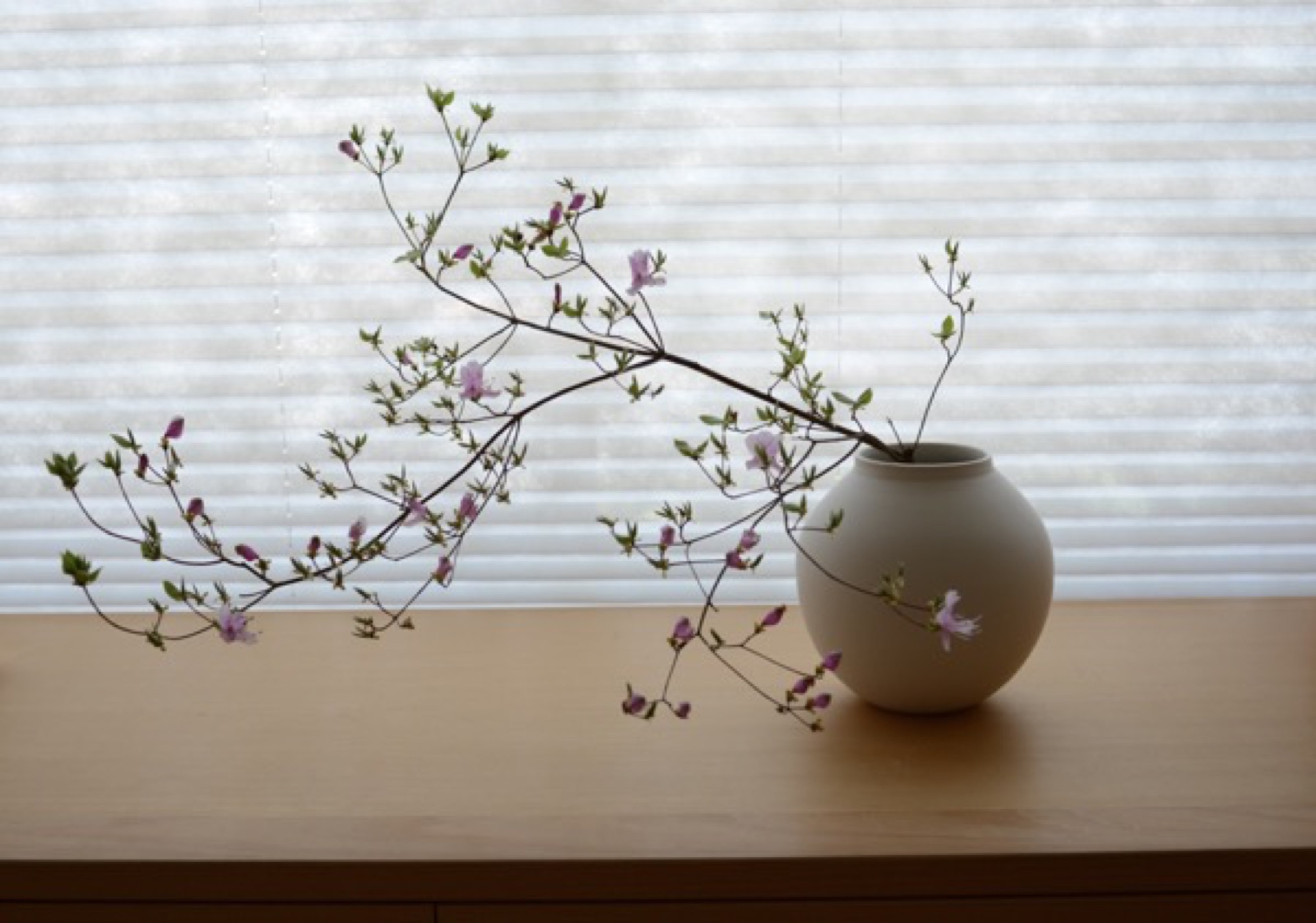
Minimalist Metamorphosis: Cowshed turns cultural center
A local hotelier turns his family's old barn into a beautiful center of cultural life — the Allmeinde — in Lech, Austria
Most people must choose to live amongst urban intellect or natural beauty. Gerold Schneider and Katia Polletin, founders of Allmeinde Commongrounds cultural center, are proof that you can be surrounded by both.

Schneider grew up in the tiny Austrian mountain village of Lech, also known as the cradle of Alpine skiing. His parents owned and operated Almhof, one of the ski town’s top five-star hotels, and his childhood revolved around skiing and helping with the family business. Like many small town kids, Schneider fled the mountains for the city and moved to Vienna to study art, architecture, and philosophy. “A lot of people from rural areas move to cities and get a taste of art, music, design, food, and they never return,” he says. But the sudden death of his father and illness of his older brother drew Schneider—and his architect-wife Polletin—back home to help his mother, Hannelore, run the family hotel.
“A lot of people from rural areas move to cities and get a taste of art, music, design, food, and they never return.”
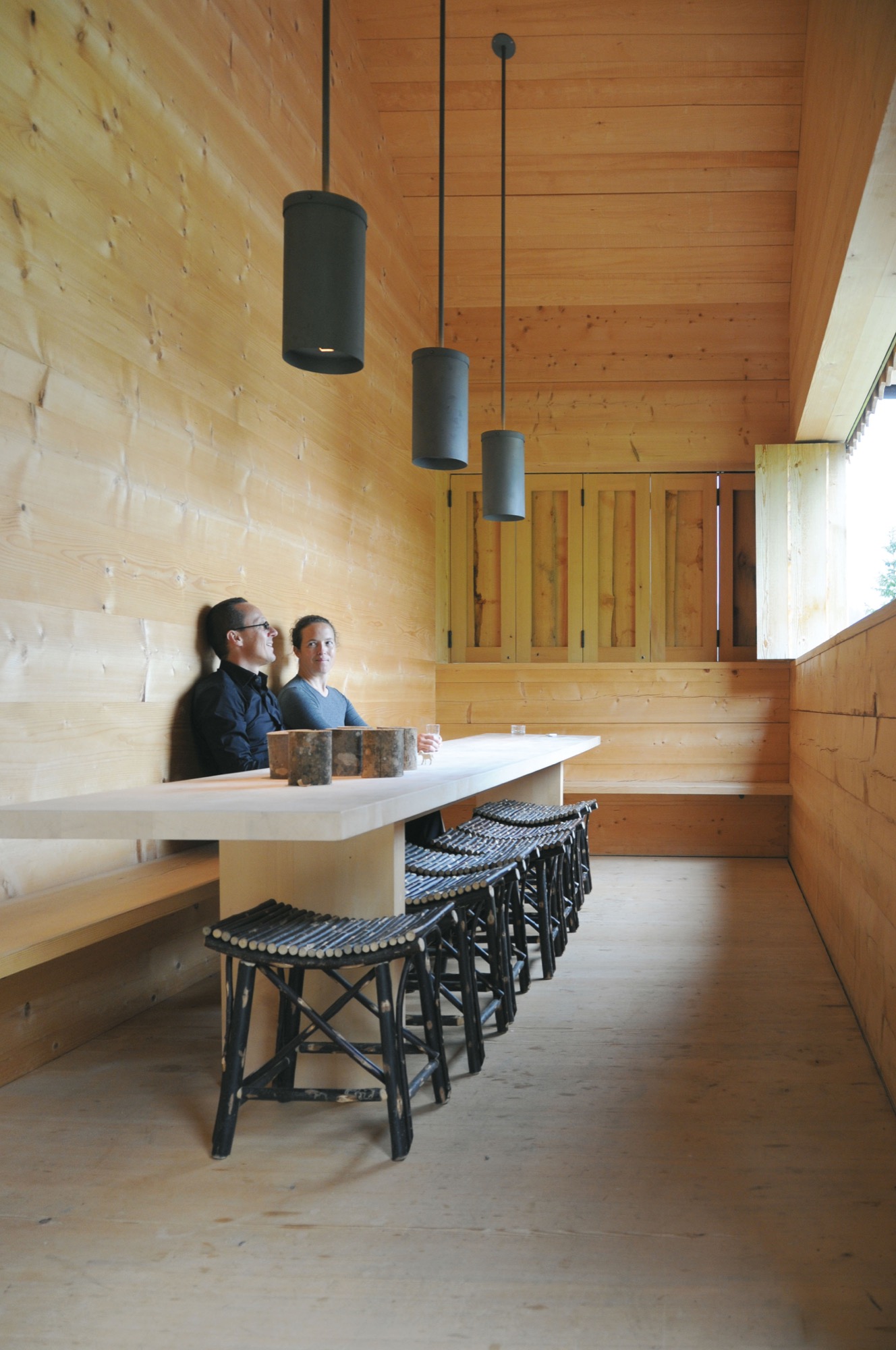
Old cowshed turns splendid cultural center
While Schneider never intended on becoming a hotelier, he did toy with the idea of one day doing something with the arts in Lech. As he and Polletin set about respectfully updating the hotel they also set their sights on a rustic, family-owned barn just up the road from the Almhof. The cosmopolitan couple’s plans to convert the old cowshed into a cultural center for exhibitions and artists in residence were met with small-town mentality suspicion. “There are many things I love about Lech, but locals have an aversion to change,” says Schneider. “They are stuck in the past.” Each winter, Lech attracts an international, discreet (compared to Courchevel or Aspen) jet set crowd that Schneider believed would welcome a dose of culture to complement the powder-dusted slopes and après-ski cocktails.
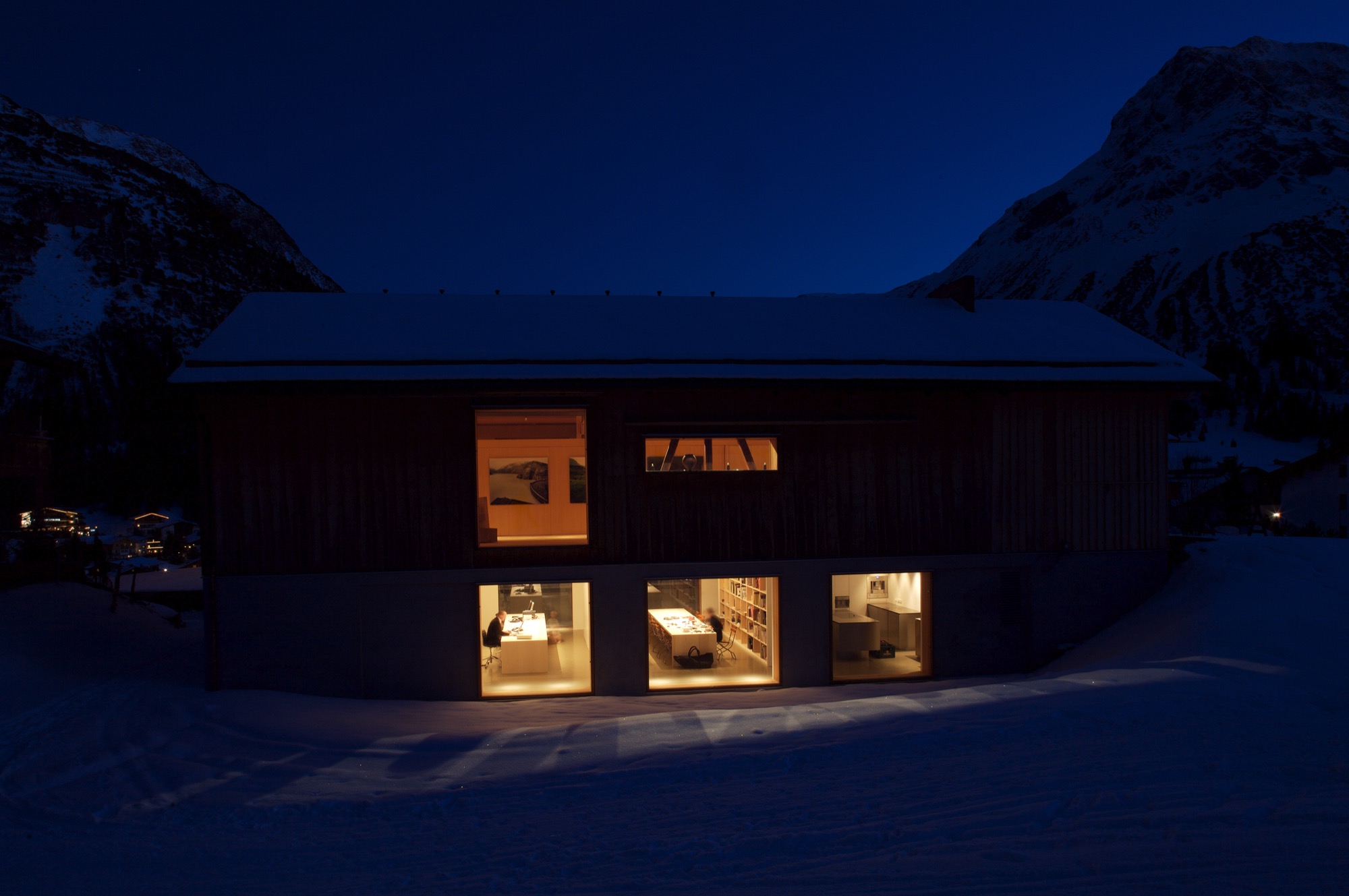
The barn—functional, minimalist Alpine design
In 2000, Schneider and Polletin began transforming the two-story barn into the Allmeinde, an Austrian word that means a public, open pasture. Sensitive to the ski town’s postcard perfect landscape, the pine wood exterior of the Allmeinde is nearly indistinguishable from any other neighboring weathered barn. The only difference is the sliding barn doors have been turned into an enormous window that rolls open to views of the Schlegelkopf mountain ski runs. The interiors, however, are an ingenious example of minimalist Alpine design and functional, fluid living space. On the second floor, the original vaulted beams frame a 1,500-square-foot (ca. 140-square-meter) space divided by a birch cabinet unit. At first glance, it looks like a stark gallery space, sparsely decorated with a few rough-hewn wood chairs and framed alpine-inspired photographs. But, the cabinet unit is like a perfectly packaged gift that neatly unfolds like origami to reveal a studio apartment living space complete with a kitchen, bathroom, shelving, desk area, and Murphy bed.

The atelier-inspired downstairs space holds a private library curated with nearly 2,000 books on music, philosophy, travel, and art. There’s also an office and screening room as well as a kitchen and bedroom, which are used by the family in the summer and visiting artists in the winter. The Allmeinde hosts one exhibition per winter season—all free to the public. Past exhibitions have included British sculptor Antony Gormley, American artist James Turrell, and most recently Italian photographer Walter Niedermayer, whose images brilliantly dissect the landscape of alpine tourism.
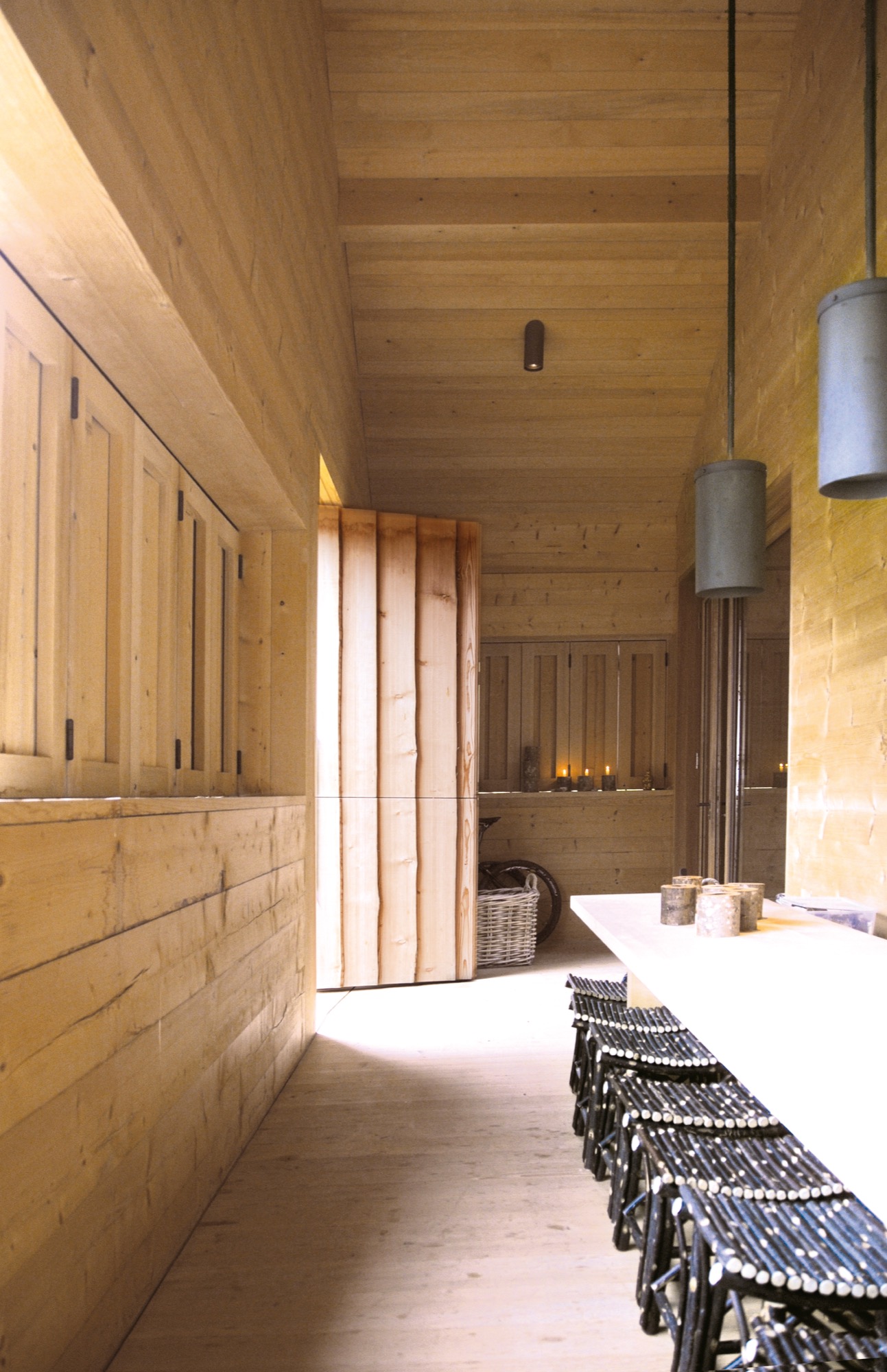
An evolution of tradition
While some locals have viewed the Allmeinde as a threat to tradition, Schneider and Polletin see it as an evolution of tradition, bringing a fresh, international aesthetic to local materials and craft. “Just because you live in the mountains, does not mean you have to be cut off from the world,” says Polletin. “The Allmeinde is part of our identity in Lech. It’s important for us to have this outlet. It’s a celebration of the space we live in—manmade and natural.” △
“Just because you live in the mountains, does not mean you have to be cut off from the world.”
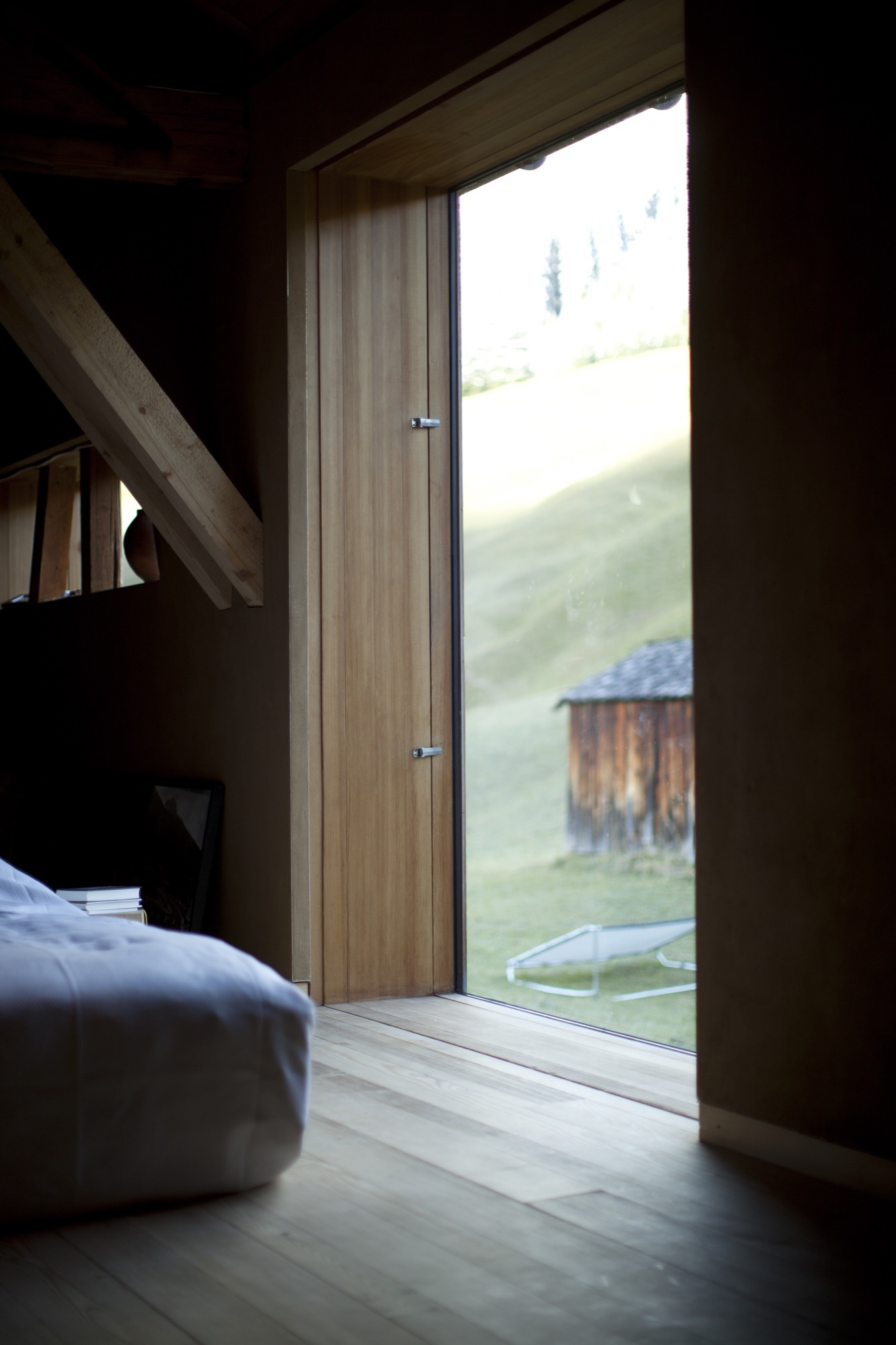
Pictorial Road Trip—Peaks and Lakes in Colorado
Denver filmmaker and photographer Grant Lemons experiences seasonal Colorado landscapes from behind his lens
Born in Salem, the rainy capitol of Oregon, as he calls it, filmmaker and photographer Grant Lemons currently lives in Denver, Colorado, where his sense of adventure awakened. From here, he ventured out into Colorado’s beautiful—and at time mysterious—landscapes of fall and winter.
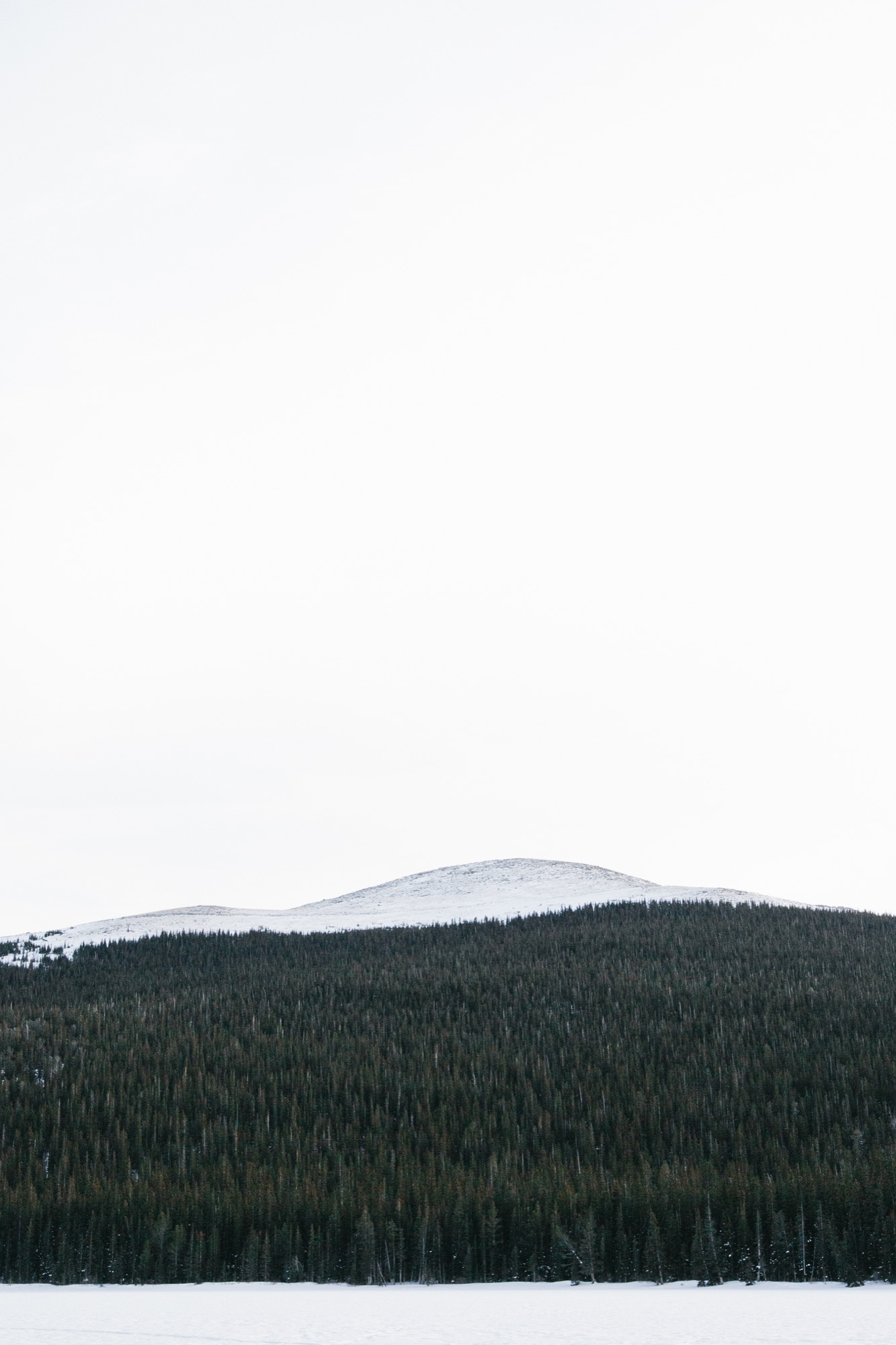
Lemons majored in journalism at the University of Oregon and plans move to Portland this summer.
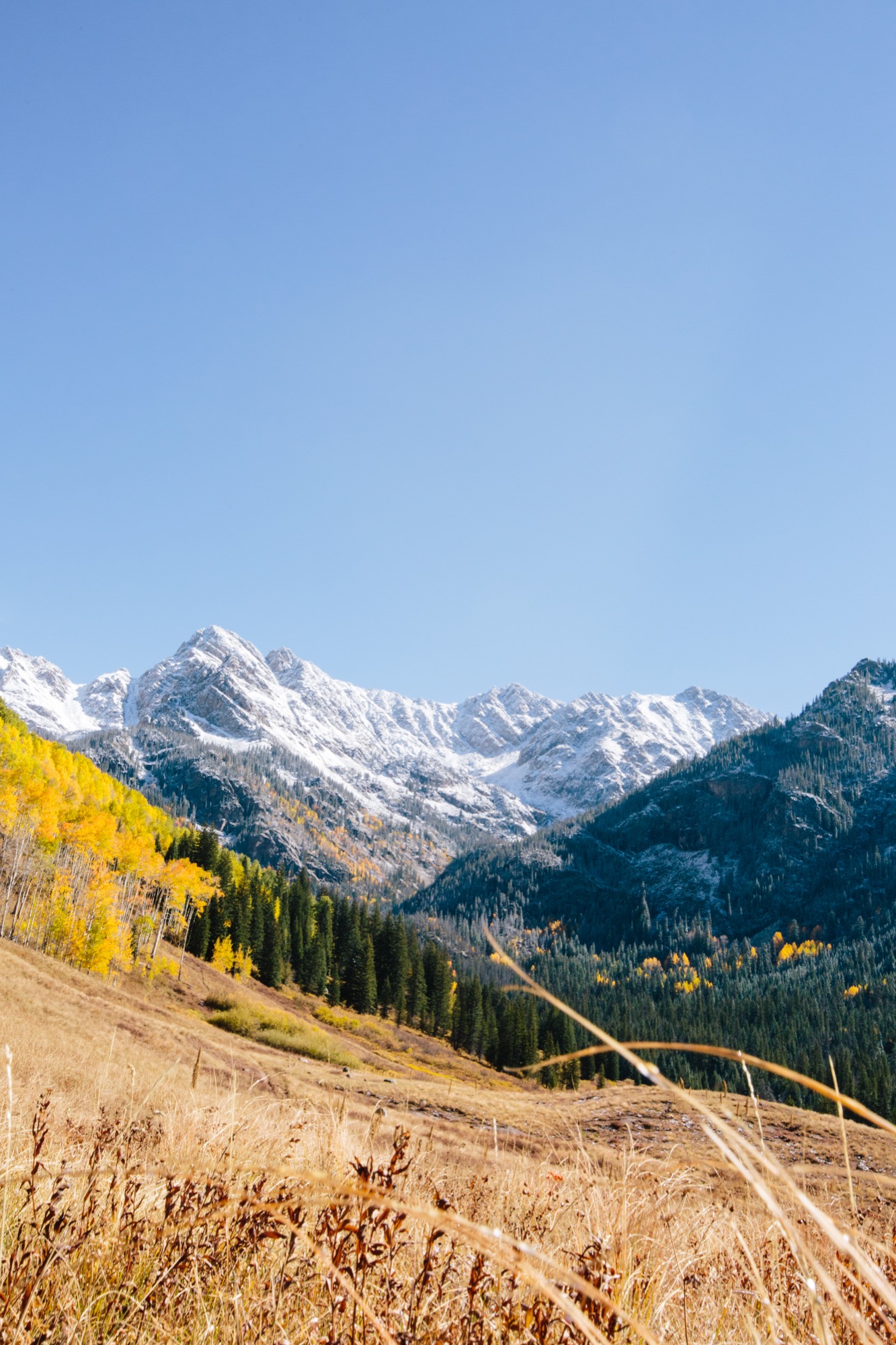
A conversation with filmmaker and photographer Grant Lemons
AM Who are you, in a nutshell?
GL I’m a high-energy guy who loves to capture new places and people... all while listening to hip-hop. I try to run whenever possible, too.
AM When and how did you know you wanted to pursue photography?
GL Simply put, making videos drove me to photography. Like many other people in my industry, I obsessed over telling stories with my camcorder at a young age. Over time, as new gear came and went, and I fell in love with the craft of making films and this passion for the technical aspects began to translate to photography. That initial pivot toward taking photos only happened a couple years ago, and now I find that I spend my days doing somewhere around 70% photo and 30% film. The photo bug bit me, and I've been hooked ever since.
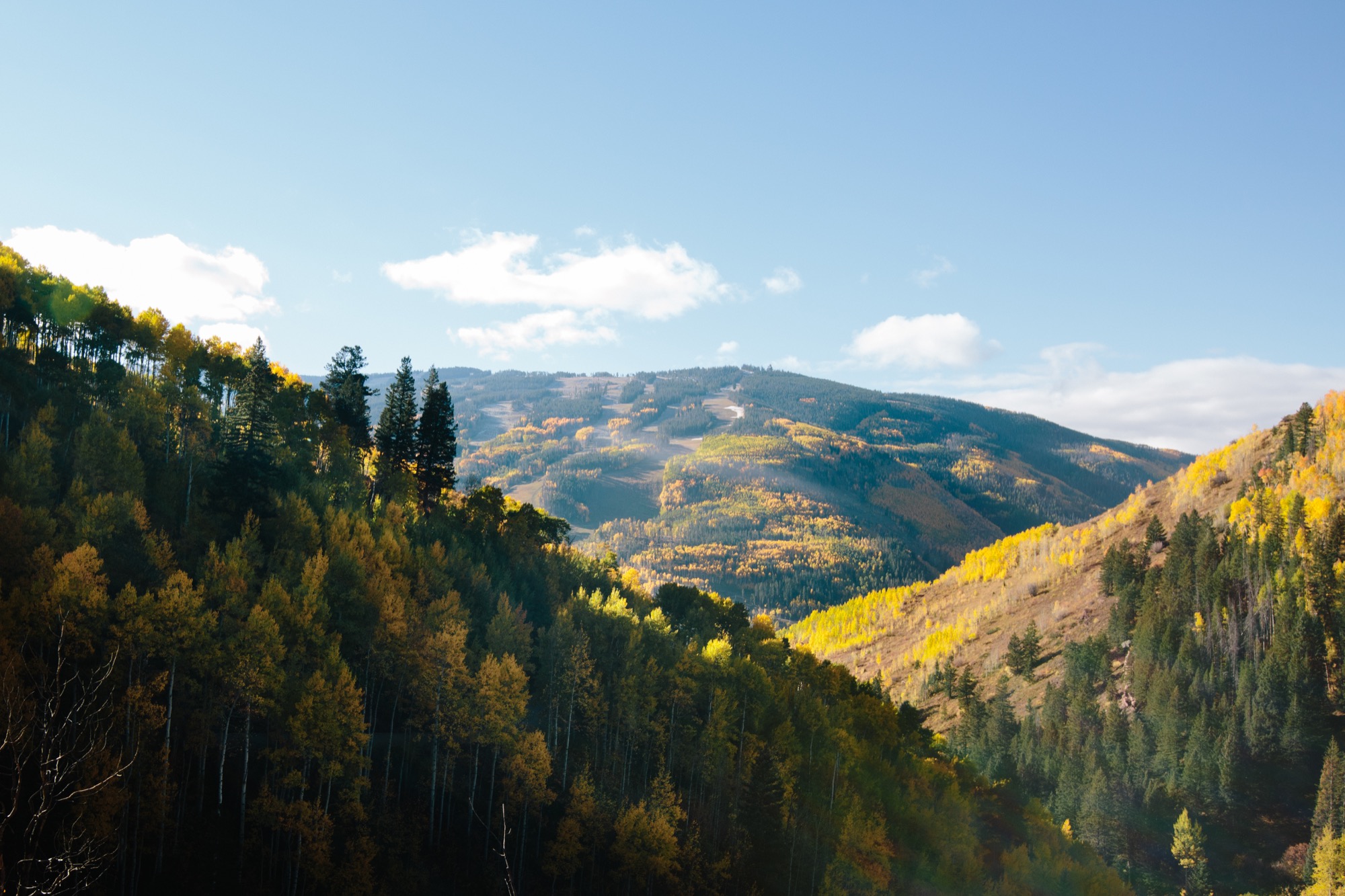
AM How did you learn to be a photographer?
GL Ironically, I never took a photography class while in school. Instead, I learned about the documentary approach to film and to telling stories the entire time. I really learned photography by spending as much time as possible with people who are ten-times the photographer I am. I went on adventures with them and experienced their differing styles. I'm always looking for more opportunities like that. YouTube tutorials are a plus, too.
AM What inspires your work?
GL My friends, my family, and the everyday environments that I find myself in. I try to find inspiration at every possible turn. Additionally, moving to Colorado spurred a real yearning for adventure within me. It's a surreal feeling capturing all you can at 10,000 feet and above.
AM What do you hope people experience when they look at your photography?
GL Wanderlust is an overused word for the feeling many people get when looking through photographs. With that being said, what I hope people get out of my work is a sense of exploration in a really broad sense of the word. No matter where you are, there are interesting moments and places to capture. That's what I seek to do every day when I can, no matter what place I find myself in. I hope when people see my work, they feel motivated to do the same—whether it's in the city or the mountains.
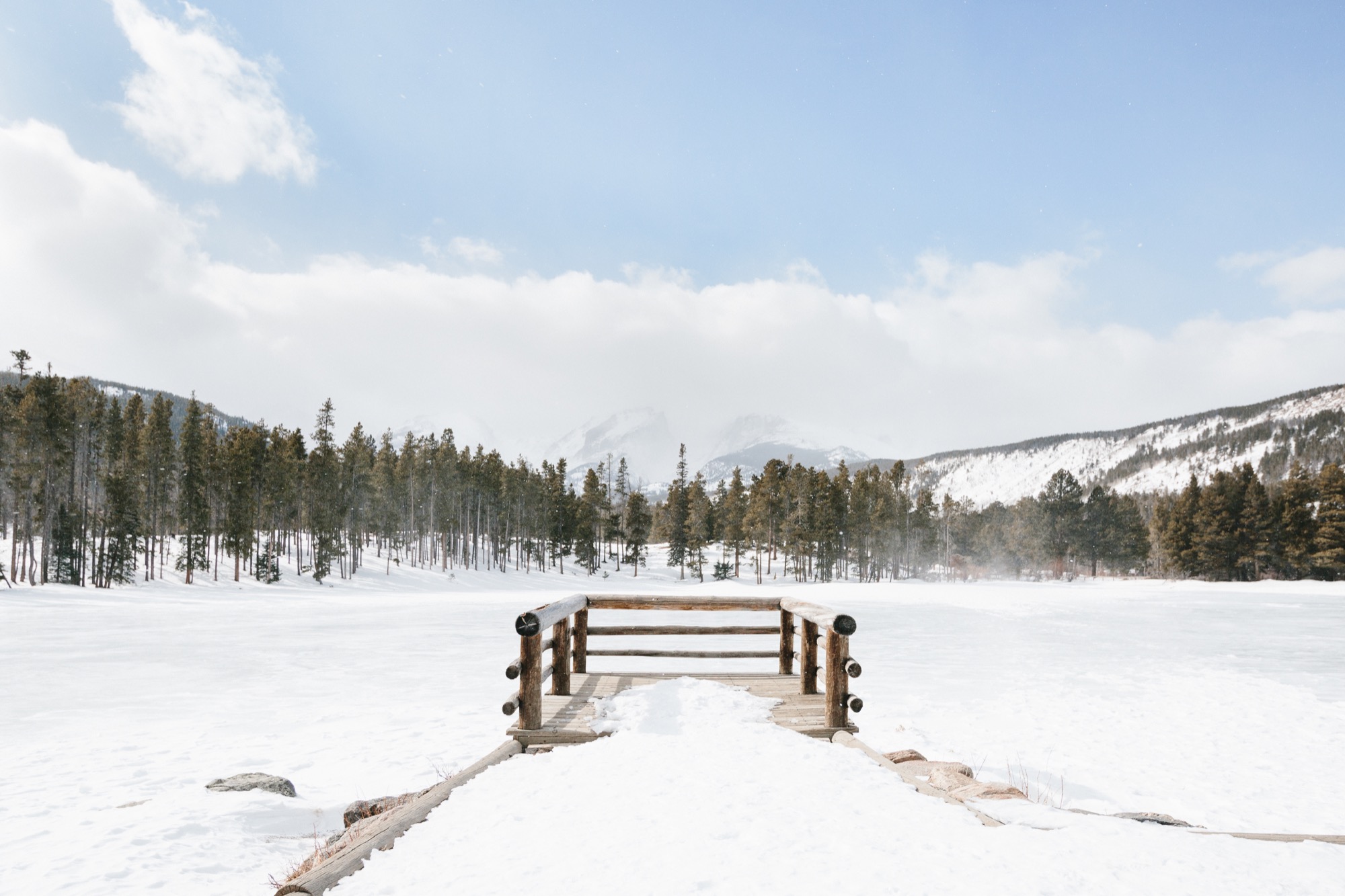
AM What makes you an alpine modernist?
GL At my very core I am a simple person. I don't keep many possessions in my orbit, and I enjoy a strong cup of coffee every morning while the sun rises. As it stands right now, my ideal day is an early wake up at 5:00 AM, heading west to the Rockies, and snow-shoeing in fresh powder to capture the early morning light shining on the mountains.
AM What do the mountains mean to you?
GL Growing up in Oregon, we held the mountains we do have in the state with high esteem—and we do have some remarkable peaks. When I visited Colorado for the first time the enormity and sheer amount of peaks that surrounded me blew me away. Here in Colorado, the mountains represent everything that is good in life, and it would be hard to escape them. Having the wild right at my doorstep with the Rockies took things to the next level for me, and the mountains are a constant blend of fun, adventure, and wonderment.

AM What is special about photography in the mountains?
GL Unlike other environments or subjects, time moves differently in the mountains. On one hand, I feel acutely aware of time and its shifting presence on the landscape in front of me. On the the other hand, I have no grasp on how time is moving when I begin to get in the flow of it all. Hours peel away. It's both a calming and challenging experience when considering the conditions that can come up in the winter, too. A lot of paradoxes, to be certain. It's one of the most rewarding landscapes to conquer and capture.
AM What’s your favorite place in the world?
GL At this point in my life, Portland is my favorite place in the world. An energy kicks into my system every time I touch down there, and it's stacked to the brim with people creating cool things. I really feel like I'm a part of the city in every way. My hometown of Salem, Oregon, is on the come-up, so I have to give it a big shout out too.
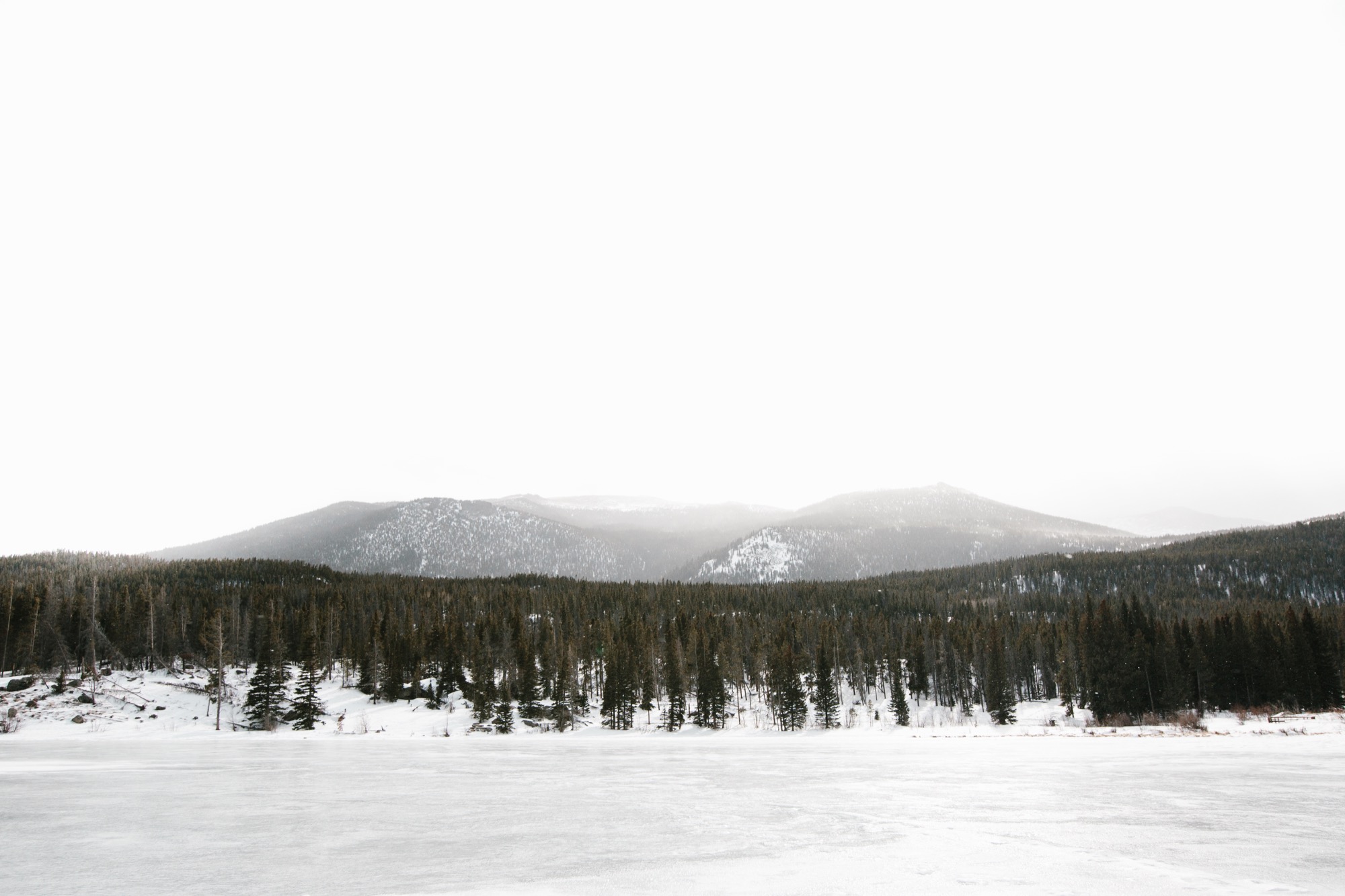
AM What are you working on these days?
GL I'm prepping to capture a short music tour in Europe in March. Recently, I've been lucky enough to have extra time to work on passion projects, which coincidentally, leads me to the mountains. I'm trying to use every day as an opportunity to capture a different Coloradan moment as my time to move away approaches. I'm really thankful to be around for another (somewhat) snowy winter. △
Introducing Alpine Modern’s New Nordic-Alpine-Inspired Menu
With worldly Chef Ellory heading the kitchen, seasonal ingredients shine in simple, clean food at the Café
We recently introduced you to our new executive chef, Ellory Abels. After she had helped to grow the San Francisco catering company Green Heart Foods, the Texas native traveled the world in search of culinary inspirations. The Culinary Institute of America graduate visited eight countries, where she collected different spices and cooking traditions she now integrates into her own kitchen.
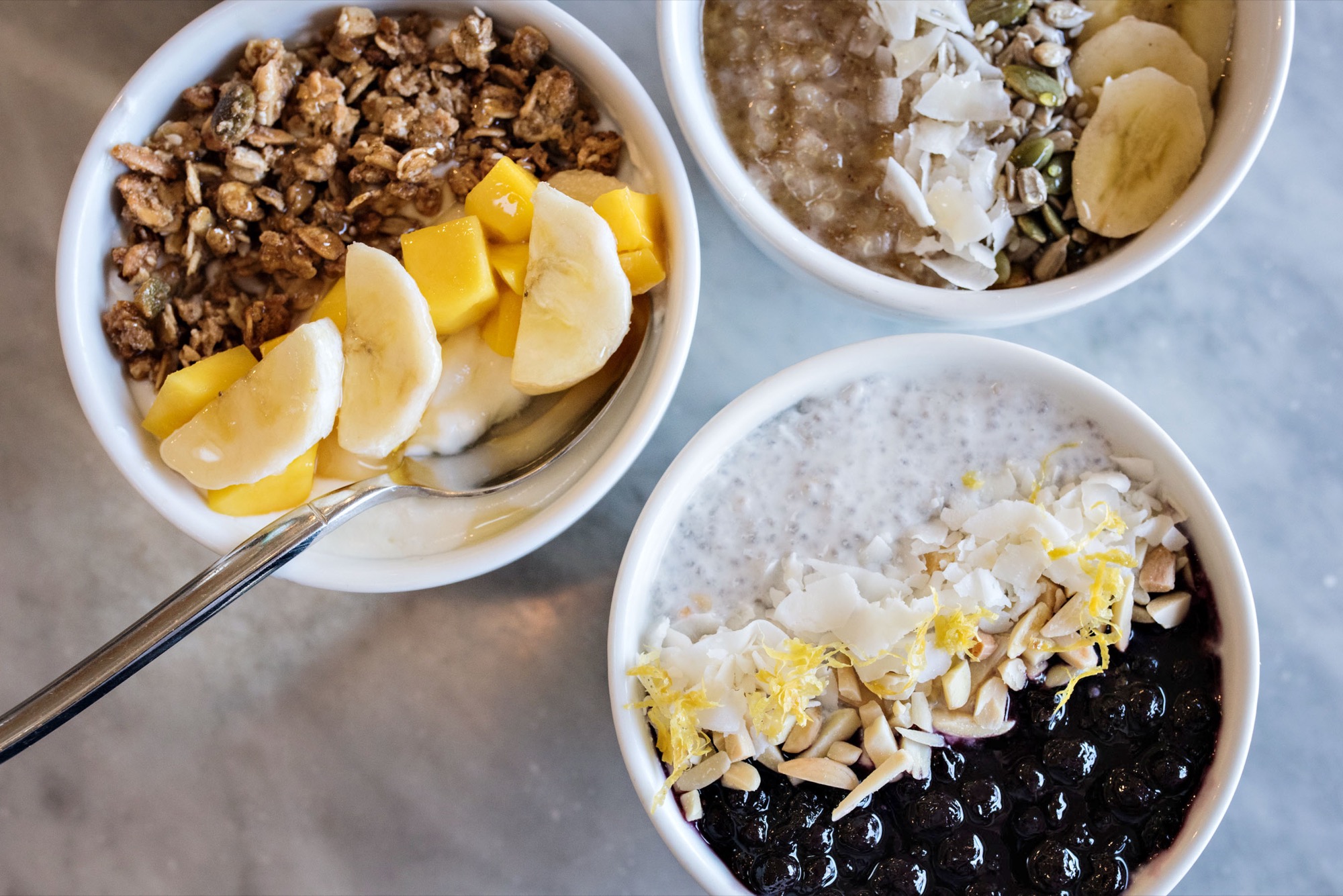
Upon returning from her culinary expedition, the outdoor enthusiast and passionate rock climber settled in Boulder, Colorado, where her incredible talent, serendipity, and (our) luck brought her into the Alpine Modern family.
We sat down with the worldly chef to talk about the much more elevated and seasonal menu she has created for the Alpine Modern Café in Boulder, Colorado.
Chef Ellory talks about Alpine Modern’s new Nordic-alpine menu
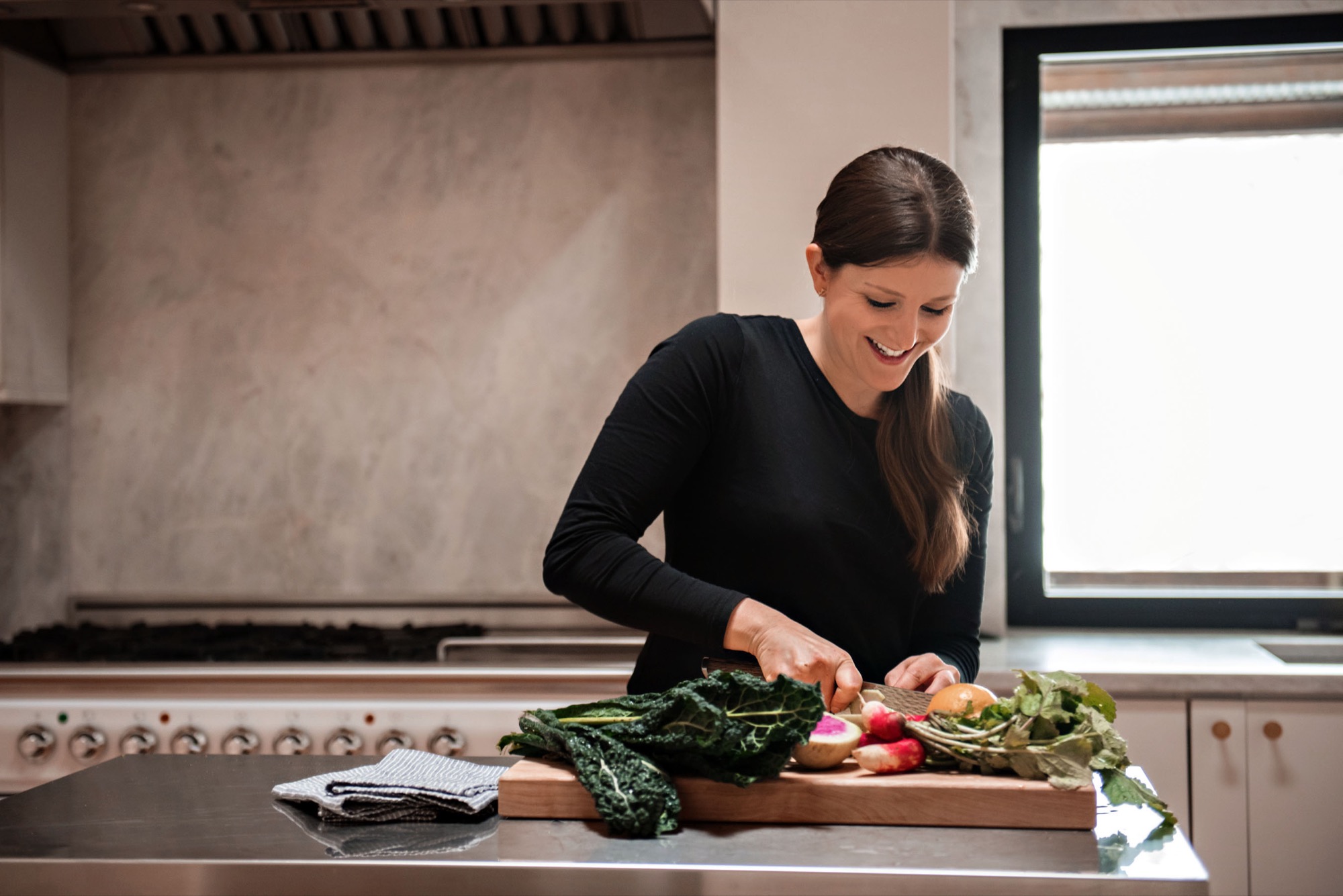
AM What’s essentially different about the new menu you have created for the Alpine Modern Café?
EA When I came to the Café, the food was very approachable but lacked a theme. I wanted to elevate the menu and make it seasonal. With a seasonal menu, you have fresher ingredients and can source them locally. As humans, we’re based on tradition and the themes of life and holidays. I feel that food and the ingredients are very much based on that, too.
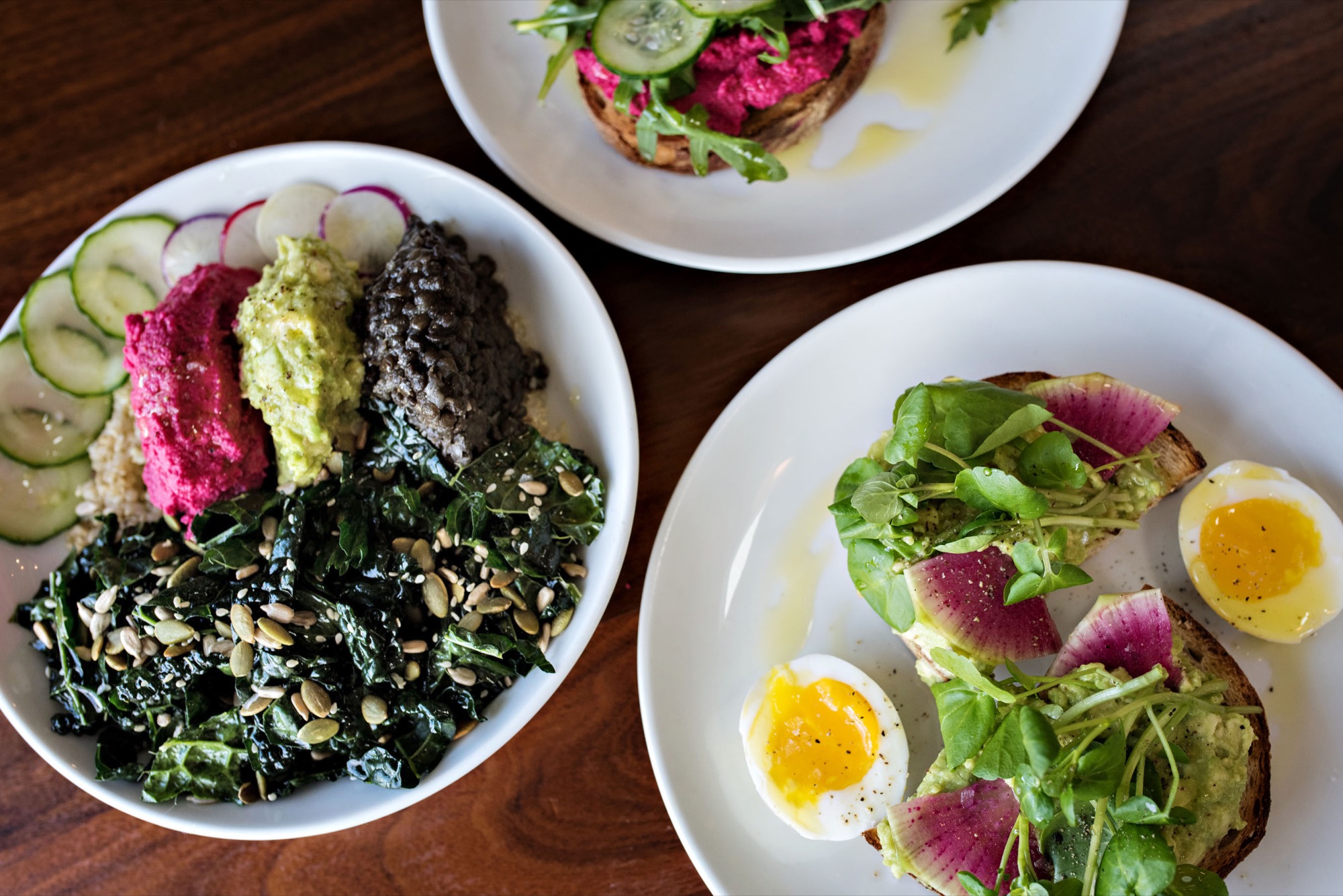
A Nordic-inspired menu
AM How did you come up with this new approach for the Alpine Modern menu?
EA I brainstormed what Alpine Modern was as a brand, what the food represents to us, and what we wanted to show the customers to be our foundation. Then I came up with the theme of Nordic-alpine food, which is scary for a lot of people. When you say Nordic food, you think of pickled herring or just really gross dishes like that. So I was very cautious of saying that to people. But I thought of what Nordic food is to me. I made a list of seasonal ingredients and started to build a menu off that. With food trends happening right now and the health consciousness—and I myself really care about nutrition—I wanted to implement that more into the menu as well.
AM Why Nordic? Boulder doesn’t necessarily represent a Nordic culture or environment...
EA Nordic represents simple living and food. I mean, look and their menus. It’s very healthy. It’s very clean. It’s not overthought. And I wanted to show that in the food. So I don’t necessarily want to say it’s Nordic-style food, but it has these same things behind it. It’s inspired by the foods of Iceland, Norway, Finland…
AM What are key ingredients you have implemented for the new menu?
EA I am using fennel, beets, dill, water crests—and instead of herring I’m using trout, and making it more approachable in that way. Instead of creams, I’m using thick, Nordic-style yogurts. And lemons, I’m using lots of vibrant zests in the food. And on top of that, I’m making it more seasonal.
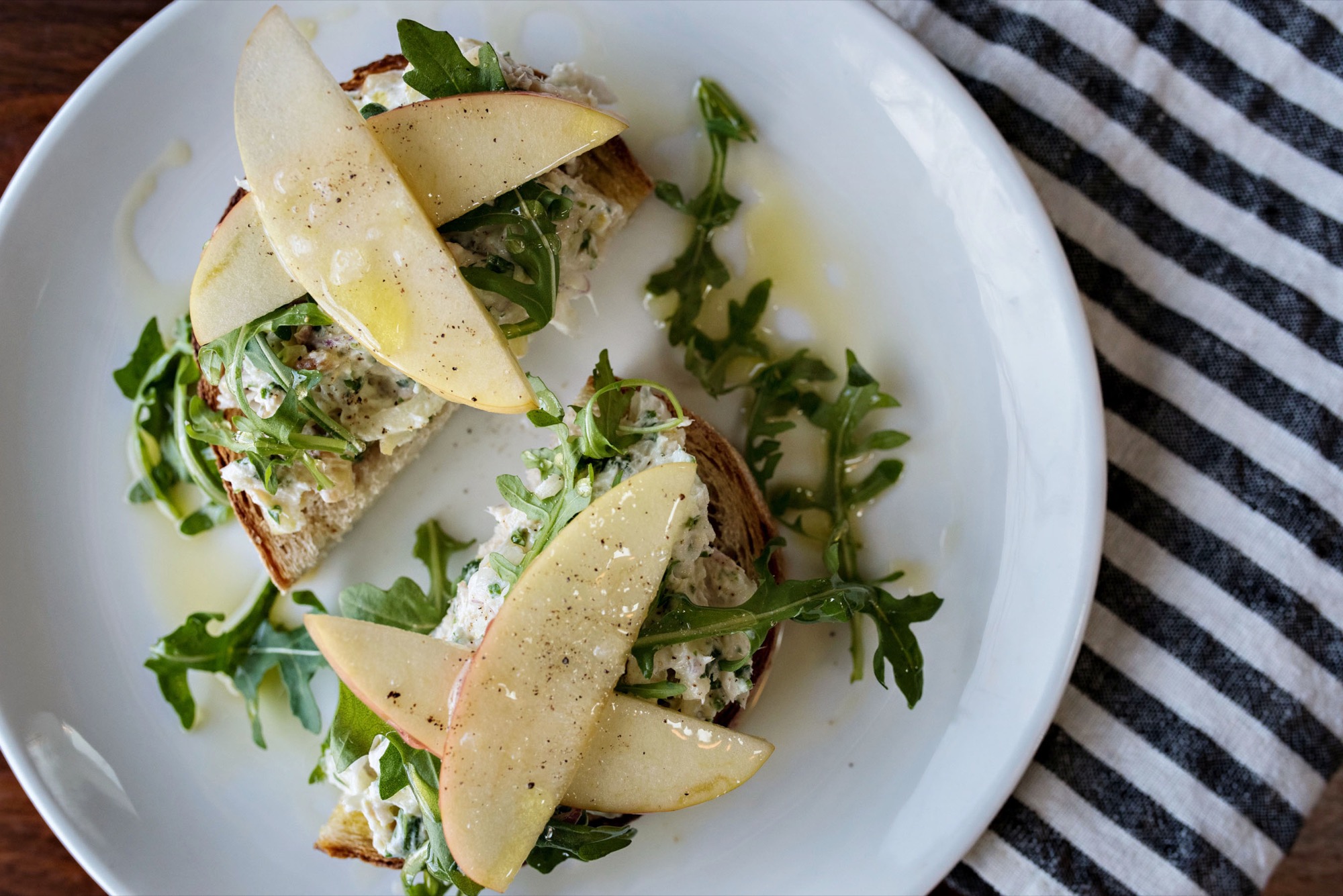
For example, our beet hummus on the winter menu will probably change to a carrot hummus in the spring. The menu will probably change four times a year.
With a healthy dose of Ellory...
AM The new menu is seasonal and Nordic-inspired. But what part of the new menu is quintessentially Ellory?
EA The twist of having what I would call nutritional, healthy hippie food intertwined into it. It goes with the Boulder theme. I worked in San Francisco before I came here, and I’ve been very health-oriented in the places I’ve worked. Greens are huge to me, so I’m trying to implement greens into almost every dish. And freshness and the vibrancy of colors. That’s very much me. The chia seed pudding, the quinoa porridge, the kale salad with avocado seeds... That’s very much me.
“Nordic represents simple living and food... I mean, look and their menus. It’s very healthy. It’s very clean. It’s not overthought. It’s inspired by the foods of Iceland, Norway, Finland…”
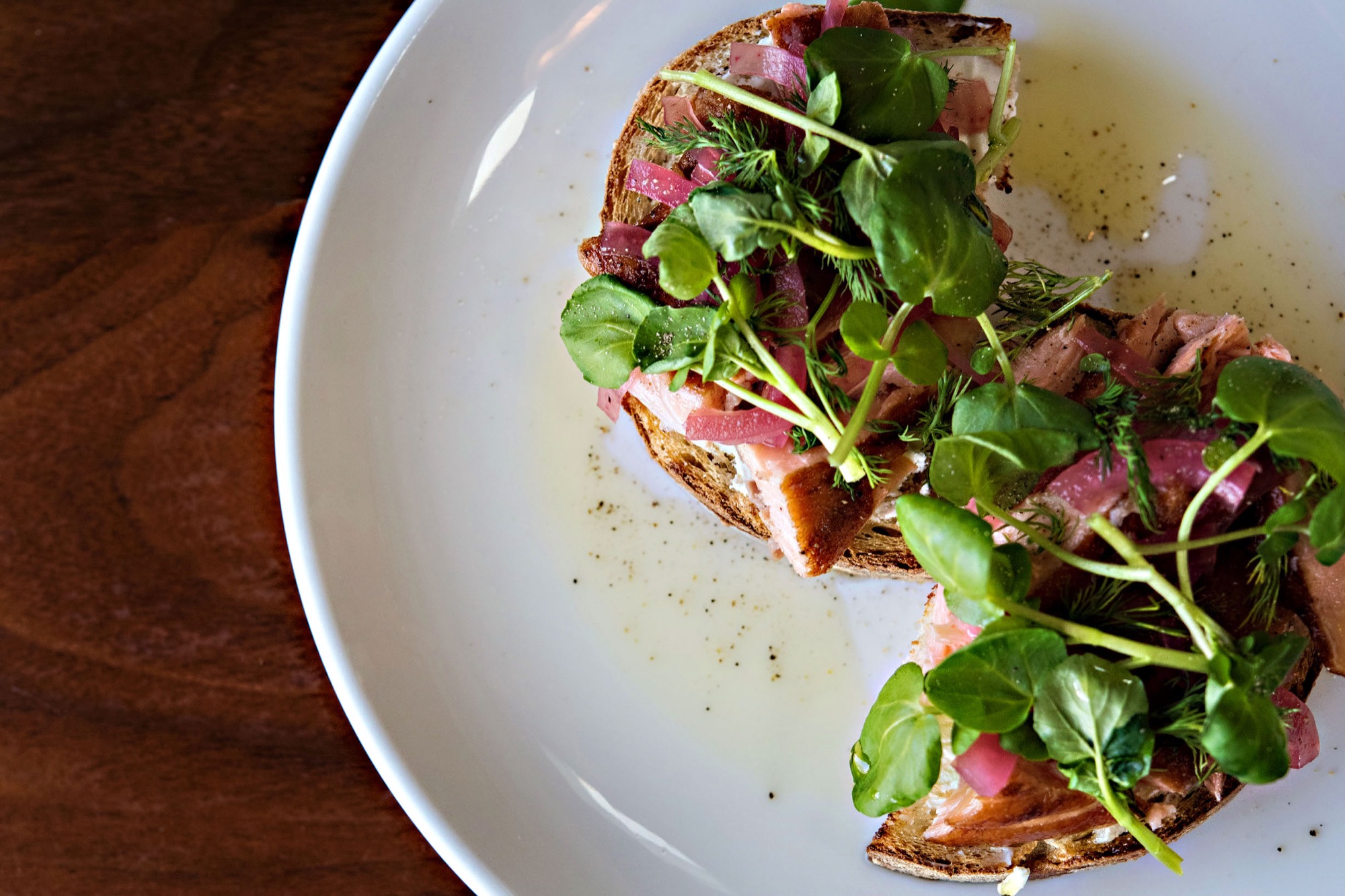
Behind the scenes
AM Now that we have an executive chef, a huge step up for Alpine Modern, and we have launched a new menu, what else has changed at the Café?
EA We’re focusing on making this not only an environment where people can come and get amazing food but also have amazing beverages that are special to the Café here. We’re creating monthly special beverages. Right now, for example, we have the Williamsburg and the matcha latte, and we’re going to have a Turmeric Latte soon.
AM Besides taking the menu to the next level, how does having you as an executive chef impact the Alpine Modern Café and the brand at large?
EA Having an executive chef here allows a lot more growth for Alpine Modern, for our food, and for the whole scene of the Café. It allows us to create a solid foundation and consistency and to implement new ways to eat and to be here at the Café. For example, we’re starting an event program, and we’re hoping to have live music in the summer and to do grill-out nights. There will be so much opportunity. And we are starting to implement grab-and-go food from the Café into our downtown location soon, at the Coffee Bar in our flagship retail store on Pearl Street here in Boulder.
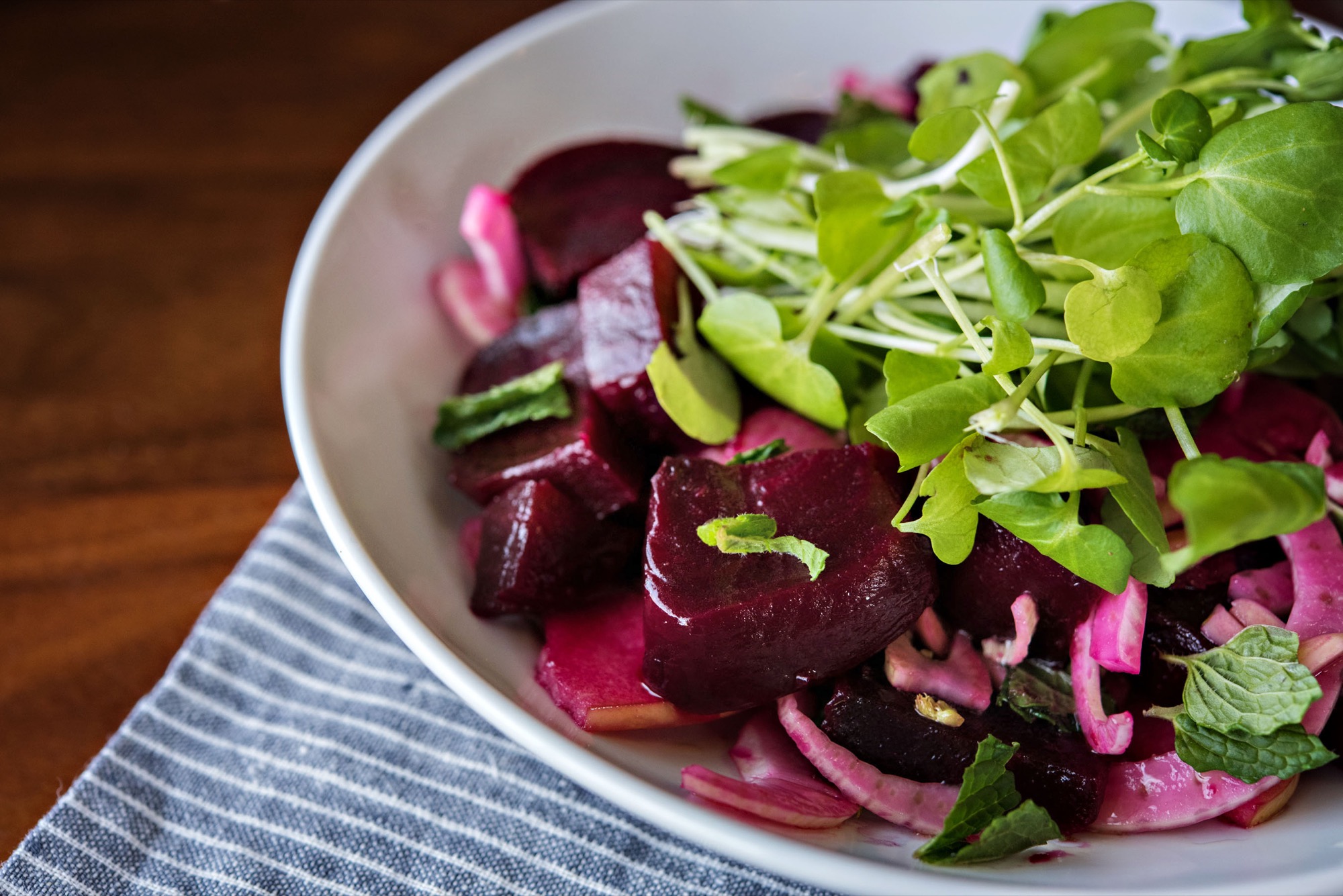
We’re also working on baking our own pastries fresh every morning. Another new thing is that we are offering gluten-free items. We’re working with Kim and Jake’s Bakery, a local gluten-free bakery. We’re using their bread and cookies, so almost everything on the new menu now has a gluten-free option.
“Almost everything on the new menu now has a gluten-free option.”
AM What is currently the most popular item on the new menu?
EA The Quinoa Lentil Bowl. It’s also one of my favorites for sure. And the Chia Seed Pudding—people are really digging that.
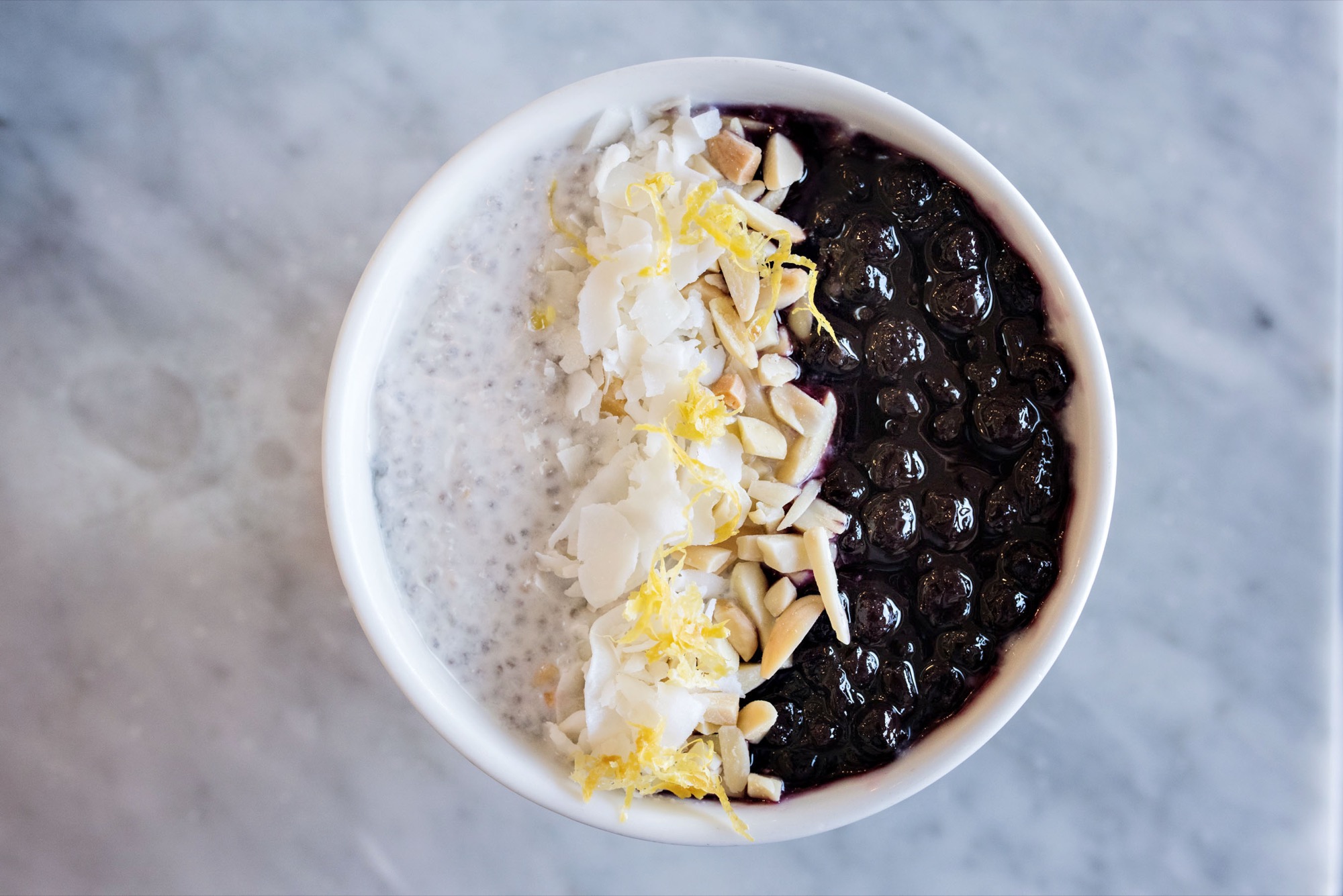
AM What feedback are you getting about the new menu?
EA The Café staff are loving it, and the customers are really enjoying it, saying things like, ‘Wow, you guys really elevated the menu.’ And that’s exactly what we wanted to do. The menu is not complex, it’s very simple, it’s all approachable because we have such a diverse community here in Boulder. We serve families and college students and young professionals—and we really wanted this to be something where you can walk in, and anyone can find something on the menu.
Come for the food and drinks, stay to feel good
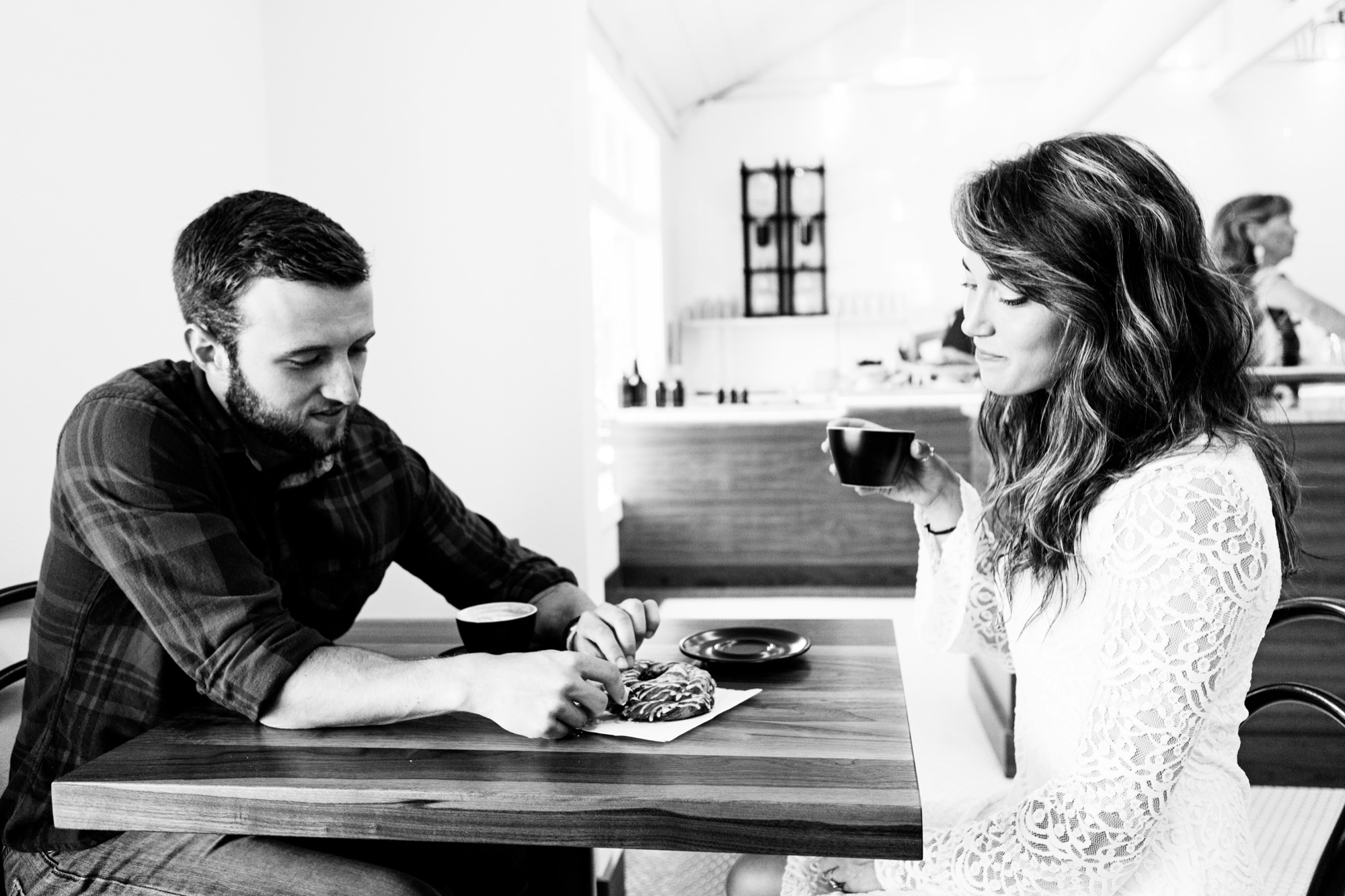
AM What are you hoping people come to the Café for?
EA I hope they come here to have their daily clean food, to eat food they really want and that they feel good for a while. And the same with their beverages—having amazing coffee that we really put a lot of time into finding and creating the best process with our ModBar. I hope our customers come in here and see that there is a lot of love and care put into everything—with our plating, with our presentation, and with our sourcing. △
“We really wanted this to be something where you can walk in, and anyone can find something on the menu.”
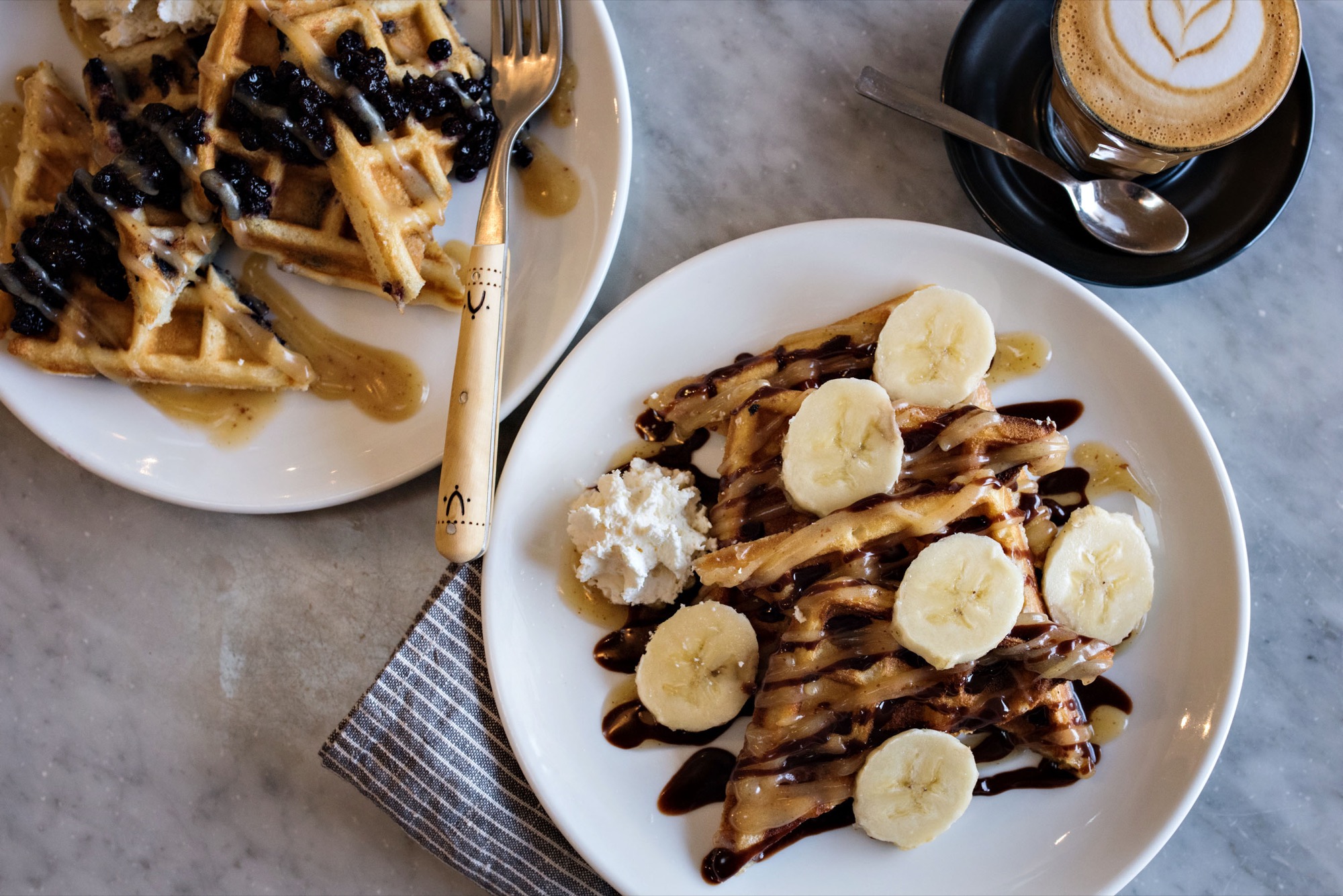
The Line between Everyday and Heirloom
A Visit to the Lake Tahoe Home of the Owners of Heath Ceramics
“In the winter, everything is dead, and in the spring, everything comes to life,” says Catherine Bailey as she looks out the window of the Tahoe home she shares with her husband, Robin Petravic, and son, Jasper.

Bailey and Petravic are the driving forces behind a reinvigorated Heath Ceramics, the Sausalito, California-based company that was started in midcentury by Edith Heath and given a dose of new energy by the couple in 2004.
When taking the tour of the Heath facility, the guide explains that, at its essence, the company aims “to straddle that line between the everyday and heirloom,” words that perfectly describe the experience of Bailey and Petravic’s Tahoe home in California’s Sierra Nevada.
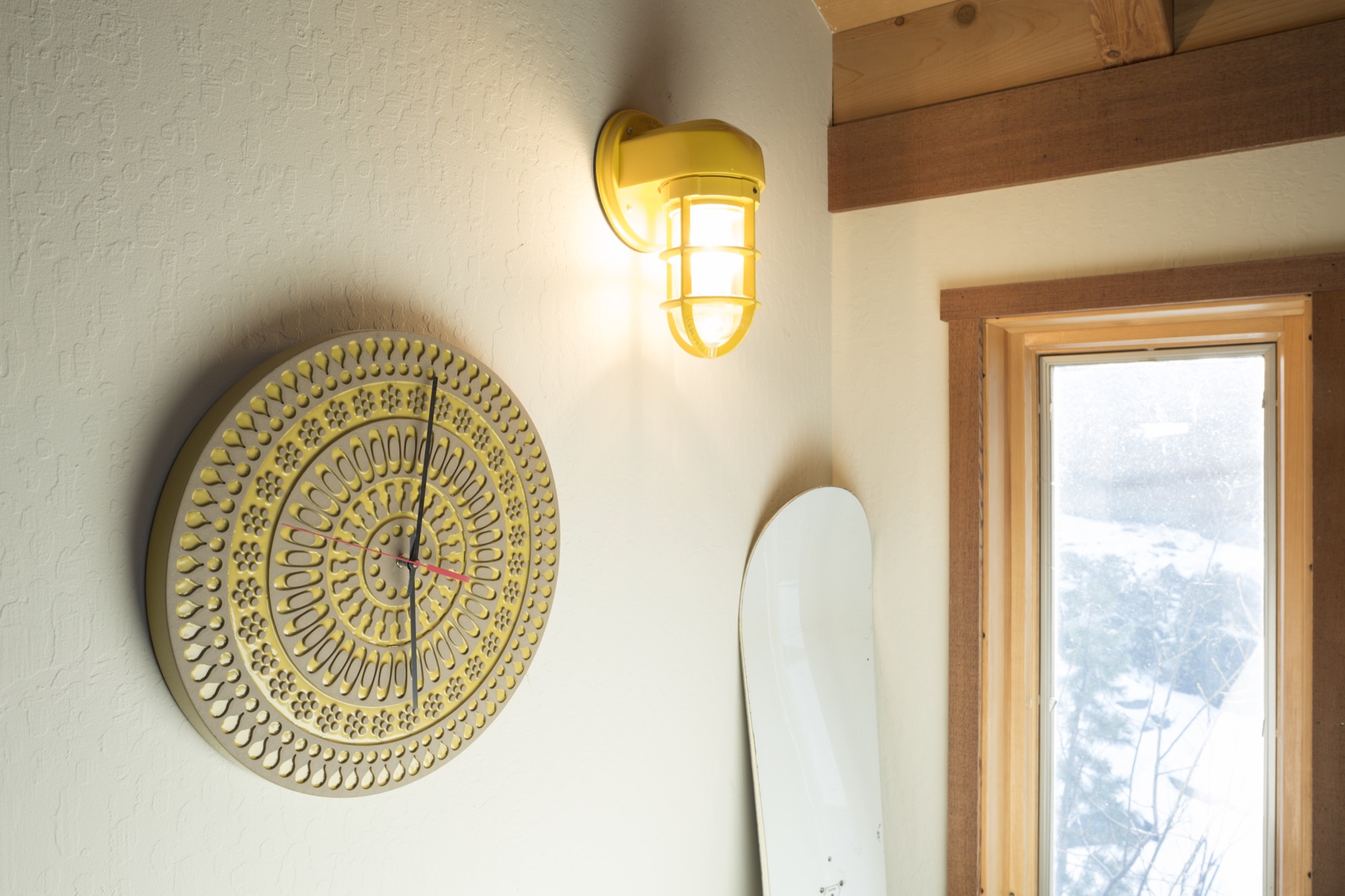
Finding the house (or being found by the house)
The couple are avid winter sports enthusiasts—Bailey had consulted for many years as a product designer for a large snowboard manufacturer—and had been looking for a weekend escape for some time when their real estate agent called about a listing in their desired area of Alpine Village. They were so excited about its location and the fact that they could walk to the slopes of Alpine Meadows Ski Resort that they made an offer on the house sight unseen.
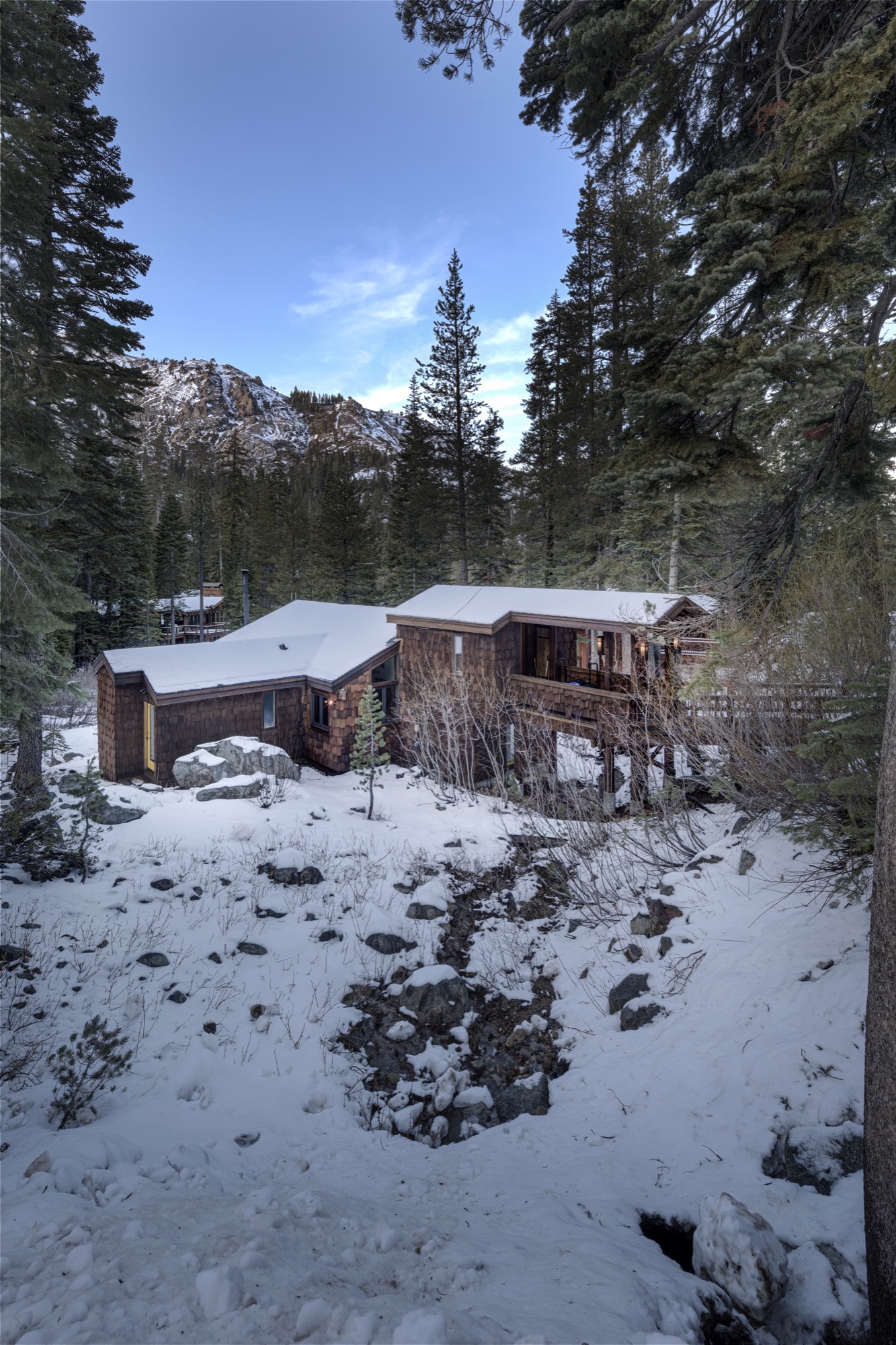
When they did finally see the house, they were immediately taken by its placement on the lot, how it cascaded down the hill to the creek below and was framed by the dramatic mountain peaks behind it.
At the same time, they were underwhelmed by some unfortunate interior decorating choices. “Everything was green—green carpeting, green cabinets, and green linoleum,” a design aesthetic Bailey laughs about. “I guess the former owners thought, ‘We’re in the mountains, so we should make things the colors of trees.’ ”
The couple was able to look beyond the green, however, and fell in love with the bones of the house, especially its beamed wooden ceilings and reclaimed wood doors.
Making it modern
After purchasing the home in 2012, they embarked on what Bailey calls “a low-hanging-fruit” remodel. Her method was to “always look back to 1974, when the house was built, and not mask that, but make it feel nice for today. The brown of the wood beams and doors with bits of orange, yellow, and red resonate with the mood of that period,” she says. “The interior feels fresh and bright without having to paint everything white.”

It’s easy to draw a comparison between the house remodel and what Bailey has done with Heath as creative director. “We didn’t find it very interesting to just have a nostalgic company where you are just trying to recreate the past,” she says.
Instead, the past becomes inspiration for moving forward. “Our philosophy has been to look back to where you’ve been and what you’ve done and don’t ever run away from it, but to learn from it.”
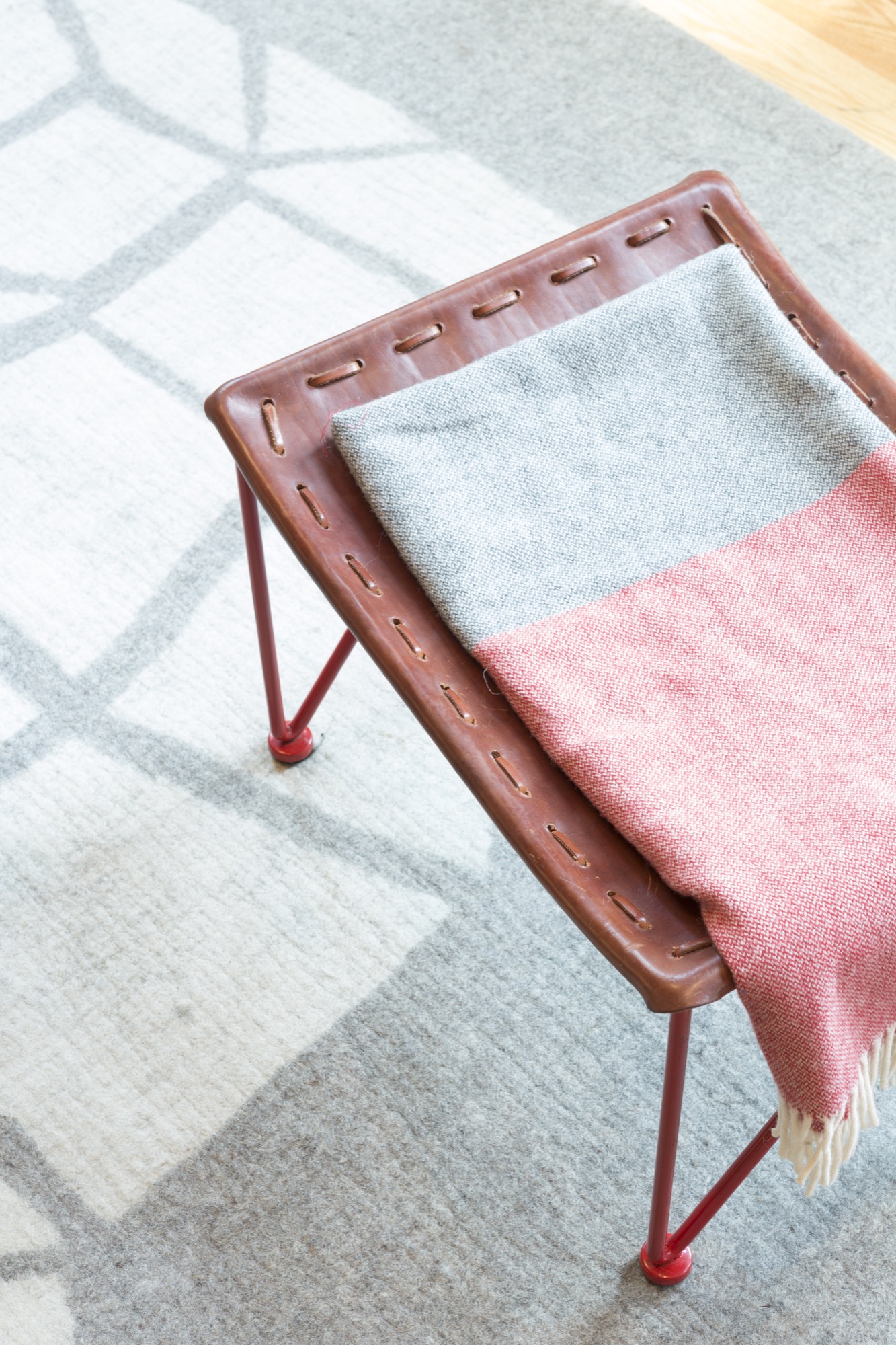
“Our philosophy has been to look back to where you’ve been and what you’ve done and don’t ever run away from it, but to learn from it.”
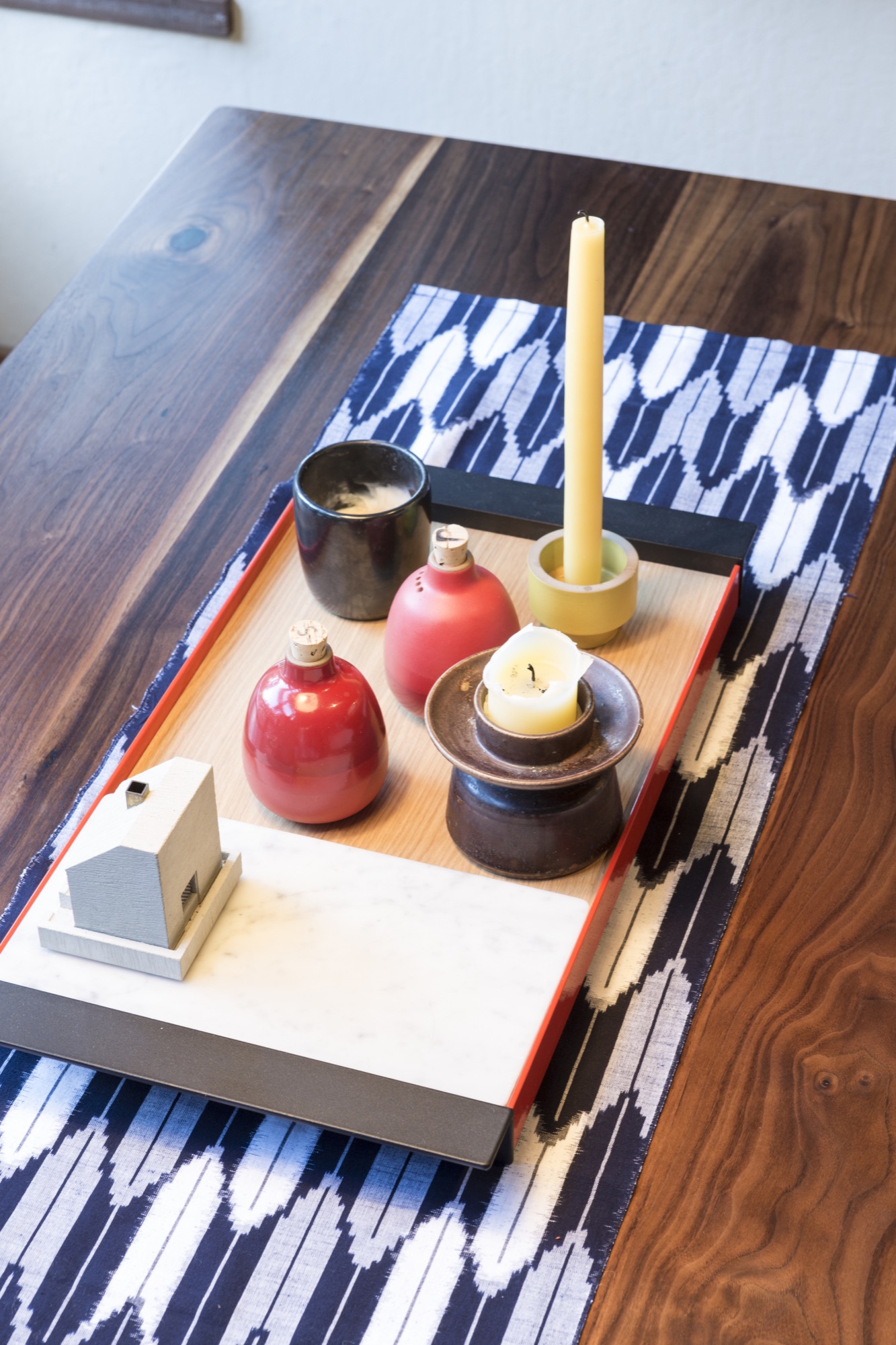
Heath ceramics
Heath was founded in 1948 by Edith and Brian Heath and is famous for its handcrafted stoneware and distinctive glazes. Under Bailey and Petravic, it continues to produce and design midcentury tableware and tile in its California factories, but the couple have expanded the company with a business model driven by “design-led manufacturing principles, and in the belief that responsible business practices lead to long-term viability.” Since purchasing the company, they have added new colors, opened a new tile manufacturing factory and showroom in San Francisco, and started up a Los Angeles studio and showroom. Most importantly, they have expanded the brand through successful collaboration with designers and ceramic artists from around the world.
“We are always looking for the next creative opportunity that fits with what we love to do: the materials we love to explore and the people we want to work with,” Bailey explains. Those successful collaborations run the gamut from the prolific Fresno-based ceramic artist Stan Bitters and the well-known type designers at House Industries to the Mexican artist and designer Carla Fernández.
Tahoe sleepover
This spirit of openness is also reflected in the Tahoe house.
At 1,450 square feet (135 square meters), it’s a relatively small house with one big living area. But the couple was committed to finding a way to sleep a lot of people and their kids. Every bedroom has a loft with an additional place to sleep, so you can fit a family of three in each room. “We also turned the laundry room into a bedroom,” says Bailey. At times, there are three families staying at the house all at once. “That’s why we come here,” she says, “to spend time with people we want to spend time with. You don’t normally get to have your friends over to sleep at your house for the weekend.”

The couple also uses the house as a refuge and escape from the demands of running a hectic Bay Area business. The breathtaking living-room views of the Squaw Valley peaks provide the seclusion and isolation that they love. “You’re in a wonderful gem in the big outdoors—it’s kind of big out there—and there’s not a lot coming at you. That’s what makes it inspiring and special,” Bailey says.
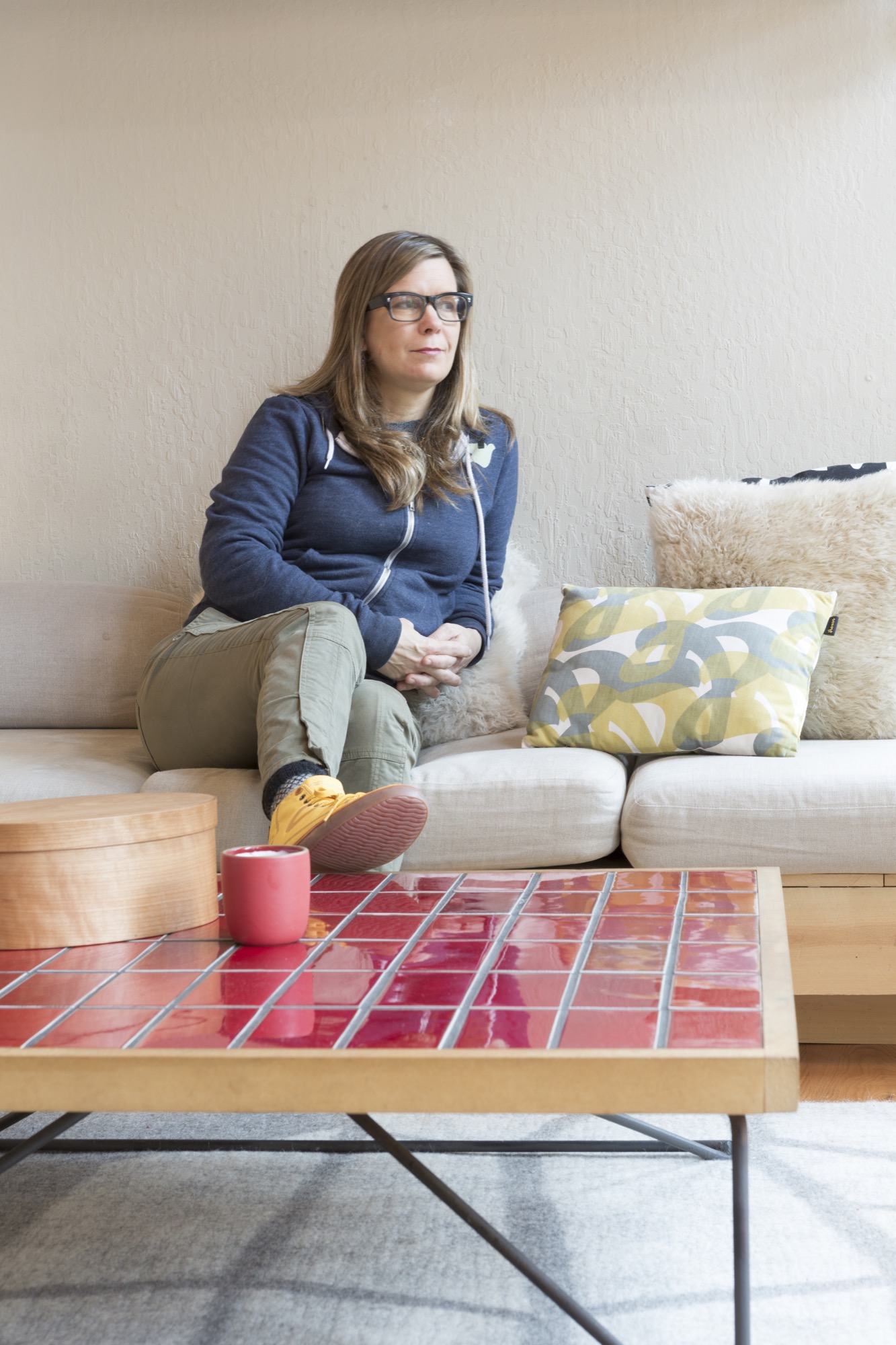
Her seat of inspiration in the house is the couch. The expansive view opens up from there. “In the afternoon the light comes in across the fireplace, and it really gives you this great sense of time of day because there is no direct light until late afternoon.” At that moment “you think, ‘Is my day going like it should have?’ It’s your last chance to get out and take a walk and make the most of your day. It’s like an alarm clock, and it’s the sun, and I’m reminded that I want to get outside.”
“That’s why we come here, to spend time with people we want to spend time with. You don’t normally get to have your friends over to sleep at your house for the weekend.”
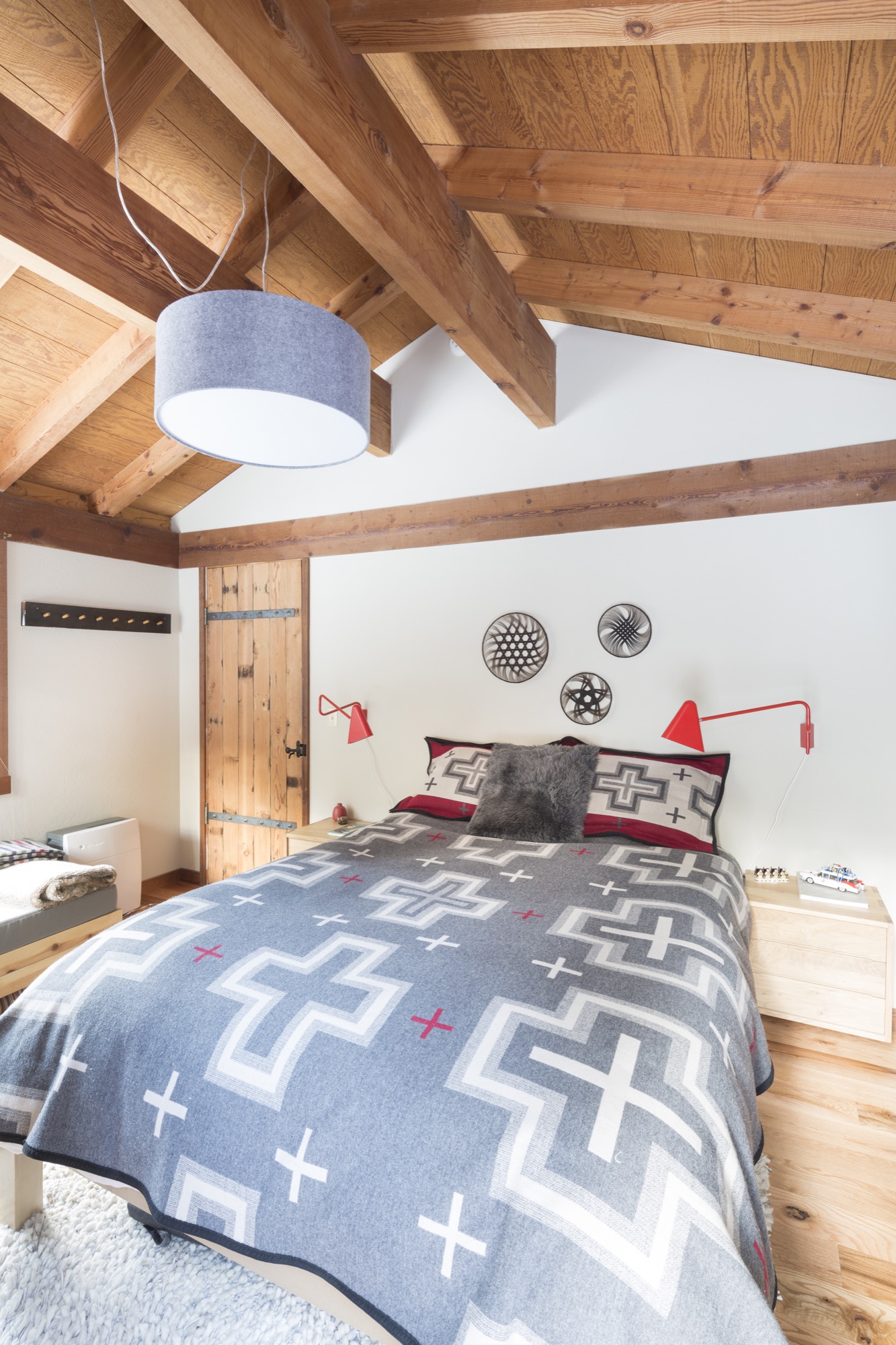
A place of inspiration
This sense of place—Tahoe, the outdoors, the sun, the mountains, the sky, the colors—serves as creative inspiration for Bailey. “When you are in that environment, there are all these base colors that ground you—make you feel the whole place, and then there are little points of vibrancy.” It’s an environment that is not bright colors all the time. “It’s subtle,” she says, “and the granite of the mountains is part of that, at least where we are. Granite grounds it colorwise. We are not on the lake, which is that crazy vibrant blue color.”
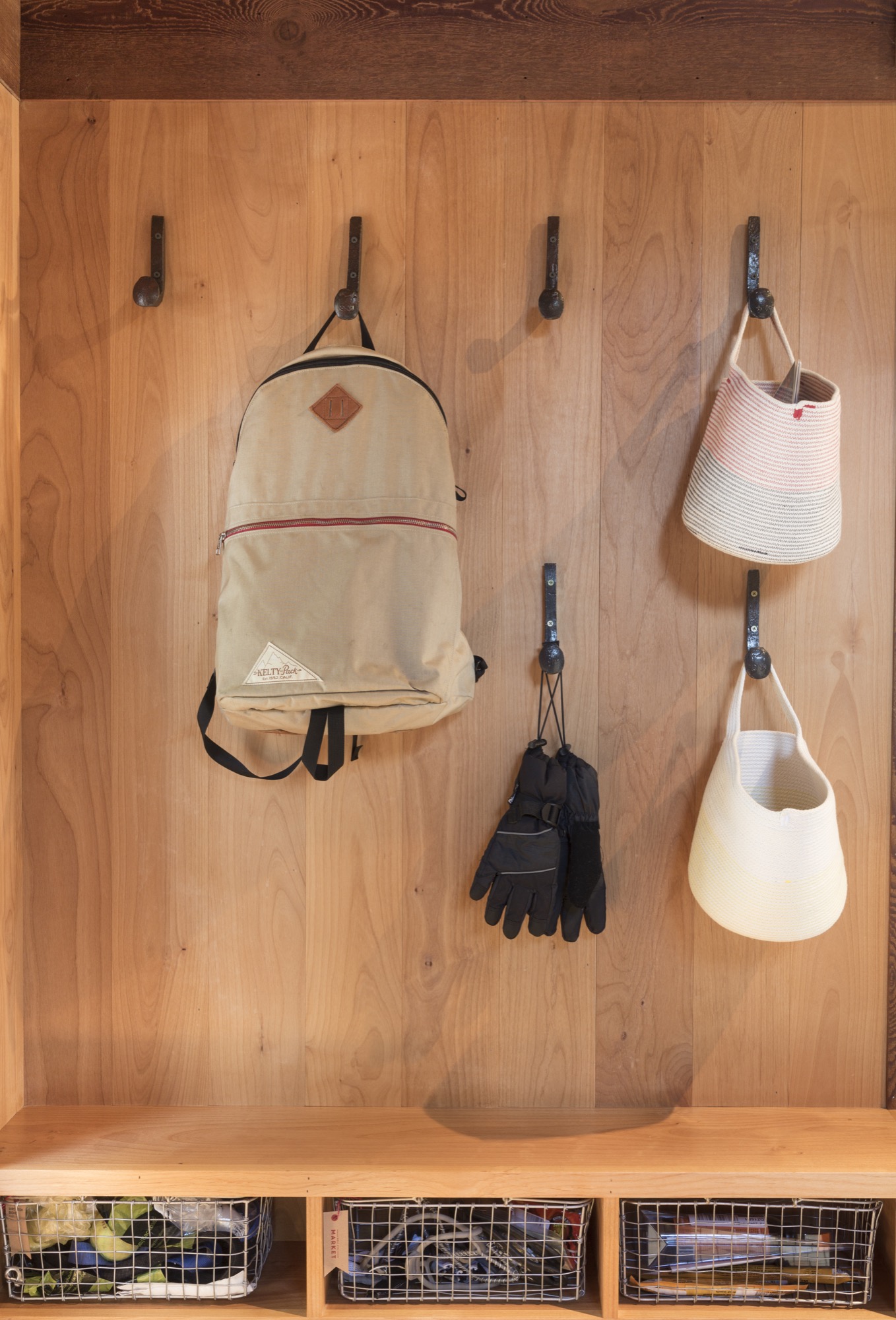
This play between vibrancy and calm, between old and new, between everyday and heirloom, is of particular interest to Bailey. “When I’m thinking of myself as a designer,” she says, “I think it’s important to create balance, and that can apply to everything. You’re trying to create a balance between a lot of different things—to make sure it’s making the right statement, the balance between doing something interesting and standing the test of time. Balancing utility with beauty—all those things you are trying to get right in the middle of, and if you do, then it does stand the test of time and meet its needs.” At the same time, “It is beautiful. To me, good design is taking all those things and striking the right balance.” △
Introducing: Alpine Modern's Chef Ellory
After traveling the world for a year, our new executive chef brings Nordic-alpine flavors and tales from around the globe to the kitchen at Boulder’s Alpine Modern Café
Ellory Blair Abels jumped into the food industry at the age of fifteen, when she began working in restaurants. After studying her passion at The Culinary Institute of America (CIA) in New York City, she accepted her first position with a catering company in a holistic retreat center in Upstate New York. With expanding industry experience, however, came the feeling something was missing. So the Houston, Texas native, who grew up in Atlanta, Georgia, packed her bags and traveled to expand her horizon—and her palate. Through this journey, her philosophy about food, life, and the kind of person she aspired to be has evolved. Immersing herself in different ways of life and seeing different countries has opened her eyes to a whole new vision of food as a celebration of life and culture.
Upon returning, she started afresh in San Francisco, where she found her cooking match: Ellory joined the lovely Lisa Chatham in her personal cheffing business, which together they expanded into the catering company Green Heart Foods. Over the course of four years, the business grew from two people to fifty employees and a café. With two production kitchens and another in the making, helping to build Green Heart Foods was a life-changing experience for the young culinary talent.
Then, in 2015, Ellory made one of the hardest decisions she’s ever made—to leave behind what she knew in San Francisco and explore the unknown. Going after a lifelong dream, she once again packed her bags; this time not knowing when she would return. She bought a one-way ticket to Peru and traveled to eight different countries in one year.
Ellory has recently returned to the United States to begin her next adventure in Colorado, where she says she is “beyond excited to join the amazing family of Alpine Modern.” Now she can’t wait to share what she has learned and seen over the past year through her food at the Alpine Modern Café in Boulder.
A conversation with Alpine Modern Executive Chef Ellory Abels
AM Who are you, in a nutshell?
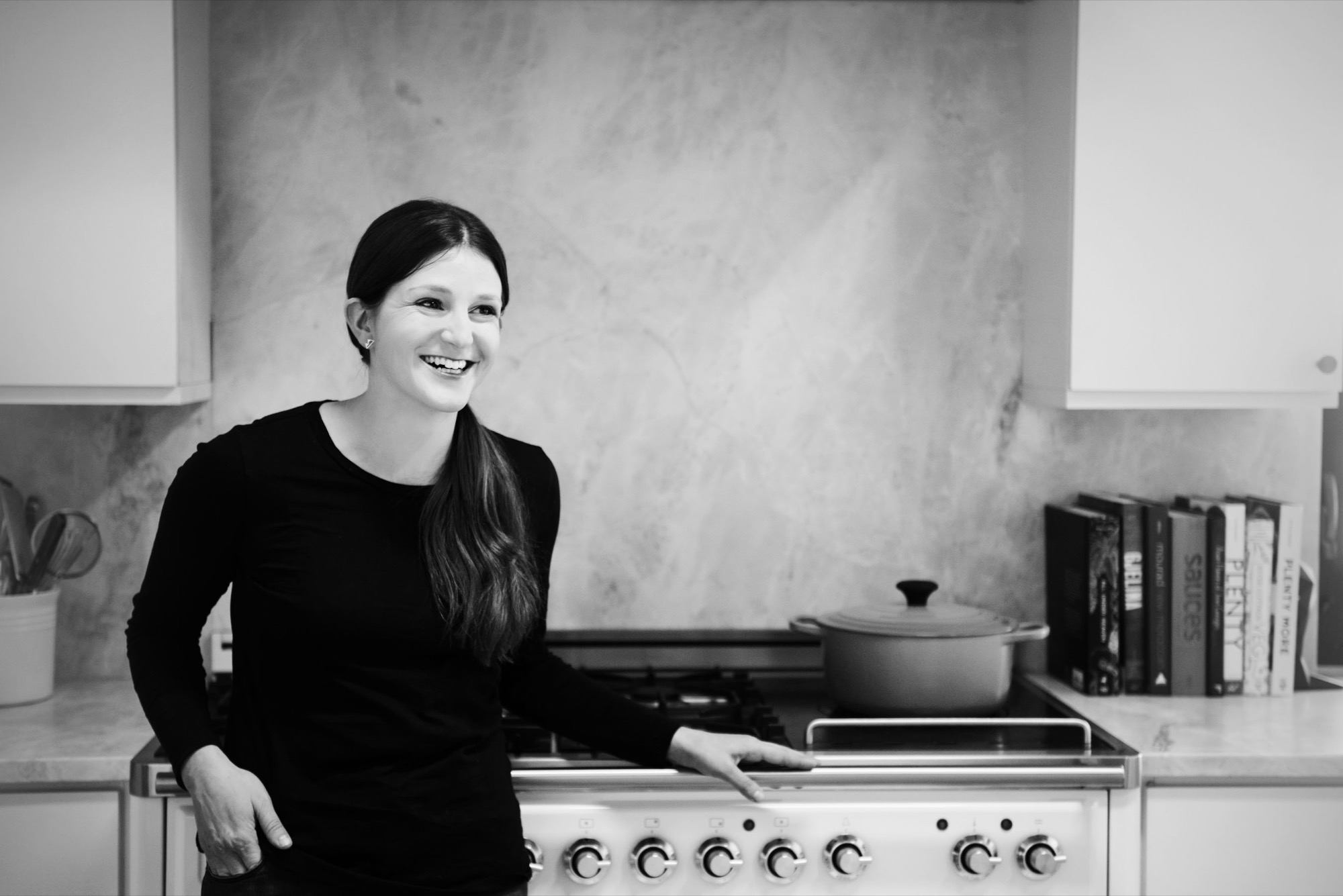
EA I am an opportunist. I’m always looking for ways to push the boundaries. I don’t like to live my life within the lines. I make my own rules and love to take risks. I am very curious and like to explore the questions of life. Besides that, I strive to live a simple life that’s not overly complicated. I take pride in surrounding myself with people I love and sharing memorable experiences with them.
AM Along your path, what experiences and encounters have made you who you are today?
EA Traveling! I have been lucky enough to have been able to travel pretty intensely from a very young age. Last year, I took a huge leap to leave the home I’ve made in San Francisco and explore the unknown. I decided to fulfill a lifelong dream of mine and travel longterm. I bought a one-way ticket to South America, with no plans other than to see all of the beauty the world has to offer. I explored eight different countries, two continents, and seven states in one year, collecting friends, stories, spices, and culinary techniques from every corner of the world.
It was the single most inspiring, eye-opening experience of my life and has shaped me as a person and as a chef. Traveling has definitely been my biggest teacher in life. The more I explore, the more my senses are awakened, and the more alive I feel.
“I explored eight different countries, two continents, and seven states in one year, collecting friends, stories, spices, and culinary techniques from every corner of the world.”
AM Share some of your childhood memories of food.
EA I grew up in a Jewish household where food was always the center of the event. My parents were amazing at exposing me to different ethnic foods from a very young age. Some of my favorite memories are cooking for the Jewish holidays and for Thanksgiving.
“I grew up in a Jewish household where food was always the center of the event.”
AM When and how did you know you wanted to become a chef?
From a young age, I was very determined to be an artist. I filled my spare time after school and my summers with a variety of art classes. My dream was to go to the Savannah College of Art and Design. Looking at the portfolio requirements to get in, however, I realized this was not what I wanted. I explored other ways to apply my creative ability. Food had always been a huge outlet for me. I grew up spending a lot of time cooking and experimenting in the kitchen with my dad. So I decided to put more effort into exploring the profession of food by working in different restaurants. After being involved in the food world for only a couple of months, it became very apparent that this was the path I wanted to take. Food is my own expression of art and is definitely my medium.
“Food is my own expression of art and is definitely my medium.”
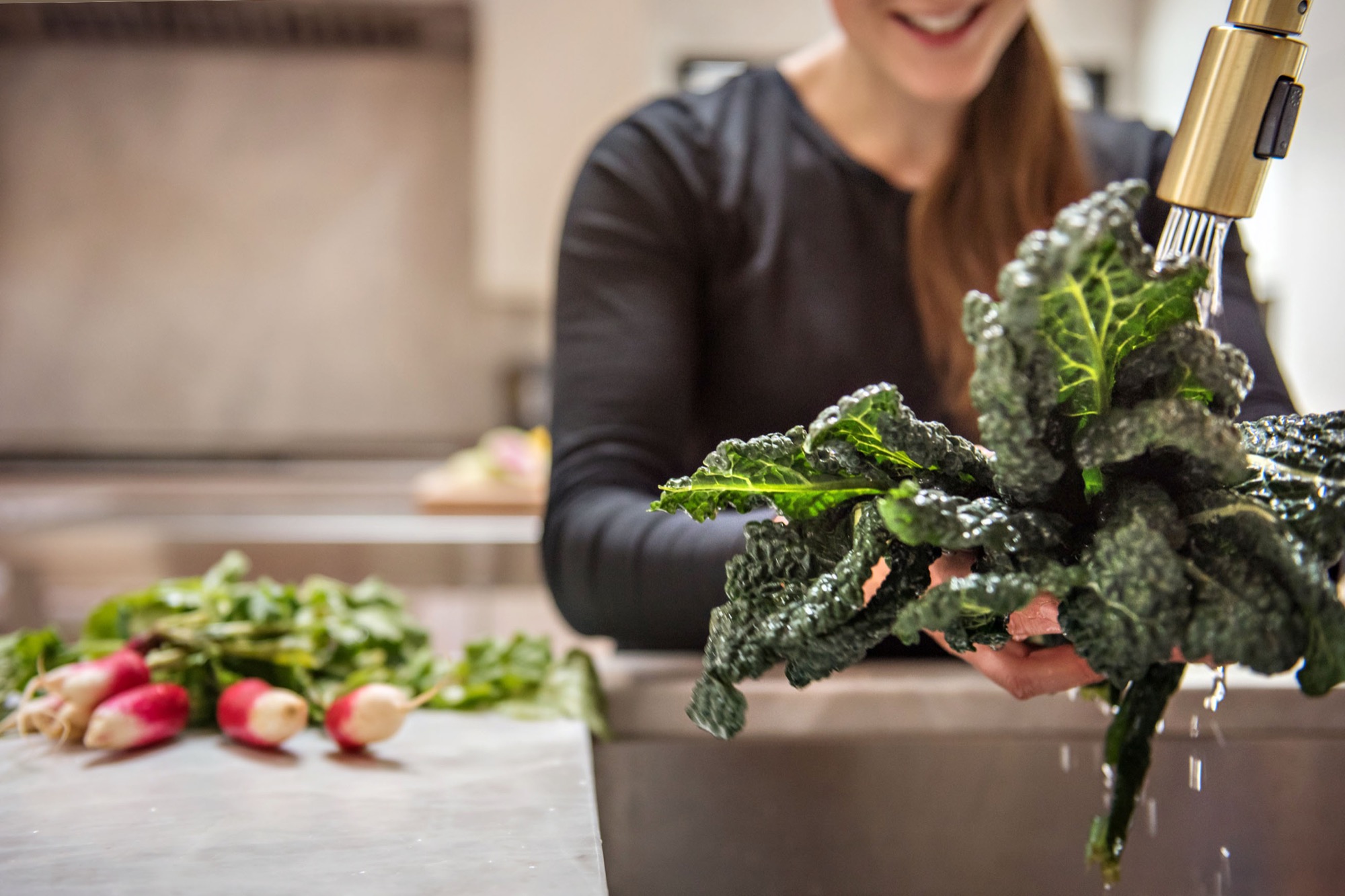
AM Who taught you how to cook?
EA My dad. He inspired me from a very young age to get into the kitchen. He also grew up working in a kitchen for the family diner in New Jersey, called “Abels Diner.” The dinner served a mix of comfort food and Jewish specialties. Listening to the many stories he has about growing up in the dinner has always inspired me and made me want to be involved in food. Fun fact… Frank Sinatra was a busboy for my grandfather’s diner. True story!
AM Who is your culinary icon? What do you admire about her or him?
EA Yotam Ottolenghi. I love his approach to food. His style and flavor profiles are very similar to what I love to cook. Israeli food is also one of my favorite cuisines to cook, and his cookbook Jerusalem is by far one of my favorites.
AM What’s your favorite food, and what do you love about it?
EA Hmm, that’s such a hard question. It really depends on the season and what trip I recently came back from that inspired me. I’ve been cooking a lot of curries from my most recent trip to India. It’s been fun to experiment with a lot of spices I brought back and to try to master the art of Indian cooking. Besides that, my go-to food to cook is probably Israeli food. I just love the mix of flavors and textures.
AM What culinary traditions are your methods and recipes rooted in?
EA Exploring food while traveling has shown me a variety of traditions, methods, and recipes that I bring into my own kitchen. I cherish these experiences and try to recreate them in my own version and share them with others along with the stories behind them.
“Exploring food while traveling has shown me a variety of traditions, methods, and recipes that I bring into my own kitchen.”
AM What’s your definition of good food?
EA Clean, simple, colorful, thoughtful, lots of love!
AM How do you translate Alpine Modern’s ethos of “quiet design” into your work at the Café in Boulder?
EA The food I create for Alpine Modern is clean and simple. It’s not overthought and shows off so much more by letting the ingredients speak for themself.
AM What’s your vision for Alpine Modern’s culinary future?
EA We have lots of exciting plans that are in the development phase. We’re trying to expand the experience Alpine Modern shares with it’s customers and bring the community together. One of the big changes is that we are now renting out the Café during after-hours for private events.
AM What’s your favorite place in the world, and why?
EA Tough question, but I’ll have to say, even with all of the amazing places I have visited around the world, nothing will ever beat Yosemite. No matter how many times I go there for an adventure, that place gives me goosebumps and brings the biggest beaming smile to my face. It’s just pure magic.
“Even with all of the amazing places I have visited around the world, nothing will ever beat Yosemite… It’s just pure magic.”
AM What makes you happy?
EA I’ve learned it’s the simple things in life that bring me the most joy. Being surrounded by my family and friends and living an active lifestyle that gets me outside everyday is my happy place in life.
AM What are you working on these days?
EA Lot’s of different things. I’m getting in training mode for climbing season to really try to get after it this year. I’m also in the process of developing new recipes, lots that are inspired by my recent travels. Besides that, I’m really putting a lot of focus on sticking around the states this year and spending lots of time with my family and friends and my pup, Chalten. △
